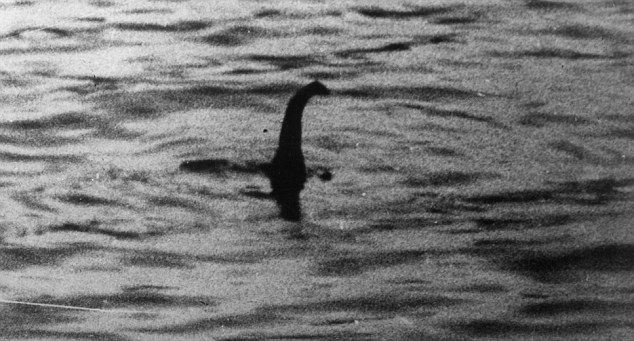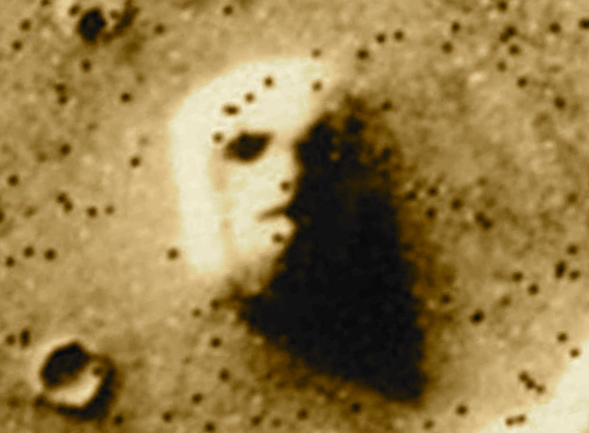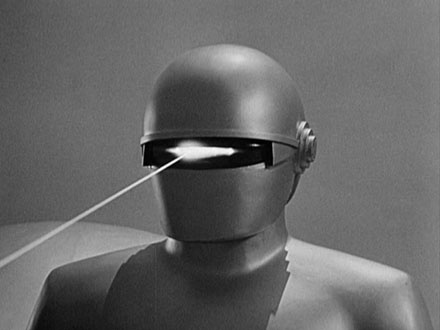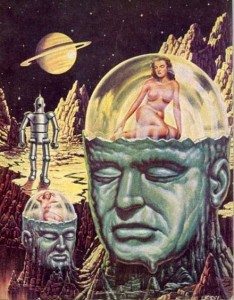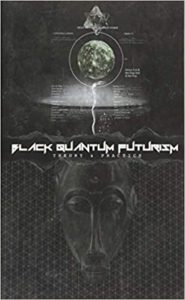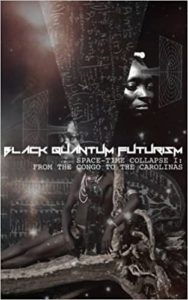The Nightshirt Sightings, Portents, Forebodings, Suspicions
Unknown Unknowns: Psi, Association & the Physics of Information
I have always been skeptical of parapsychologists, because their experiments and their theories borrow the standard concepts of space and time dimensions from physics. These concepts seem obsolete to me. They are not appropriate for understanding telepathy, or the moving of objects at a distance, or ghosts, or Melchizedek. I have always been struck also by the fact that energy and information are one and the same thing under two different aspects. Our physics professors teach us this; they they never draw the consequences. —Jacques Vallee
In his 1979 book Messengers of Deception, Jacques Vallee called for a “physics of information” that would enable scientists to think in a more nuanced way about a wide range of paranormal phenomena. Four decades later, it is an idea that is now strongly resonating with many UFO writers. The late Bruce Duensing had been thinking about the equivalence of energy and information on his blog, for example; and lately I see the phrase “physics of information” everywhere I turn. Vallee himself reiterated his call in a TED talk, “A Theory of Everything (Else)” a few years ago (linked below).
In absence of a nice, materialist-sounding theory, the behavior, or character, of psi becomes almost like an interaction with an omniscient intelligence.
What Vallee’s book (and TED talk) left mostly between the lines is that his idea for such a physics arose as much or more from his involvement with psi research in the 1970s as it did from his thinking about UFOs. As a friend and colleague of the CIA-funded researchers and psychics who were revolutionizing the study of psi at SRI, Vallee, whose day job at SRI in the early part of that decade was developing the Arpanet, was in the right place at the right time to cross-fertilize their work with his own wildly outside-the-box thinking. (If there’s anything studying UFOs can do to some people, it is removing the usual barriers to thought and creativity.) Vallee’s contribution to the field of psi was decisive, and his comment about a physics of information directly refers to that contribution.
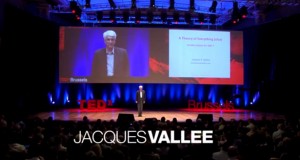 From the beginnings of psychical research in Frederic Myers’ day up until the early 1970s, psi was commonly (albeit not universally) assumed to work somehow on the model of telegraphic or radio transmission. This metaphor invokes the notion of a sender and receiver, and thus psi was generally thought to be fundamentally a connection between minds—that is, telepathy. The early research at SRI proceeded on this assumption. At SRI, the early protocol in what came to be called “remote viewing” was to use an “outbounder” as a psychic transmitter—that is, a confederate who went to a randomly determined location in the Bay Area while the psychic back at the lab described what they were seeing.
From the beginnings of psychical research in Frederic Myers’ day up until the early 1970s, psi was commonly (albeit not universally) assumed to work somehow on the model of telegraphic or radio transmission. This metaphor invokes the notion of a sender and receiver, and thus psi was generally thought to be fundamentally a connection between minds—that is, telepathy. The early research at SRI proceeded on this assumption. At SRI, the early protocol in what came to be called “remote viewing” was to use an “outbounder” as a psychic transmitter—that is, a confederate who went to a randomly determined location in the Bay Area while the psychic back at the lab described what they were seeing.
The SRI team was at that time struggling with how to make this form of clairvoyance more suitable to real-world intelligence applications, and they were forced to adjust their operating assumptions to a growing realization that it didn’t actually operate by known physical principles, or via anything like telepathy. They could find no electromagnetic force at work and no “inverse square law” that diminished ESP or psychokinesis (PK) over distance, and psi effects seemed to ignore any form of electromagnetic shielding. Another blow to the “telepathy” concept came from New York artist/psychic Ingo Swann, who brought to the team a different model of how psi operated—not as telepathy but as some discarnate part of consciousness leaving the body and seeing things at a distance.
In his own previous work with ESP researchers in New York, Swann had traveled out of body to view concealed objects, and thus his assumption was that a psychic didn’t need another person as a sender of the information; the psychic could theoretically just “go there” and see the target in his/her mind. This worked so long as you knew where you were trying to go psychically; but the protocols at SRI demanded the psychic be blind to what and where the target was. How could the psychic know where to send his or her consciousness, or find the needed information, without something concrete to home in on?
Here is where Vallee, with his experience in the problem of accessing information in the virtual, dimensionless world of a computer database, was able to offer Swann a key piece of insight: thinking of psi information in terms of “addressing.” Vallee thus suggested to Swann using geographic coordinates to designate the target.* Swann saw the logic of this, and (according to Jim Schnabel’s account in his book Remote Viewers) initially waged an uphill battle convincing Hal Puthoff and the other SRI folks to experiment with using coordinates. The tries were a success, and thus “coordinate remote viewing” or CRV was born—the methodology that became the military protocol refined and taught by Swann to the first generation of military remote viewers over the subsequent decade.
Just Say “Target”
The leap initiated by Vallee and Swann should not be underestimated. The logic of using coordinates is really an ‘illogic,’ with any moment’s thought about the problem: Geographic coordinates are a purely human construct with no objective link to places on the globe; they are an arbitrary informational overlay. It is an example, in fact, of the arbitrary connection between words and things that forms the basis of structural linguistics—the signifier bears no necessary connection to the signified; linguistic meaning is a function of how signifiers relate to each other, as in a vast grid system, not how they relate to actual things in the real world. We are thus able to use words grammatically correctly even before we know what they refer to; the way they connect in our minds to actual things depends instead on associative linkages, built up and reinforced across early life (and later) experience (I’ll return to this below).
The notion that the psychic apparatus can seek and find “the right answer” based on an arbitrary signifier is another version of the basic stone of offense that prevents skeptics from accepting psi on principle: Where is the psychic getting their information?
The arbitrariness of map coordinates produces a special conundrum when applied to psi in the way Vallee was suggesting: If given a set of map coordinates, the viewer theoretically and ideally has no idea what those coordinates relate to. It’s like being asked to go get a chapeau if you know no word of French. How, then, does the psychic apparatus “know” to go to the right place? Yet amazingly, and illogically, the SRI researchers found that using coordinates worked just as well as using a human outbounder. Somehow, the psychic apparatus did know where to access the requested information, even though the viewer possessed no conscious knowledge (at least with any precision) of Earth coordinates.
Eventually, given the remote but plausible idea that viewers could make guesses about the target based on having memorized the earth’s geographical coordinates (perhaps through months and years of CRV practice), coordinates were replaced by even more arbitrary symbol or number systems. As Schnabel records, SRI remote viewer Keith Harary at one point exasperatedly said to Puthoff, “Why don’t you just say ‘target’?” Indeed, just saying ’target’ worked as well as coordinates or random numbers. The psychic apparatus still knows where to seek and find the information even with the barest minimum of a signifier designating the information sought. (Consequently, the “C” in CRV eventually came to stand for “controlled” rather than “coordinate,” to reflect that military viewers departed from the coordinate system in favor of even more arbitrary codenames.)
 What, then, is the word “target” or an arbitrary codename standing for? If it is simply marking or registering the intent of an assigning officer, it raises the question whether remote viewing still involves, or is even mainly, a form of telepathy—that is, connecting, via that codeword, to the intentions of a distant, unknown person who does know where the target is, rather the same way a psychometrician might handle a cigarette lighter and provide information about its owner. Or, does “target” register or mark something more abstract in the nonlocal psychic database, like “the right answer” or “the correct target”? Does it even serve a purpose, or is it just a kind of empty ritual in the whole process?
What, then, is the word “target” or an arbitrary codename standing for? If it is simply marking or registering the intent of an assigning officer, it raises the question whether remote viewing still involves, or is even mainly, a form of telepathy—that is, connecting, via that codeword, to the intentions of a distant, unknown person who does know where the target is, rather the same way a psychometrician might handle a cigarette lighter and provide information about its owner. Or, does “target” register or mark something more abstract in the nonlocal psychic database, like “the right answer” or “the correct target”? Does it even serve a purpose, or is it just a kind of empty ritual in the whole process?
The notion that the psychic apparatus can seek and find “the right answer” based on an arbitrary signifier is another version of the basic stone of offense that prevents many people, especially hardcore skeptics, from accepting psi on principle: Where is the psychic getting their information? The persistence of the electromagnetic theory, or the concept of an “energy” being transmitted through space, at least held out the possibility that psi had a rational basis that might one day be assimilated within our understanding of physical laws. But the SRI work, in various ways, undid those notions and left psi without any firm footing, even as it resulted in an actual method that could be taught and applied in real-world settings. In absence of a nice, materialist-sounding theory, the behavior, or character, of psi becomes almost like an interaction with an omniscient intelligence.
Traversing Events by Association
So, it is partly this situation and realization—that information is structured in the universe such that it can be accessed through arbitrary symbols—that Vallee meant by a physics of information that would replace our everyday physics of space and time conceived as dimensions. Cartesian coordinates (which he astutely notes are probably conceptual artifacts of graph paper) are inadequate for accessing data on a computer network. Information is scattered randomly and in fragmentary fashion in such systems and must be accessed through addressing schemes and algorithms that home in probabilistically on the required data. Search terms connect to this information associatively.
Synchronicities and remote viewing both share the central mystery of meaning: How can the Universe know our own intentions, thoughts, needs, etc.?
He suggests that the problem of accessing information in psychic space via association is directly related to a more familiar problem experienced even by non-psychics, the meaningful coincidences Jung called “synchronicity.” During the period leading up to Messengers, Vallee experienced a real doozy, which shook his prior assumptions about causality to the core. After seeing the name Melchizedek scrawled on the Paris metro, Vallee learned that the name (Abraham’s teacher in the Old Testament) referred to a UFO group, which turned out to have members even in California, where he was then living. He then devoted a great deal of work to this and other groups and their beliefs about UFO contact. Then, the week when he started compiling his notes on Melchizedek and writing Messengers, he was given a cab ride in LA, and when he later looked at the receipt the driver had given him, it said “Melchizedek.” There was only one person with that surname in the LA phone directory. Unless someone or something was staging an elaborate hoax to screw with him, the odds against that one person driving the cab he happened to hail on an LA street are impossible to calculate but must be astronomical.
 Creative work invites small synchronicities, almost to the point where I consider it its own variety of the phenomenon. Even in the course of writing this post, I experienced an intense perfect storm of “research synchronicities” in which previously unread books or previously unseen web pages magically fell open to the exact information I needed and/or took me down some personally significant rabbit hole. Any creative writer or artist knows this experience, and may even come to take these things for granted. However, synchronicities of the scope of Vallee’s Melchizedek are rarer and may be life-altering. Jeffrey Kripal, who visited Vallee’s home while researching a chapter on him for his book Authors of the Impossible, notes that Vallee had built a series of five stained glass windows in his study honoring his life’s passions; one of them depicts the Biblical Melchizedek. (As I suggested in a previous post, honoring our synchronicities has the effect of connecting with the thread of our enjoyment and setting up the expectation of coincidence, which increases their frequency.)
Creative work invites small synchronicities, almost to the point where I consider it its own variety of the phenomenon. Even in the course of writing this post, I experienced an intense perfect storm of “research synchronicities” in which previously unread books or previously unseen web pages magically fell open to the exact information I needed and/or took me down some personally significant rabbit hole. Any creative writer or artist knows this experience, and may even come to take these things for granted. However, synchronicities of the scope of Vallee’s Melchizedek are rarer and may be life-altering. Jeffrey Kripal, who visited Vallee’s home while researching a chapter on him for his book Authors of the Impossible, notes that Vallee had built a series of five stained glass windows in his study honoring his life’s passions; one of them depicts the Biblical Melchizedek. (As I suggested in a previous post, honoring our synchronicities has the effect of connecting with the thread of our enjoyment and setting up the expectation of coincidence, which increases their frequency.)
Synchronicities like Melchizedek and remote viewing within the new nonlocal paradigm of Vallee’s SRI friends both share the central mystery of meaning: How can the Universe know our own intentions, thoughts, needs, etc.? There is something outrageously “godlike” about synchronicity, and the extent to which we are awed (and confused) by such occurrences attests to our unwillingness to leave it all up to God or some higher intelligence.
In Messengers, Vallee gave a fascinating taste of what a physics of information would entail, and how it might link up his various interests:
If there is no time dimension as we usually assume there is, we may be traversing events by association. Modern computers retrieve information associatively. You “evoke” the desired records by using keywords, words of power: you request the intersection of “microwave” and “headache,” and you find twenty articles you never suspected existed. Perhaps I had unconsciously posted such a request on some psychic bulletin board with the keyword “Melchizedek.” If we live in the associative universe of the software scientist rather than the sequential universe of the spacetime physicist, then miracles are no longer irrational events. The philosophy we could derive would be closer to Islamic “Occasionalism” than to the Cartesian or Newtonian universe. And a new theory of information would have to be built. Such a theory might have interesting things to say about communication with the denizens of other physical realities.
The Universe as Dream
Information is only information to a thinking being. Thus there can be no abstract, objective physics of information; rather, such a physics would be a sort of epistemology, the study of knowledge and how we know, and how it inevitably relates to a subjective knower. This inevitably leads to the question of consciousness and its relation to matter (including the brain).
The fact that synchronicities and UFO phenomana so strongly reflect an associative (rather than causal) logic tells us—and early on, told Vallee—that they cannot be regarded solely as matters of objective reality.
The notion that we exist in a nonlocal quantum field of information that fundamentally has no spaciotemporal dimensionality at all is widely accepted in the physics community as well as among today’s psi researchers, and thus is destined to transform the brain sciences and psychology as well (even if the psychologists need to be dragged into the new paradigm kicking and screaming). The physicalist presumption that consciousness arises from brain activity cannot be supported either philosophically or empirically (as any number of writers have lately pointed out). And for the most part, information may not in fact be “stored” in the brain as representations, despite our habit of thinking about it as a memory bank.
Yet, the brain is undeniably central in our embodied experience of being alive, either as a mediator between consciousness and events unfolding in physical reality (for instance as a “receiver,” although that partakes of a metaphor that is becoming increasingly obsolete) or, in Bernardo Kastrup’s terms, as an “image” of the localization of our egoic experience within the larger field of consciousness. Whatever the case, I suspect that a future Quantum Neuroscience may come to understand the brain as a system of finding needed information from the larger nonlocal quantum field—that is, it is an information registration or accession system, like a card catalogue in a library or, just as Vallee anticipated, a search system in a computer network. (Or, it will be seen as the ‘image’ of such a system.)
What occurrences like Melchizedek seem to suggest is that the structure of time and causality as we experience them are dictated by the associative linkages among symbolic information. The universe of potential things to know, potential information, may be “out there” in the nonlocal field, but our brains are the gateway to it, because our neural architecture contains the accessing scheme. The study of dreaming and the ancient punny, associative, and spatially organized “art of memory” provide much insight into how this scheme functions and is created and maintained.
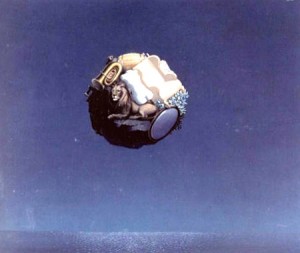 Dreaming is essentially the art of memory operating automatically while we sleep, although it probably also goes on continuously below the level of conscious awareness even during waking hours. I have described this elsewhere as “making new memories” although it would probably be more accurate (following the recent work of Sue Llewellyn) to say “making associative junctions.” Those junctions not only help us access mnemonic information (wherever it actually resides) and, more often, cobble-together good-enough reconstructions of past events with a liberal dosing of schematic “frog DNA” to make it seem and feel complete and accurate. These junctions also keep events in our lives bundled together to preserve an adequately accurate internal chronology. In the absence of an objective temporal yardstick, keeping events that happened together associated with each other is the only way we can preserve a sense of our own biography and, thus, sense of self.
Dreaming is essentially the art of memory operating automatically while we sleep, although it probably also goes on continuously below the level of conscious awareness even during waking hours. I have described this elsewhere as “making new memories” although it would probably be more accurate (following the recent work of Sue Llewellyn) to say “making associative junctions.” Those junctions not only help us access mnemonic information (wherever it actually resides) and, more often, cobble-together good-enough reconstructions of past events with a liberal dosing of schematic “frog DNA” to make it seem and feel complete and accurate. These junctions also keep events in our lives bundled together to preserve an adequately accurate internal chronology. In the absence of an objective temporal yardstick, keeping events that happened together associated with each other is the only way we can preserve a sense of our own biography and, thus, sense of self.
In searching our memories for information, we do precisely what Vallee described: we “traverse events by association.” Those associations operate exactly the way Freud described in his work on dreams: They are often non-logical, governed by root metaphors that are often highly concrete (even superstitiously simple-minded), and operate by puns and various literary devices and tropes—precisely the logic of surrealism, myth, and folklore. And they are situated in distinct spatial environments that are often familiar or related to the environments of our early life and formative years. As I argued in my “Feeding the Psi God” post, precognitive dreaming appears to create associative memory junctions for future experiences in precisely the same way.
The fact that not only synchronicities but also UFO phenomena so strongly reflect precisely such an associative (rather than causal) logic tells us—and early on, told Vallee—that they cannot be regarded solely as matters of objective reality. The psyche of the witness is inextricably entwined with whatever is happening to him/her on an objective level. It could be that technology is interacting with and stimulating their associative neural networks to produce a certain experience; it could be that alien beings or technology somehow navigate a psychic interspace; or it could be that, to make sense of a fundamentally baffling experience, the witness is forced to draw upon deep cultural and personal associations. It could be all of these things. Duensing’s blog, A Transit of Contingencies, is essentially a prolonged, dense, but rewarding meditation on these possibilities. (A recent Radio Mysterioso tribute conversation with Duensing afficionados “Burnt State” and “Red Pill Junkie” is a good, accessible exegesis of Duensing’s ideas.)
Before Vallee, Carl Jung insightfully saw the psychic connection or dimension of UFOs, regarding them as linked in some way to the collective unconscious. The folkloric dimensions of UFO encounters certainly speak to the shared nature of basic cultural symbolism within communities. But the most fundamental symbols in our lives—the most effective “power words” in our associative mental registry—are always those that feel most unique to us, even if we happen to share those symbols with others or, indeed, with the whole human race.
There’s a large body of anthropological research on the way shared symbols become powerfully personal and motivating by linking to our personal psychosexual lives, and it is why Freud remains hugely influential in anthropology (probably the only place in science, anymore, that he is still read), whereas Jung, despite taking such a deep interest in myth, is not. The motivating power of symbols, be they simple arbitrary signifiers like “chapeau” (or “target”) on up to core religious and cosmological motifs, is not automatic and mechanical, emanating from some collective psychic interspace that precedes us, but is highly idiosyncratic and, in the case of religious symbolism, built up through emotionally moving religious (and, I would add, paranormal) experiences in our lives. The unconscious, where our associatively linked symbols are active, is consequently a deeply private, personal place.
This matters, because it affects how we understand our relationship to distant or nonlocal information if our brain is indeed a search engine. The fact that the associations used by our search system are built up through life experience may in the end be all the difference between the future and the past: the past—or, one’s own past—is that which has been accessioned, like a library or museum collection. It is that accessioned stuff that must provide the initial breadcrumb trail of associations leading us to the new and unfamiliar. (It also suggests why research with UFO witnesses must be, as Vallee suggests, a process, unfolding over time, to excavate personal meanings and associations, not unlike a psychotherapeutic relationship.)
The Eyes of Heisenberg
There may be no physical spaciotemporal barrier to accessing all information, anywhere, anytime; as information formations, we are all made of the same stuff. There’s no real discontinuity between “me, here, now” and what’s happening on Gliese 667c, or what will happen there in a million years. But in order to find out what is happening there and then, I must be able to formulate a question—what I want to know—in precise enough terms to retrieve an answer from the cosmic database. That’s tough, because I don’t know what I don’t know; and, I wouldn’t recognize the needed information if I did retrieve it, or have any way to judge its accuracy.
Psi may only be functional—and useful—when the psychic eventually has an experience that definitively confirms or disconfirms whether or not he/she “got it right.”
This happens to be the basic epistemological quandary that led Plato to conclude that all learning is actually remembering, or anamnesis. Basically, we don’t know what we don’t know, so there is no way to know something new that we didn’t already know before, in a previous life. This would fit pretty well with today’s consciousness-centric philosophies like Kastrup’s—that the self with its brain-image is a “dissociated alter” of a larger singular all-knowing “Mind at Large”; everything we don’t know is really what we have forgotten we know or forgotten we could know, if we only knew how to ask.
It also suggests why psi may only be functional—and useful—when the psychic eventually has an opportunity to make a physical observation or otherwise have an experience that definitively confirms or disconfirms whether or not he/she “got it right.” It has been suggested that even what seems like remote viewing could in fact be precognitively seeing something like “the right answer” as it is confirmed during a feedback session at a later time—what I described elsewhere as the “scene of confirmation.” Psi researchers Edwin May and Sonali Bhatt Marwaha have suggested that all psi experiences are precognitive, and Vallee raised this possibility after a talk at the 2007 IRVA conference. It would indeed reduce some of the mystery about how we locate and access psychic information: Instead of somehow finding and accessing information omnisciently from the entire nonlocal quantum field, the psychic could be just drawing information from a single channel, a scene in his or her own future that is/will be linked by memory association to the remote viewing session itself.
Psychic experiences that are not confirmed are, well, not confirmed, and one must beware of circular or tautological psychic claims, of which there are many. The great pitfall claiming the minds and careers of some of the original Star Gate viewers seems to have been attempting to view uncorrelated (or unconfirmable) targets like UFOs or historical events like the Crucifixion. There seems to be even something Heisenberg-like about psychic information: It doesn’t count as true or false—and thus, doesn’t really exist as “information”—unless and until some real state of affairs is observed physically by the psychic him- or herself.
As I have argued, the precognition theory can also explain synchronicity. Insofar as we are ignorant of the functioning of precognition in our lives (the crucial Lacanian dimension of misrecognition), we would dissociate from, disavow, or more generally just misattribute and misinterpret information that came to us via this channel. The same way that subliminally or unconsciously acquired insight and knowledge can be misattributed to another intelligence interacting with us, future information would be misattributed to present or past circumstances—the “temporal bias”—and in certain extreme cases this would produce jarring experiences of “meaningful coincidence”: a feeling that the cosmos had stage-managed events to provide some indication to us or give us needed information.
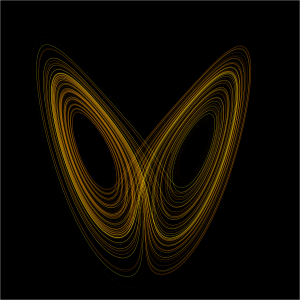 Even with Melchizedek, the “time-loop amplification” model I proposed could explain it: In other words, the amazing experience of reading a cab receipt with the name Melchizedek on it could have primed Vallee, months or years earlier, to notice that name on a Paris metro wall. The name on the receipt would have been “amazing” (and thus sent ripples back in time along the resonating string of his creative jouissance) because of the intellectually exciting intervening life events (researching the Melchizedek group, etc.), which unfolded because of that priming.
Even with Melchizedek, the “time-loop amplification” model I proposed could explain it: In other words, the amazing experience of reading a cab receipt with the name Melchizedek on it could have primed Vallee, months or years earlier, to notice that name on a Paris metro wall. The name on the receipt would have been “amazing” (and thus sent ripples back in time along the resonating string of his creative jouissance) because of the intellectually exciting intervening life events (researching the Melchizedek group, etc.), which unfolded because of that priming.
As preposterous as they sound on the surface, such time-loop structures must exist if information can travel through time and influence the past, because our resulting actions would have to be able to feed back on that future information (or else negate it, which is probably the more likely outcome—the other butterfly wing of the strange attractor in the dynamic systems space of psi). Jung was right to call synchronicity “acausal” if we take that to mean this kind of tautological chicken-and-egg logic. In his TED talk, Vallee himself invoked a similar “double causation” synchronicity theory advanced by Philippe Guillemant: “Our intentions cause effects in the future that become the future causes of present effects.” A meaningful nexus like “Melchizedek” may be a kind of symptom-vortex acting as an attractor for a person’s unconscious jouissance—or what in Lacanian terms is called a “symptom.”
Physics of Omnipotence
Quantum physics leads tentatively to the conclusion that we are potentially omnipotent as well as omniscient, given the necessary role of conscious observation in collapsing wave functions and thus converting possibilities to actualities. The $64,000 question is, does psi “observation” by itself have a similar effect? Is following that breadcrumb trail of tokens and search terms—or traversing events by association—just accessing information via the brain’s associative search engine (associations built up over a lifetime of idiosyncratic experience and dreaming), or is it also co-creating the reality it is searching for?
is following that breadcrumb trail of tokens and search terms—or traversing events by association—just accessing information via the brain’s associative search engine, or is it also co-creating the reality it is searching for?
One possibility I’ve raised previously is that the difference between psychic perception and embodied observation might be that the former only “sees/knows” certain probable or likely outcomes in a still-indeterminate condition of Quantum superposition. This seems likely to me, because otherwise precognition would actually amplify determinism, collapsing the wave functions in front of you and thus solidifying your fate. Viewing the future psychically, I propose, should not be able to force it to come true (I shouldn’t think). Thus here again, it really all comes down to those “scenes of confirmation”—the physical observation of outcomes. Such scenes may play a crucial role in the circuit of psi and the manifestation of our psychic intentions. It also raises questions about the real mechanism at work in, for example, cases of PK and psychic healing. Are intentions really acting at a distance in the present, or are they actually leading us to collapse wave functions at a future scene of confirmation, as in the precognition model of ESP/remote viewing?
If the latter is the case, it could explain a lot of baffling problems in science, like the tendency not only in psi research but in all research for results to conform to experimenter expectation (I’ll return to this in future posts). And again, this idea might also illuminate why psi leads to such a quagmire of deception and paranoia when it is deployed against “uncorrelated targets” like alien intelligences, UFOs, or the Loch Ness Monster.
Tangentially, this notion could also unify my “psychic astronauts” and “noöverse” hypotheses. Any psychic exploration of spacetime might require embodied machine proxies to help conscious beings back home confirm and thus assist in the waveform collapse that makes psychic “seeing” (not to mention world-creation) reliable. If some subset of UFOs are, as I have speculated, nonsentient drones, they may nevertheless be an essential component in somebody somewhere’s “psychic space program” (or, perhaps, “psychic dimensional program”).
* Jim Schnabel’s book Remote Viewers omits Vallee’s crucial contribution, the use of geographical coordinates as an addressing scheme, claiming instead that Swann thought up the idea himself one day while lying by the pool. Vallee’s more detailed and, I am sure, more trustworthy account appears in his Forbidden Science, Vol. 2; he also discusses it in his IRVA talk.
Strange Animals in the House of Knowledge: On Forteans & Paranoia
Scientists always seek better ways of aligning their categories with what they take to be preexisting ruptures or boundaries in nature—the idea of “carving nature at its joints.” I love that phrase, because I have always been troubled specifically in certain divey Chinese restaurants when I see a fowl like a chicken or duck being cleaved contrarily to my Western understanding of anatomy, like through the middle of a leg or horizontally across the middle of the breast. Asian cooks seem to follow a completely different conceptual map of the animal, one that pays much less attention to skeletal structure—and joints—than I would.
It always reminds me of Borges’ fictitious Chinese encyclopedia, the Celestial Emporium of Benevolent Knowledge, in which animals are divided into the following categories:
Those that belong to the emperor
Embalmed ones
Those that are trained
Suckling pigs
Mermaids (or Sirens)
Fabulous ones
Stray dogs
Those that are included in this classification
Those that tremble as if they were mad
Innumerable ones
Those drawn with a very fine camel hair brush
Et cetera
Those that have just broken the flower vase
Those that, at a distance, resemble flies
“Paranoia” is in some sense just an unkind diagnostic epithet for people who draw connections that cut across hallowed cultural boundaries, connections that others cannot or do not wish to see.
This mad classification system is jarring (and funny) because it upsets our implicit Western understanding of logic, which is based on exclusive categories and nested sets, not sets that inevitably overlap (such as “belonging to the Emperor” and “Those that have just broken the flower vase”). Borges’ encyclopedia inspired the structuralist philosopher-historian Michel Foucault to write a whole book, The Order of Things, about the slowly shifting conditions of discourse that define knowledge in a given culture and time, or what he calls an episteme. Thinking about our own cultural categories, and what is thinkable and speakable within them, is crucial for understanding the marginal position of Fortean and paranormal topics within the modern, Western episteme.
 The paranormal, as George Hansen
The paranormal, as George Hansen has shown, consists specifically of boundary-crossing things, things that fall in our cultural cracks. These cracks are dangerous and dirty. He cites anthropologist Mary Douglas, who described how whatever transgresses boundaries or doesn’t stick within the confines of our familiar conceptual fences is experienced with revulsion. For instance, pigs were regarded as unclean by the ancient Hebrews because they were cloven hooved, like cows, yet did not chew a cud; it violated their cultural logic. Or, something as innocent as soil may be experienced as disgusting or repellant (i.e., as “dirt”) when it is tracked into a modern home, because it then violates the implicit boundary between “nature” and “culture.” (Protestants and other clean-freaks often respond to stray dirt in an apoplectic manner unbefitting its objective harmlessness.)
Fortean topics are perfect examples of the repulsive aura that surrounds boundary-crossing subjects. UFOs and ESP and Bigfoot, when talked about seriously, are repugnant to the mainstream mind, and mentioning them can put people off on a very fundamental level. There is some way in which these topics, in their inappropriate betwixt-and-between-ness, resemble private or even shameful bodily functions, or indeed dirt. This is beautifully depicted in Close Encounters, when UFO witness Roy Neary crazily drags dirt and plants into the family living room to assemble his Devil’s Tower model, as the neighbors look on in pity. The more we Forteans and anomalists display our strange, transgressive obsessions, the more the world shuns us as unclean, for reasons that are deeply epistemological. Thus being a Fortean can be socially (or at least, intellectually) isolating.
The Paranormal and Paranoia
People are repelled by margins, and they also distrust those whose minds are comfortable dwelling there. “Paranoia” is in some sense just an unkind diagnostic epithet for people who draw connections that cut across hallowed cultural boundaries, connections that others cannot or do not wish to see.
Nash himself said “I wouldn’t have had good scientific ideas if I had thought more normally.”
It goes without saying that there is a lot of paranoia in the Fortean world. As Hansen shows, paranormal topics tend to lead to paranoid thinking in those who go down the rabbit hole of UFOs, parapsychology, cryptozoology, and related areas of interest, although there is also a factor of self-selection: People who appear to be made paranoid by the study of the paranormal may have been in some sense paranoid to begin with; a nicer way of saying this, though, is that they start out open-minded and intellectually curious. In the cross-cutting demographic that attends to anomalies, you get a lot of people whose minds make connections that other minds don’t. Forteans, unlike more mainstream thinkers, allow their minds to “go there,” wherever “there” may be.
 Scientific geniuses and artists are often pattern-seers too. Theories are patterns; new theories are made by people who have a knack for discerning them. When newly perceived patterns can be supported scientifically, it can push a field in new directions and rearrange our existing categories in ways that previously might have seemed as illogical as Borges’ encyclopedia. Thus to some extent, paranoia is always relative, defined in terms of a given episteme or paradigm. It is not often enough mentioned that great scientific theorists are usually guilty of creating some bad theories amid their better-known solid ones. A certain amount of theoretical ‘pareidolia’—if not true paranoia—just goes with the ‘genius’ territory.
Scientific geniuses and artists are often pattern-seers too. Theories are patterns; new theories are made by people who have a knack for discerning them. When newly perceived patterns can be supported scientifically, it can push a field in new directions and rearrange our existing categories in ways that previously might have seemed as illogical as Borges’ encyclopedia. Thus to some extent, paranoia is always relative, defined in terms of a given episteme or paradigm. It is not often enough mentioned that great scientific theorists are usually guilty of creating some bad theories amid their better-known solid ones. A certain amount of theoretical ‘pareidolia’—if not true paranoia—just goes with the ‘genius’ territory.
I was reminded of this a couple weeks ago with the sad death of John Nash and his wife in a taxicab accident. Nash, the Nobel-winning mathematician immortalized in A Beautiful Mind, also suffered from paranoid schizophrenia, and among his ‘delusions’ was the belief that aliens were attempting to communicate with him via The New York Times. It is an important reminder that you frequently can’t have penetrating insight without a degree of wild imagination (some would say lunacy, but who am I to say he wasn’t being contacted by aliens via the newspaper?). Nash himself said “I wouldn’t have had good scientific ideas if I had thought more normally.”
Us and Them
Yet even if we philosophically acknowledge Indra’s net, the ultimate interconnectedness of all things, some pattern-seeing is too much an affront to reason to be helpful or useful. And it can serve to perpetuate the social marginalization of Forteans, and this marginalization can in turn contribute to paranoia, in a kind of feedback loop. Being isolated both individually and as a (small) group makes it difficult to triangulate ideas and apply proper critical distance, creating a perfect breeding ground for the creeping seeing of (probably) illusory connections.
Forteans often contribute to their own exclusion by taking an antagonistic attitude to the mainstream.
I recently I wrote about Mars anomalies, for example: While there are a handful that are genuinely perplexing (including, I am now re-persuaded, the famous “face”), these are tainted by a vast array of items that range from the absurd to the sad, such as “cities” feverishly discovered in photographic compression artifacts or plainly ridiculous “animals” somehow wandering about the frigid Martian surface. A failure to exercise critical discernment, coupled occasionally with a truly well-intentioned and democratic “anything goes” attitude on such sites, effectively exiles the entire subject from any serious consideration by the mainstream.
 Forteans often further contribute to this problem of cultural exclusion by taking an antagonistic attitude to the mainstream, bitterly transforming the marginality of our areas of interest into some kind of conspiracy by the powers that be to hide the truth. Planetary anomalies and ufology are full of this kind of thinking, of course, but there is no area of Forteana that is untouched by it.
Forteans often further contribute to this problem of cultural exclusion by taking an antagonistic attitude to the mainstream, bitterly transforming the marginality of our areas of interest into some kind of conspiracy by the powers that be to hide the truth. Planetary anomalies and ufology are full of this kind of thinking, of course, but there is no area of Forteana that is untouched by it.
For example, I recently attended a talk by an outsider archeologist presenting very interesting epigraphic evidence for pre-Columbian presence of Celtic and other European and Mediterranean peoples in the New World, possibly as part of multicultural crews of ancient Phoenician trading vessels. While his evidence was compelling, he characterized mainstream archaeology’s resistance to this evidence in implicitly paranoid terms: “We’ve been lied to,” he said more than once, and compared the edifice of mainstream academic archaeology to a priesthood jealously preserving its hegemony against outsider thinking. It’s an unfortunate attitude that is both unhelpful to the cause of paradigm-shifting and also betrays an ignorance of the sociology of knowledge.
The Knowledge System
Scientific and academic paradigms are subsystems within the larger system of academic knowledge, which itself is a subsystem within a larger episteme (in Foucault’s sense) as well as political-economic-cultural world. Thus paradigms are effects of a constellation of sociological, economic, and other forces, including pressures on publishing, tenure, grant funding, etc.—forces tend to be conservative. Whenever consensuses are forged, it advances a field of study, but it does so by ignoring disconfirmatory data. For a field to advance in any direction, anomalies must be swept under the rug; if and when enough of those anomalies accumulate, paradigms may shift, but again at the expense of data that would disconfirm the new paradigm. It’s the sort of lurching oscillation between openness and closure that characterizes all kinds of systems, from the weather to cortical signaling in the brain to political structures to religious movements.
Whenever consensuses are forged, it advances a field of study, but it does so by ignoring disconfirmatory data. For a field to advance in any direction, anomalies must be swept under the rug.
I am not an archaeologist, but I am sure that the academic “priesthood’s” resistance to pre-Columbian anomalies is not that they are suppressing some big truth that they want to keep secret, but simply that they are human beings working within a knowledge system, subject to the same pressures of prestige, reputation, and status that are the academic equivalent of capital in the world of trade for goods and services. Whether you are selling ideas or cars, you are going to be biased, because you’re human. You want the world to buy your car, or your anti-diffusionist account of ancient New World culture, not the shiny new product of some upstart competitor. Your culture of academic insiders is going to encourage scoffing and mockery of the competition, because face it, that’s what humans do. We’re cliquish and classist and can be nastily closed minded, especially when we are in our little professional groups. (It doesn’t matter what the profession—all are equally bad.) There are also larger forces of cultural and political correctness (ideologies) subtly exerting an effect on what is seeable and sayable.
 Given the limitations on his time, a professor who has been teaching and writing his whole life that sustained Old World contact with the New World began with Columbus and his men (not counting that minor blip of Erik the Red), has no incentive to consider sparse and often poorly provenanced evidence to the contrary. It’s not that he’s knowingly “lying” to his readers and students. The academic consensus he has worked within his whole life may indeed cause him to not even see evidence that would support another theory; but again, this is just human, and not evidence for conspiracy or deception. The more the accumulating anomalous evidence comes in a paranoid package—as “revelation” of “secrets” that have been “silenced” and concealed by academic “lies”—the less incentive the tenured have to listen.
Given the limitations on his time, a professor who has been teaching and writing his whole life that sustained Old World contact with the New World began with Columbus and his men (not counting that minor blip of Erik the Red), has no incentive to consider sparse and often poorly provenanced evidence to the contrary. It’s not that he’s knowingly “lying” to his readers and students. The academic consensus he has worked within his whole life may indeed cause him to not even see evidence that would support another theory; but again, this is just human, and not evidence for conspiracy or deception. The more the accumulating anomalous evidence comes in a paranoid package—as “revelation” of “secrets” that have been “silenced” and concealed by academic “lies”—the less incentive the tenured have to listen.
This is not to defend the knowledge system or the governing ideologies—systems can always be improved and ideologies critiqued or overthrown. But what may look to outsiders like a conspiracy of lies and secrets is often just an effect of the inertia of systems to change, the result of countless different interacting factors that are, each individually, perfectly innocent. Those systems are always being renegotiated and modified to make them work better, but change is always sluggish from the viewpoint of outsiders, such as the far-seeing paranoids and Forteans on the margins.
Subjects Presumed to Know
In approaching the problem of entrenched dogmas and how to think about undercutting them, I have taken a lot of inspiration from a group of outsiders and mavericks at the discussion forum Applied-Epistemology.com. Buried in the pages of discussion on that site are enough thrillingly persuasive revisionist theories of history and archaeology (as well as a wide range of other topics, including continental drift and cosmology) to keep a casual lurker occupied for days. But it is a crowd that approaches its problem very differently than we Forteans are often used to.
Careful ignoral is just an effect of the sociology of knowledge in a highly partitioned and cliquish academic space.
They are not conspiracy theorists, for one thing. Their M.O. is to simply to pick apart the received historical wisdom on a subject by examining how it is that academics really know what they claim to know (i.e., they apply epistemology). What they frequently find is that accepted paradigms are rooted in little more than academic tradition, and that that tradition has its roots in various scholarly echo chambers leading back, in many cases, to original sources of dubious merit.
The ‘leader’ of this band of knowledge deconstructors, M.J. Harper, whose deliciously irreverent and mind-expanding books I’ve reviewed before on this blog (for instance here and here), has apt terminology for the kinds of resistance to anomalies encountered by revisionists. My favorite Harperism is “careful ignoral”: the tendency of specialist scholars to defer anomalies to other specialists on the presumption that the answer to a challenging question is likely to be found in someone else’s field of study. It’s not unlike Jacques Lacan’s psychoanalytic concept “the subject presumed to know”—the neurotic assumption that someone else possesses all the answers—but here appearing as a defense mechanism for academic specialists to avoid cognitive dissonance. As Harper writes, tongue only somewhat in cheek, “Whenever there’s an insoluble anomaly, academia makes sure that there’s a carefully inserted fissure just where the anomaly is. That way, neither side need take responsibility”—a comment that fits well with what Hansen has observed about the relationship between anomalous/paranormal subjects and the less-policed intersections or boundaries between cultural categories.
Harper’s first book, for example, is a thrilling and rather devastating application of his pet critical method to the history of the English language. That that history is controversial is not something you would ever guess, given an origin story that has been recited confidently by English professors and linguists for centuries, enshrined in the heaviest and densest of reference books (the supermassive OED, around which all lesser English dictionaries obediently revolve), and equally importantly, popularized by everyone’s favorite fantasy writer. (Middle Earth being essentially the poetic Imaginal of the Anglo-Saxon tongue J.R.R. Tolkien studied and taught for his day job.) Yet this origin story, Harper shows, is so anomalous in the history of languages as to be, really, when you examine it even for a few minutes, totally unbelievable.
There is no other known language that ever transformed not only its vocabulary but its entire grammar over any span of time, let alone a couple hundred years—the span between the Norman invasion of 1066, when the Anglo-Saxon leaders of the English people were overthrown, and the first “Middle English” texts like those of Chaucer (which are basically just modern English with French spelling). When you trace the evidence for the story that what we now speak is a mix of French and an otherwise forgotten Germanic tongue brought over from Denmark in the Fifth Century back to its sources, you find little more than politically-motivated Renaissance-era scholarship, numerous probable forgeries (which were rampant at the time), and a self-reinforcing academic echo chamber that has sustained many, many careers over the centuries since then.
 The much likelier and historically more boring truth, which no respectable English scholar will dare countenance, is that the people living in what is now called England always spoke what we now call English—back even in the days of Stonehenge. The presumed “evolution” of our tongue from Anglo-Saxon and French is just a retrospective illusion produced by the haphazard and confused way English first emerged as a written language in the first half of the last millennium.
The much likelier and historically more boring truth, which no respectable English scholar will dare countenance, is that the people living in what is now called England always spoke what we now call English—back even in the days of Stonehenge. The presumed “evolution” of our tongue from Anglo-Saxon and French is just a retrospective illusion produced by the haphazard and confused way English first emerged as a written language in the first half of the last millennium.
“The human brain is quite good at teasing out correct solutions when put to the test,” Harper writes, “but it’s much better at avoiding being put to the test in the first place.” He is explicit that academic buck-passing, for instance between historians and linguists and philologists and archaeologists and literary scholars and others whom the anomalies in the story of English would be asked to weigh in on, is not cynical or dishonest; “nobody here is being other than scrupulously professional. Being a specialist means knowing when to concede to another specialist…” The problem is that this daisy chain of deferrance becomes a neverending whirlpool that feeds on itself.
In other words, there is no “conspiracy” to have everyone think that Beowulf is the cornerstone of our language—no one is being lied to—it’s just that, at this point, so much has been invested in that particular story (there are whole university departments devoted to it, not to mention the edifice of the OED) that it is in practically nobody’s interest to question it—nobody except outsiders, that is. Careful ignoral is just an effect of the sociology of knowledge in a highly partitioned and cliquish academic space.
Government Conspiracies
We could extend this kind of reasoning to the more science-fictional of Fortean anomalies too. UFOs, for example, are right in that giant fissure between the sciences and humanities, and nobody can even agree which sciences and which humanities. Most now agree that the recipe for a close encounter includes at least a dash of physics and a cupful of psychology, but what’s the ratio? Astronomy is no longer on the ingredient list for many, having been replaced by folklore and religion. But whatever your own preferred recipe, it is clearly the case that UFOs’ betwixt-and-between-ness has resulted in their not being studied seriously within any university department—i.e., careful ignoral.
UFOs are the ultimate hot potato, and the easiest thing to do with hot potatoes is to pretend they don’t exist.
But should it even be a problem for universities at all? In Messengers of Deception, Jacques Vallee reports a conversation with a retired U.S. Intelligence officer named “Major Murphy,” who pointed out to him that the apparently intelligent nature of the phenomenon properly takes it outside of the domain of science (and implicitly other scholarship) altogether: You don’t study intelligence scientifically, this man said, but with, well, intelligence—meaning that the proper domain of UFOs isn’t science or academia but various secretive arms of the government. Yet, as John Alexander has argued, careful ignoral seems to be the state of affairs in government, too. UFOs don’t fall squarely in the turf of any particular branch of government or the military; moreover, those all consist of massive siloed bureaucracies that don’t communicate well internally or externally, so responsibility has historically been avoided and deferred. UFOs are the ultimate hot potato, and the easiest thing to do with hot potatoes is to pretend they don’t exist.
 The problem is, careful ignoral by multiple military and intelligence entities, coupled with the inertia and general out-of-touchness that characterizes such bureaucracies, looks to outsiders like a monolithic wall of silence, evasion, and lies, and this perception fuels the paranoia that is endemic among people with an interest in the subject. (It doesn’t help that some military and intelligence organizations appear to have used UFOs, and people’s belief in them, as smokescreen to disguise other, probably totally unrelated agendas.) That paranoia, through various psychological and social mechanisms like those I’ve mentioned, is self-perpetuating. Attempting to fill in the blanks, ufologists make connections that may or not be there in reality; and the more they make those connections, the more the outside world marginalizes them as kooks.
The problem is, careful ignoral by multiple military and intelligence entities, coupled with the inertia and general out-of-touchness that characterizes such bureaucracies, looks to outsiders like a monolithic wall of silence, evasion, and lies, and this perception fuels the paranoia that is endemic among people with an interest in the subject. (It doesn’t help that some military and intelligence organizations appear to have used UFOs, and people’s belief in them, as smokescreen to disguise other, probably totally unrelated agendas.) That paranoia, through various psychological and social mechanisms like those I’ve mentioned, is self-perpetuating. Attempting to fill in the blanks, ufologists make connections that may or not be there in reality; and the more they make those connections, the more the outside world marginalizes them as kooks.
The persistent conviction that “the government” is keeping some kind of monolithic secret about UFOs or the presence of ETs on earth—a secret which could somehow be “disclosed”—is of course just another example of the neurotic/paranoid obsession with a “subject presumed to know.” Official silence or inconsistent dithering on the UFO topic really could indicate nothing more sinister than human and institutional discomfort with the anomalous. Yet … there’s no way of knowing for sure.
This is the epistemological problem we are up against as Forteans: Because knowledge is a social construct, truth is importantly determined by consensus; one person’s pareidolia might be another person’s great discovery. There is no objective arbiter, no one you can go to to “disclose” what the true state of affairs is. So whose consensus are you going to choose, that of the unimaginative but sober masses, or the paranoid lunatics on the margins?
Martian Holocausts, Cosmic Paranoia, and the Surveillance Universe
Ever since the Viking orbiters photographed a curiously face-like mountain and oddly pyramidal features in the Cydonia Mensae region of Mars in 1976, many have liked to speculate that the Red Planet was once inhabited, either by human settlers in the distant past—the argument made by Richard Hoagland—or by an indigenous civilization that flourished many hundreds of millions of years ago, when that planet was blue and green. Mac Tonnies summarized the claims (and counterarguments) in his excellent 2004 book After the Martian Apocalypse; now a recent book, Death on Mars
, provides an insider account of outsider Mars research, as well as offering a dark scenario about what might have befallen an ancient Martian civilization.
Based on various pieces of evidence including an anomalous excess of the isotope Xenon 129 in the Martian atmosphere, author John E. Brandenburg, a former NASA plasma physicist, makes the bold argument that the Red Planet’s inhabitants perished in a nuclear attack about half a billion years ago. He argues that they did not destroy themselves: Given the seemingly bronze-age technology of the Cydonia complex and other allegedly artificial features, Brandenburg argues that the bombs were lobbed from off-world—a possibility he finds chilling, since we have no idea of the motive for this holocaust, and whether we ourselves might be next.
The mind hates uncertainty, so it fills in the blanks with its own story, like a Rorschach inkblot, or like the frog DNA used to fill in the gaps of spotty dinosaur genome in Jurassic Park.
The evidence for nuclear detonation in Mars’s past is impossible for a non-specialist like me to evaluate, but the claims for the artificiality of the Cydonia face and its nearby “pyramids” is, unfortunately, highly tenuous at this point. Recent images of the “face” convincingly (to me) show a very un-face-like mesa. And the more anomalists claim to find “sacred geometry” and the like in the irregular angles of the nearby “pyramid complex,” the more I am reminded of other obsessive Forteans who somehow distinctly see Sasquatches in every forest shadow and orb-like spirits of the dead in the lens flare of their photographs.
Pareidolia is seeing patterns, meaningful information, in what is probably noise. It particularly haunts various anomalistic fields, because they concern mysterious phenomena for which data are patchy at best. The mind hates uncertainty, so it fills in the blanks with its own story, like a Rorschach inkblot, or like the frog DNA used to fill in the gaps of spotty dinosaur genome in Jurassic Park. For instance, while anyone could be forgiven for seeing a face in the original low-res Cydonia images taken by the Viking orbiters, many of ur-anomalist Richard Hoagland’s other “discoveries” on Mars and elsewhere in the solar system, such as giant crystal domes and latticework he claims to see in Apollo lunar photographs, veer well into sad/laughable territory.
Brandenburg dwells too heavily on the Cydonia face and many lesser, even less convincing face-like features, but on the whole his argument is less outrageous than some of Hoagland’s conjectures. Other parts of his book, such as his discussion of the contentious evidence for microfossils in Martian meteorites, and even the personal narrative in which his argument is embedded, are actually quite interesting. So is his only somewhat paranoid-seeming argument why we should be distrustful of NASA’s contractor Jet Propulsion Laboratory (JPL). The argument will be familiar to readers of Tonnies’ 2004 book, but Tonnies was drawing there on Brandenburg’s earlier work.
JPL’s speciality has always been robotic exploration, thus it has a vested interest (Brandenburg claims) in promoting Mars as mainly an object of geological, not biological (let alone anthropological), interest. Discovery of life or, even more significantly, the remains of a civilization, would very quickly turn Mars into an urgent destination for human missions and thus challenge JPL’s monopoly on planetary exploration. It is noteworthy that the only Martian landers ever to carry actual life-detecting experiments were Vikings 1 and 2, and the results—which actually tipped in favor of the presence of microbial life—resulted in endless bitter contention among planetary scientists. Whether it is to avoid further insoluble disputes or really reflects the “dead Mars” preference of JPL, subsequent missions, including the Curiosity rover currently surveying the base of Aeolus Mons (“Mount Sharp”), have had no ability to test for life in the Martian soil.
 When Viking’s low-res images were supplanted by higher-resolution images in the late 1990s that seemed to dispel the face’s faceyness, the Mars anomaly community claimed the images had been deliberately manipulated by JPL or its image subcontractor Malin Space Science Systems, as part of a coverup to keep the Red planet dead. While I would prefer to think any bias against detecting life has more likely guided JPL tacitly and institutionally rather than deliberately and conspiratorially, in 2004 Hoagland exposed a troubling case of what could only be called serious negligence if it was not indeed part of a coverup: The Opportunity rover photographed a feature looking very much like a terrestrial crinoid fossil (left), and instead of examining it more closely, promptly sanded the feature into oblivion with its “rock abrasion tool.” (The original before and after photos can be seen here.) The ways four decades of interplanetary exploration may have been shaped by specific scientific assumptions that just happen to keep JPL’s contract with NASA secure seem to be a possibly important story awaiting investigation by some enterprising (and unbiased) space science journalist.
When Viking’s low-res images were supplanted by higher-resolution images in the late 1990s that seemed to dispel the face’s faceyness, the Mars anomaly community claimed the images had been deliberately manipulated by JPL or its image subcontractor Malin Space Science Systems, as part of a coverup to keep the Red planet dead. While I would prefer to think any bias against detecting life has more likely guided JPL tacitly and institutionally rather than deliberately and conspiratorially, in 2004 Hoagland exposed a troubling case of what could only be called serious negligence if it was not indeed part of a coverup: The Opportunity rover photographed a feature looking very much like a terrestrial crinoid fossil (left), and instead of examining it more closely, promptly sanded the feature into oblivion with its “rock abrasion tool.” (The original before and after photos can be seen here.) The ways four decades of interplanetary exploration may have been shaped by specific scientific assumptions that just happen to keep JPL’s contract with NASA secure seem to be a possibly important story awaiting investigation by some enterprising (and unbiased) space science journalist.
Dead and Red: The Martian Imaginal
Paranoia and pareidolia go hand in hand. Mars anomalistics is only the latest phase in what could be called the Martian imaginal—the tendency to make the Red Planet into a projection screen for our hopes and, more frequently, fears (and, in JPL’s case perhaps, financial interests). It goes back to Perceval Lowell’s canals, HG Wells’ War of the Worlds, and numerous other lesser-known touchstones. Whether or not it is because of the planet’s symbolic past and astrological significance, war and death have often played a big role in this imaginal.
Brandenburg’s Herod-style slaughter of the Martian innocent “as an attempt to prevent the birth of Christ in this solar system” is the most creative motive I’ve read for interstellar genocide.
Brandenburg places his research on an ancient inhabited Mars and its subsequent death within the context of the Cold War and his own perspective as a physicist involved directly in researching energy weapons for possible use in missile defense. For him, the evidence of a Martian nuclear holocaust was a chilling warning, both that the Superpowers needed to end the insane arms race and that, as a human imperative, we urgently needed to launch a manned mission to Mars to investigate what happened on that planet. Although more cautious of the evidence for Martian inhabitation, Carl Sagan was a supporter of this vision. Indeed it was thanks to Sagan’s enormous scientific imagination that Mars and Venus, our neighboring worlds, became object lessons for the major Democratic causes of late- and post-Cold War America: nuclear disarmament and climate change, respectively. Venus’s rampant greenhouse effect showed us what Earth could turn into if we don’t rein in our emission of greenhouse gases; and Sagan used dust storms on Mars to illustrate the scary notion of nuclear winter, a frigid life-eradicating darkness that would ensue after multiple bomb detonations.
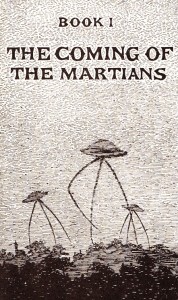 Much to Brandenburg’s credit, he does not harbor the antipathy to Sagan that many anomalists and Forteans do, reminding us that Sagan himself was open-minded about the possibility of an ancient Martian civilization, even if he appeared closed-minded on other areas with much better evidence, like UFOs. I’ve argued before that Sagan’s skepticism toward UFOs may have reflected his own kind of cosmic imaginal, which actually served a wise social/political agenda: A vast universe with distant intelligences and perhaps ancient relics of ET visitation on Mars or the Moon was a sublime vision that went hand in hand with taking responsibility for our cosmic fate and the fate of our planet, rather than expecting benevolent intervention by flying saucer brethren buzzing around our solar system in the here and now.
Much to Brandenburg’s credit, he does not harbor the antipathy to Sagan that many anomalists and Forteans do, reminding us that Sagan himself was open-minded about the possibility of an ancient Martian civilization, even if he appeared closed-minded on other areas with much better evidence, like UFOs. I’ve argued before that Sagan’s skepticism toward UFOs may have reflected his own kind of cosmic imaginal, which actually served a wise social/political agenda: A vast universe with distant intelligences and perhaps ancient relics of ET visitation on Mars or the Moon was a sublime vision that went hand in hand with taking responsibility for our cosmic fate and the fate of our planet, rather than expecting benevolent intervention by flying saucer brethren buzzing around our solar system in the here and now.
Brandenburg’s own Martian imaginal, although entertaining and based on some interesting evidence, is way too speculative to take very seriously. He also concedes it is grounded partly in his religious beliefs. Near the end of the book, he offers an admittedly “emotional conjecture” that “this Solar system may have been prophesied to be the home of the Christ by other species in space, and perhaps became a target because of it.” Brandenburg is not writing science fiction, but his Herod-style slaughter of the Martian innocent “as an attempt to prevent the birth of Christ in this solar system” is surely the most creative motive I’ve read for interstellar genocide. However, no less a mind than Stephen Hawking has also waxed alarmist at the prospect of ET aggression, suggesting we should make no attempts to advertise our presence lest we invite invasion or destruction. Are such fears realistic?
A Requiem for Alderaan
While it is often justified in religious terms, human aggression always boils down ultimately to competition for valuable resources and to self-defense. This fact itself is, I believe, one of the biggest counterarguments to most “hostile ET” scenarios.
All sci-fi scenarios for planetary destruction—including pure paranoid insanity—are predicated on an absence of the one thing I suspect the universe is actually full of: knowledge.
ET civilizations with the mastery of energy and matter on the scale required for extensive interstellar travel (i.e., Type I or Type II Civilizations, let alone higher) will have long since solved any resource problems that we or our planet’s (or even solar system’s) resources could help them with. Earth is truly, as Sagan underscored, a miniscule blue spec. Our minerals, our water, our meat, and our nice attractive real estate, dearly precious to us, will offer ETs nothing they can’t manufacture for themselves via sidereal and planetary engineering. Given the wild dissinchrony that will obtain between different intelligent races/civilizations/post-civilizations in our galaxy, anybody out there capable of becoming aware of us is in all probability already living in massive Dyson pleasure spheres, or has transcended physical reality altogether, if they are not long dead and gone. Whatever the case, they’re not in a position to want anything from us. Nor are they in a position to feel terribly threatened either by our presence or by our weapons (including our secret weapon, Jesus).
 Yet the assumption that advanced ETs could simply be malicious or have some other nefarious or unfathomable motive to destroy young civilizations like ours is a widely held one, and is of course a sci-fi staple. For example, Alastair Reynolds’ Revelation Space series is premised upon the discovery of civilization-destroying booby traps placed billions of years ago by an ancient race called the Inhibitors. Their purpose is to cull emerging civilizations throughout the galaxy in order to make galactic engineering easier when Andromeda and the Milky Way collide in another 3 billion years. Although I mostly love Reynolds’ imagination, this ancient agenda—sort of the opposite of that of the slabs in Arthur C Clarke’s 2001—falls flat. Not only does it seem like rather insane and pointless cosmic stewardship, it also (I assume unintentionally) calls to mind Douglas Adams’ comical scenario in Hitchhiker’s Guide to the Galaxy: destroying Earth to make way for a cosmic express route.
Yet the assumption that advanced ETs could simply be malicious or have some other nefarious or unfathomable motive to destroy young civilizations like ours is a widely held one, and is of course a sci-fi staple. For example, Alastair Reynolds’ Revelation Space series is premised upon the discovery of civilization-destroying booby traps placed billions of years ago by an ancient race called the Inhibitors. Their purpose is to cull emerging civilizations throughout the galaxy in order to make galactic engineering easier when Andromeda and the Milky Way collide in another 3 billion years. Although I mostly love Reynolds’ imagination, this ancient agenda—sort of the opposite of that of the slabs in Arthur C Clarke’s 2001—falls flat. Not only does it seem like rather insane and pointless cosmic stewardship, it also (I assume unintentionally) calls to mind Douglas Adams’ comical scenario in Hitchhiker’s Guide to the Galaxy: destroying Earth to make way for a cosmic express route.
More worthy of consideration is the motive for preemptive genocide that serves as the premise of a bad-but-interesting 1995 novel called The Killing Star, by Charles Pellegrino and George Zebrowski. A race of coldly logical alien octopi completely obliterate Earth and all human outposts in the solar system, without warning, using relativistic missiles—self-guided projectiles traveling at velocities edging toward the speed of light. The octopi’s motive is that they detect from our TV broadcasts (including Star Trek) that our species is on the brink of acquiring the technical capacity for relativistic spaceflight, so could potentially create a relativistic missile ourselves. Their attack is a preemptive strike just to be on the safe side.
Advanced ETs won’t look out into space the way we still do, seeing darkness and mystery and potential threats. Their technology will have created for them a cosmos of light, a noöverse.
The basic (and interesting) idea here is that relativistic spaceflight is itself the deadliest of weapons: An object accelerated to an appreciable percent of lightspeed would have kinetic energy well in excess of an equivalent amount of antimatter, and thus be practically the most destructive thing imaginable. Forget nuclear weapons; no warheads are needed. Also, such an attack would also be impossible to see coming. Applying this logic to SETI, the authors of The Killing Star suggest that the Great Silence (Fermi Paradox) may reflect not that civilizations destroy themselves but rather that they destroy each other: Specifically, whoever in our galaxy first acquired relativistic capability went ahead and suppressed all other newly arising civilizations with swift, planet-killing bullets to assure their own safety.
This is a distinctly Cold War logic, reminiscent of what was surely going through the minds of some strategists who were tasked with thinking the unthinkable: namely, preemptive strikes to eliminate the nuclear threat posed by Russia and China. It is an important argument to consider as an answer to the Fermi Paradox; but we also need to look at the geopolitical world that replaced the Cold War, and perhaps project newer (and ideally, future) realities onto the night sky instead of outmoded Dr. Strangelove fantasies. All the various sci-fi scenarios for planetary destruction, from the (weirdly) custodial motives of Reynolds’ Inhibitors to the purely survival imperative of Pellegrino and Zebrowski’s octopi—and even, pure paranoid insanity—are predicated on an absence of the one thing I suspect the universe is actually full of: knowledge, produced by ongoing active machine surveillance on a planet-to-planet level.
It’s a Noöverse, Folks
If ETs exist at all, the math dictates that “they” are already aware of us and were aware of us long before we started setting off nuclear warheads and long before they started receiving our broadcasts of Star Trek and I Love Lucy. ET surveillance drones could have been here before we stood upright on the savannah, and likely even before the primordial oceans bloomed with algae. This should not be a scary thought, but a reassuring one: A vast active drone intelligence system operating quietly across million- and billion-year timespans, which I have argued is probably the inevitable project of advanced civilizations, eliminates the kinds of scenario favored in space operas or cosmic paranoia scenarios like The Killing Star.
Klaatu is a myth we should, as thoughtful adults, grow out of. I’m here to tell you, though, that there are probably lots and lots of very unobtrusive Gorts.
Paranoia takes over in the absence of noös, knowledge and knowing. When you don’t know what’s out there, you fear it. Advanced ETs won’t look out into space the way we still do, seeing darkness and mystery and potential threats. Their technology will have created for them a cosmos of light, a noöverse, that they can inhabit virtually and that supplies them (or their machine proxies) with godlike prediction-and-control capacity. If, through a massive stealthy automated program of deep anthropology, you have complete predictive power over any and all ‘lesser’ species and civilizations, you—or really, your machine proxies—have ample warning to intervene in subtle, non-drastic ways to ensure your long-term safety. Emerging threats such as new spacefaring warlike civilizations and imminent supernovas (not to mention galactic collisions) will be foreseen long in advance, enabling easy steps to prevent calamity—rather like an ocean liner making a gentle, minor course correction ten miles away from an iceberg instead of a panicked course correction a half mile away. Swarming the galaxy with a neural net of autonomous Von Neumann probes capable of nuanced cultural intervention would require far less expenditure of energy and resources than accelerating projectiles to relativistic velocities. Surveillance and control in this subtle, long-duration sense will, I suspect, have largely replaced weapons and warfare for the universe’s more mature (and ancient) inhabitants.
The argument that the universe is really a noöverse can be made solely based on the Drake Equation and various mathematical models of interstellar expansion and Von Neumann probe propogation. Yet, two pieces of the UFO puzzle harmonize rather nicely with it: One is Vallee’s “control system” hypothesis—the notion that whoever/whatever is behind the UFO phenomenon, they seem to be steering us or nudging us somehow. Although Vallee favors a more local or interdimensional origin for these phenomena, a very long term project of subtle cultural course corrections coupled with a program of deep anthropology fits well with an ET drone hypothesis too, as I’ve argued previously. (Personally I suspect that the UFO phenomenon is actually multiple separate phenomena, including some ET component and a more local or interdimensional one, and that lumping them together contributes to our bafflement.)
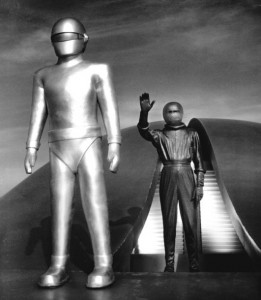 The other puzzle piece is UFOs’ overt and well-documented interest in nuclear weapons, noted by various authors including Leslie Kean
The other puzzle piece is UFOs’ overt and well-documented interest in nuclear weapons, noted by various authors including Leslie Kean and evidenced by Robert Hastings’ impressive body of data on UFO encounters in the context of nuclear tests and at missile silos. The notion that ET is here to steer us away from using nuclear weapons has of course been a staple of UFO folklore and popular culture from the start—most famously, the 1951 classic The Day the Earth Stood Still. Just because it’s pop culture doesn’t mean it’s wrong. My only modification to this scenario is that ET “interest” in our military technology would be very long-term and would not at all be personal: Klaatu is a myth we should, as thoughtful adults, grow out of. I’m here to tell you, though, that there are probably lots and lots of very unobtrusive Gorts.
Postscript: Surveillance States
In the noöverse, we have no expectation of privacy. When our galactic antecedents could be millions or billions of years beyond us in technological capacity, being surreptitiously watched by them and even nudged culturally should be a reassuring prospect, not a disturbing one. What about affairs closer to home, when advanced technological states are, sort of similarly, light years beyond their citizenry in technological capacity? Considerations and reconsiderations of cosmic paranoia should force us to reflect on more immediate political realities.
If a paranoid military-government apparatus lacked the technological ability to listen to its citizens’ phone calls and read its e-mails, might it not feel compelled to engage in a more widespread pattern of imprisonment, torture, and assassination?
Much as I applaud Edward Snowden and others who are reporting on and fighting the encroachment of the modern secrecy/surveillance state, I think it is also useful to at least consider how a situation of pervasive surveillance might actually be preferable to certain alternatives in our current “archonic” terrestrial reality. Before you hurl tomatoes at me, listen: If a paranoid military-government apparatus lacked the technological ability to listen to its citizens’ phone calls and read its e-mails, might it not feel compelled to engage in a more widespread pattern of imprisonment, torture, and assassination of people even remotely fitting the profile of a subversive or terrorist?
In other words, state surveillance is worse than privacy, but it may be better than other possibilities we generally avoid thinking about—like a pattern of outright, stealthy killing and “disappearances.” While I suppose it could reflect a passive, cowardly cynicism about political structures and governments, part of me wonders whether high-tech state surveillance, by reducing state-level paranoia, might actually make make us safer from those governments, if not actually safer from ostensible external threats like terrorism. I don’t know the answer, but I put that out there for consideration and discussion.
The Great Work of Immortality: Astral Travel, Dreams, and Alchemy
The ceramic-and-glass sculptures shown in this article are by artist Christina Bothwell, used with her kind permission.
Judging from the number of books and YouTube videos now available on the subject, out-of-body experiences (OOBEs) seem to be enjoying a contemporary revival, and there is surely no hobby more ontologically controversial. Several authors, including Robert Monroe (Journeys Out of the Body) claim to have had veridical experiences in a discarnate state (that is, experiences that correspond to reality) and thereby proven to their own satisfaction, if not the world’s, that one’s perceiving consciousness can exist apart from the physical body. Other writers understandably are skeptical of such claims, regarding the seeming realness of OOBEs as a cognitive or memory trick.
Whatever out-of-body experiences “really” are—actual journeys beyond the body or just lucid dreams that seem like it—it is increasingly clear that they were crucially important experiences in ancient mystical traditions.
Susan J. Blackmore, for example, initially believed in her own OOBEs’ realness but then retreated to a skeptical, safely materialist position; her 1982 book, Beyond the Body, is a thoughtful, comprehensive examination of the subject and its connection with psychical research. Recently, in his excellent exploration of Buddhist psychology and neuroscience, Waking, Dreaming, Being, Evan Thompson presents a similar narrative of youthful belief in the realness of his OOBEs followed by mature doubt. For these writers, OOBEs can only be a subset of lucid dreams—a state of being actively aware and conscious in a dream environment (in this case, one that just seems like one’s actual surroundings or other terrestrial locales). Lucid dreaming is itself an increasingly popular, albeit less controversial, contemporary hobby, thanks to the pioneering research and instruction of Stephen LaBerge. There are numerous guides to the practice available, mostly repackaging the ideas in LaBerge’s 1985 book Lucid Dreaming and in some cases incorporating Tibetan “dream yoga” techniques.
 Whatever OOBEs “really” are—actual journeys beyond the body or just lucid dreams that seem like it—it is increasingly clear that they were crucially important experiences in ancient mystical traditions. Achieving these states may have been the aim of the ancient Greek shamanic practice of “incubation”—sensory deprivation in caves—as has been described in the writings of Peter Kingsley
Whatever OOBEs “really” are—actual journeys beyond the body or just lucid dreams that seem like it—it is increasingly clear that they were crucially important experiences in ancient mystical traditions. Achieving these states may have been the aim of the ancient Greek shamanic practice of “incubation”—sensory deprivation in caves—as has been described in the writings of Peter Kingsley. And thanks to the work of Jeremy Naydler
and Algis Uždavinys
, we now know that descriptions of spirit travel in Egyptian sacred ‘funerary’ texts did not simply refer to the travel of the soul in the afterlife; they reflected a proactive shamanic exercise undertaken during life. Egyptian mystics actively practiced out-of-body travel, in other words, as the ultimate philosophical preparation for death.
One could imagine other, more mundane purposes too. Given the intelligence-gathering role of prophets in ancient Israel, it would not be far-fetched to guess that the Egyptian priesthood might have employed OOBEs along with other shamanic techniques in what we would nowadays call “psychic spying” on behalf of the state. OOBEs are linked to psychic abilities like clairvoyance, and some of the foremost modern remote viewers, including Joe McMoneagle, Ingo Swann, and Pat Price, have linked their abilities directly to OOBE experiences—in Price’s case, during Scientology training. One could easily imagine Egyptian priests performing a service to the kingdom much like psychics did to the U.S. and U.S.S.R. during the Cold War.
The feminine, animal-like spirit was thought capable of leaving the body when we sleep. The Egyptians called it Ka. For pagan Europeans, it was our spirit double or feminine spirit guide.
The Middle Eastern and European traditions of alchemy that evolved out of the Egyptian mystical tradition would have carried on these practices, albeit disguised under layers of “materialistic” symbolism. Carl Jung famously illuminated the inner aspect of alchemy, arguing that the Great Work consisted of projecting unconscious mental stuff into material transformations, using laboratory processes and procedures as a symbolic control panel in personal journeys of individuation. Yet even though he described “active imagination” as a method of self-exploration, Jung to my knowledge was not aware of what we now call lucid dreaming, and even though he experienced his own OOBE, or what the spiritualists and occultists of his day called “astral projection,” after a heart attack in 1944 (what we would now call a near-death experience or NDE), I am not aware that he ever linked such experiences to what alchemists were trying to achieve.
But given what we now know of the ancient shamanic practices of Egypt that gave rise to alchemy, European alchemy’s Eastern analogues in Tantra and Yoga, and the pagan shamanic traditions that persisted on the margins of mainstream Christian culture in Europe, it becomes ever clearer that alchemical explorations would have gone, and indeed must have gone, much beyond active imagination and the projective processes Jung described. The real philosophic gold for some (or many) alchemists may have been fearlessness in the face of death—figurative “immortality”—achieved by self-induced veridical or veridical-seeming OOBEs.
Spirit and Soul
Crucially, and perhaps counterintuitively, the prerequisite for developing one’s astral capacity, in various ancient as well as modern traditions, was to cultivate not simply a Cartesian dualistic conception of psyche and soma, mind and body, but also to further subdivide the subtle psychic part of our nature into at least two distinct components of its own. Pagan and folk traditions all described a spirit with a dim animal-like awareness that was distinct from our more rarified and active, wilful, conscious component, equivalent to what in Christian tradition came to be called the soul. These were separate entities, not synonyms as they are for most people today.
 In general, the feminine, animal-like spirit was thought responsible for phenomena belonging to what Freud and Jung later called the Unconscious, and was thought capable of leaving the body when we sleep. The Egyptians called it Ka. For pagan Europeans, it was our spirit double or feminine spirit guide. Claude Lecoutoux, in a fascinating study
In general, the feminine, animal-like spirit was thought responsible for phenomena belonging to what Freud and Jung later called the Unconscious, and was thought capable of leaving the body when we sleep. The Egyptians called it Ka. For pagan Europeans, it was our spirit double or feminine spirit guide. Claude Lecoutoux, in a fascinating study of European pagan/shamanic traditions about spirit doubles, shows that this component not only took nightly trips remembered as dreams but also was responsible for ghost and poltergeist phenomena as well as animal familiars. As an enlivening force, the spirit was closely allied to our breath (whence the name, spiritus); linked to our physical body, it was also connected to our bones in some intimate way. Much later, in the Theosophical tradition, it came to be known as the “etheric body”; modern New Age writers write of an “energy body” that is more or less equivalent (see below).
This feminine, energetic spiritual component was in contrast to the more rarified, conscious, aware component allied to masculine, rational, awake thought. Although this “soul” component was capable of heavenly ascent after death or during ecstatic states, in daily life it was more imprisoned in the body than the spirit component. Indeed the two parts of the subtle self tended to resist being in direct contact when not together animating the awake physical body. This soul component was the Ba of the Egyptians (capable of ascending and uniting with the transcendent Akh) and corresponds to the Theosophists’ “astral” components of the self. If you take away its ancient connotation of existing beyond death, it is more or less equivalent to what we nowadays call consciousness: the center of awake, aware subjectivity.
Such a tripartite division of our earthly existence into body, soul, and spirit seems remarkably universal across non-Judeo-Christian cultures. Whatever you call these subtle psychic components, shamans throughout the world, including in Medieval and Dark Age Europe, claimed the ability, through meditative practice and sometimes use of drugs, to yoke them together and thereby achieve the feat of leaving their bodies consciously. And, some of the most mysterious texts of 16th and 17th century alchemy show indirect or direct evidence that, whatever else they were up to, alchemical adepts were also attempting precisely these difficult “journeys beyond the body.”
Lambspring
The clearest example is The Book of Lambspring, an alchemical poem that first circulated as a manuscript in the late 16th century and was later published with a series of beautiful illustrative engravings. It asserts that the key to riches, long life, and kinglike sovereignty over one’s existence is a process of taking the separate subtle components, soul and spirit, consciously uniting them, and leading them out of the body and back again. Among the various symbolic expressions of this are the imagery of a deer and unicorn living in a forest…
The sages say truly
That two animals are in this forest:
One glorious, beautiful, and swift,
A great and strong deer;
The other a unicorn.
They are concealed in the forest,
But happy shall that man be called
Who shall snare and capture them. …
If we apply the parable to our Art,
We shall call the forest the Body.
That will be rightly and truly said.
The unicorn will be the Spirit at all times.
The deer desires no other name
But that of the Soul; …
He that knows how to tame and master them by Art,
To couple them together,
And to lead them in and out of the forest,
May justly be called a Master.
For we rightly judge
That he has attained the golden flesh,
And may triumph everywhere;
Nay, he may bear rule over great Augustus.
Lambspring gives us further explicit indication of his belief/assertion that the soul and spirit actually leave the body during the alchemical work in the second half of his book, where he replaces the symbolism of forest, unicorn, and deer, with the more humanized symbolism of Father (body), Son (spirit), and an angelic Guide (soul). The Guide leads the Son out of the body of the Father, brings him up to the top of a “mountain in India” and carefully leads him back. This process of separating and reuniting—Separatio and Conjunctio—is one of the most central and universal motifs in European alchemy, but it is nowhere more explicitly identified as a process of leading the consciousness and spirit out of the body as it is in this book. The alchemical motto solve et coagula—”separate and reunite”—can refer on one level to this process.
 On its own, Lambspring’s book would be pretty unhelpful to a modern person attempting to actually achieve an OOBE, but the author’s symbolism resonates strongly with the methods emphasized by some more modern teachers of the subject. The Theosophical tradition, which placed great emphasis on astral projection as a means of accessing cosmic consciousness (the Akashic Records, etc.) and communicating with ascended and alien intelligences, carefully emphasized the crucial role of the lower, denser “etheric body”—the subtle, energetic envelope or spiritual vehicle that could detach from the physical body on its own (dreaming) or which could, through effort, be yoked to the astral component (conscious awareness or soul) to achieve a conscious astral flight. The key to leaving the body consciously, in other words, was uniting the astral and etheric components, which, as I mentioned earlier, ordinarily don’t mix well together. (The resistance of the unconscious and conscious minds to commingle is of course a theme in Freudian and Jungian psychoanalysis, and may be seen as a kind of parallel here.)
On its own, Lambspring’s book would be pretty unhelpful to a modern person attempting to actually achieve an OOBE, but the author’s symbolism resonates strongly with the methods emphasized by some more modern teachers of the subject. The Theosophical tradition, which placed great emphasis on astral projection as a means of accessing cosmic consciousness (the Akashic Records, etc.) and communicating with ascended and alien intelligences, carefully emphasized the crucial role of the lower, denser “etheric body”—the subtle, energetic envelope or spiritual vehicle that could detach from the physical body on its own (dreaming) or which could, through effort, be yoked to the astral component (conscious awareness or soul) to achieve a conscious astral flight. The key to leaving the body consciously, in other words, was uniting the astral and etheric components, which, as I mentioned earlier, ordinarily don’t mix well together. (The resistance of the unconscious and conscious minds to commingle is of course a theme in Freudian and Jungian psychoanalysis, and may be seen as a kind of parallel here.)
One of the many modern teachers of astral projection, an Australian energy worker named Robert Bruce, has (in his book Astral Dynamics) essentially repackaged the Theosophical theory and its Eastern Tantric equivalents in modern, Western terms. Bruce teaches meditative exercises and a rather unique method of “tactile imaging” to cultivate a finer-tuned awareness of the physical body and its subtle energetic aspect (equivalent to the energy body with its nadis, chakras, etc. described in Asian systems) as a prerequisite to developing proficiency with astral travel. The separation experience at the outset of an OOBE is universally described as a vividly energetic sensation that may also resemble sensations familiar to those who have “raised their kundalini.” There is no indication in Bruce’s writing of familiarity with pagan folk traditions about the detachable spirit double, but clearly, despite using a modern computer idiom of “downloading” astral memories etc., his metaphysics are basically the same.
Energy Doubles
To my mind, the strongest evidence that Lambspring was referring to the refined, dreamlike but compellingly real-seeming state we would now call the OOBE comes from the testimony of modern astral travelers like Bruce that the key to decoupling alert awareness from the sleeping physical body is actually to be found, counterintuitively, in the reentry—the Conjunctio part rather than the Separatio. Lambspring places special emphasis on this: The Guide says to the son, “I will not let thee go alone; From thy father’s bosom I brought thee forth, I will also take thee back again.”
If you can’t recall it when you return, it’s like you never went. Developing a habit and a practice of recording dreams in the morning is a crucial preparatory step toward having a remembered astral journey.
Special care in rejoining chemical substances in physical alchemy could of course also be indicated here, but I think it signals a special concern with the process of reuniting the soul/spirit with the body as intrinsic to the success of the astral venture. The purpose of “careful reuniting” is not safety, as one might naturally suppose: Despite instinctive fears of permanent separation, there are no known cases when an astral traveler has failed to awaken safe and sound. Rather it is because the conscious portion of the self (i.e., soul or astral body) must remain in contact with the spiritual/etheric body, lest all recollection of the experience be lost. If you can’t recall it when you awaken/return, it’s like you never went. Consequently a crucial part of some modern training in OOBEs focuses on developing the capacity to remember it after the fact, because an unremembered OOBE is no OOBE at all.
 This is the most crucial piece of advice given by Bruce: He even suggests that we are astrally projecting all the time but lack memory of it; thus his method focuses on initially keeping flights brief and then celebrating and recording one’s small successes. Developing a habit and a practice of recording dreams in the morning is a crucial preparatory step toward having a remembered astral journey.
This is the most crucial piece of advice given by Bruce: He even suggests that we are astrally projecting all the time but lack memory of it; thus his method focuses on initially keeping flights brief and then celebrating and recording one’s small successes. Developing a habit and a practice of recording dreams in the morning is a crucial preparatory step toward having a remembered astral journey.
The relationship between OOBEs and lucid dreams is widely disputed, but the same “induction” methods work for both, not to mention the necessity of keeping records afterward. This is true of any dream-work, as I’ve argued previously in the context of precognitive dreaming. Anyone who knows the extraordinary value of attention to dreams (even in a simply psychoanalytic vein) knows you will have a hard time remembering a dream or its crucial innocuous-seeming details if you don’t write it down right away, or at least jot down a few words to jog the memory when you have time to record it more fully later in the day.
Atalanta Fugiens
My favorite 17th-century alchemical text, Atalanta Fugiens by Michael Maier, contains among many other things a coded recommendation about keeping a dream diary, likely as preparation for more advanced Tantric or OOBE exercises.
It’s a very special quality of dreams that they evaporate very quickly and must be seized immediately after they occur or they are lost forever. Quick note-taking is required to fix this volatile substance.
The title of this lovely collection of engravings and accompanying poems and fugues, literally “Atalanta Fleeing,” refers to Ovid’s story about the race between the beautiful fleet-footed virgin Atalanta and her would-be suitor Hippomenes. The central secrets of alchemical books are sometimes hidden in plain sight right in their title pages, like Poe’s “purloined letter,” and this is true of Atalanta Fugiens, whose frontispiece depicts various scenes from the Atalanta legend. The 50 emblems and commentaries in the book supposedly relate in various ways to the Hermetic themes of that ancient myth.
 Atalanta was the fastest in the land—so fast she couldn’t be caught—and would only marry a suitor who could beat her in a race. Hippomenes wins the race (and her hand in marriage) by availing himself of three gold apples given to him by Venus; during the race, he throws the apples on the ground, one by one, each time catching Atalanta’s attention and slowing her down (you know, the way even tomboy girls are easily distracted by pretty, shiny things). After winning the race, Hippomenes steals a kiss from his new bride in Aphrodite’s temple and the couple (as punishment from that goddess) are turned into lions. The conflict of two lions (and/or dragons) resulting in their ultimate union—again, soul and spirit which do not initially get along but which, with difficulty, can be forced into a productive merger—is a near-universal alchemical motif.
Atalanta was the fastest in the land—so fast she couldn’t be caught—and would only marry a suitor who could beat her in a race. Hippomenes wins the race (and her hand in marriage) by availing himself of three gold apples given to him by Venus; during the race, he throws the apples on the ground, one by one, each time catching Atalanta’s attention and slowing her down (you know, the way even tomboy girls are easily distracted by pretty, shiny things). After winning the race, Hippomenes steals a kiss from his new bride in Aphrodite’s temple and the couple (as punishment from that goddess) are turned into lions. The conflict of two lions (and/or dragons) resulting in their ultimate union—again, soul and spirit which do not initially get along but which, with difficulty, can be forced into a productive merger—is a near-universal alchemical motif.
We are meant to ask, what is it that flees and how can you stop it from fleeing? The name Atalanta, meaning “equal in weight or value,” does not really give a clue to the nature of the volatile substance. But Hippomenes himself can tell us a lot. The name can be parsed firstly as hippo-menes or “horse mind,” which by itself signals that we may apply the wild-etymological method that the great 20th-century adept Fulcanelli called cabala (from caballus, horse), and redivide the word however we see fit. The most obvious re-parsing is hip-pommes, or “dropped apples,” which doesn’t tell us anything we didn’t already know. But there is a very similar Greek word, hypomnema, which meant a reminder, a note jotted down. It happens that Emblem VI depicts this process explicitly: A farmer tosses gold coins onto furrowed ground (a gesture similar to Hippomenes tossing golden apples), accompanied by the motto: “Sow your gold in the white foliate earth.” Hippomenes thus seems to be a pun for the very thing indicated by “white foliate earth” with its “sown gold”—that is, hypomnema, precious reminders of something fleeting, jotted down (sown) in the white pages (folia or leaves) of a notebook.
 Keeping records of laboratory procedures and results and the visible changes occurring in the retort would be an obvious interpretation here, not to mention the ultimate creation of a book that will serve to guide others: the alchemical text itself as philosopher’s stone. But are consciously observed chemical reactions, however fleeting, so ephemeral (or volatile) that they are completely forgotten unless fixed in the very moment they occur? No—it’s a very special quality of dreams and related phenomena like hypnagogic/hypnopompic images that they evaporate very quickly and must be seized immediately after they occur or they are really lost forever. Quick note-taking is required to fix this volatile substance.
Keeping records of laboratory procedures and results and the visible changes occurring in the retort would be an obvious interpretation here, not to mention the ultimate creation of a book that will serve to guide others: the alchemical text itself as philosopher’s stone. But are consciously observed chemical reactions, however fleeting, so ephemeral (or volatile) that they are completely forgotten unless fixed in the very moment they occur? No—it’s a very special quality of dreams and related phenomena like hypnagogic/hypnopompic images that they evaporate very quickly and must be seized immediately after they occur or they are really lost forever. Quick note-taking is required to fix this volatile substance.
There is way, way more that could be said about Atalanta Fugiens, which contains enough fascinating “Tantric” imagery to reward years of perusal and study. But let me move on to a third book that most explicitly addresses the link between dream life and OOBEs and also uses its own brilliant symbolism for dream recording.
Mutus Liber (Enlightenment by Means of Dew)
The 1677 alchemical masterpiece Mutus Liber (or “Silent Book”) is a series of mostly wordless alchemical ‘cartoons’ by a writer with the pseudonym “Altus,” depicting a complicated esoteric process undertaken by a pair of adepts, one male, one female. (Sometimes it is described as a male alchemist and “his” female assistant, wife, Tantric soror mystica, or Jungian Anima, but the book gives no cause to privilege the male figure over the female—they both seem to play equally important roles.) This book is another example of an alchemical text that hides its cipher in plain sight, right on its title page.
 The frontispiece depicts Jacob’s famous dream in Genesis 28, of angels ascending and descending a ladder to heaven. Any reader would know that, in that story, right after he awakens, Jacob anoints the stone he has used for a pillow beth-el, “House of the Lord”; until the arrival of Christ himself in the Old Testament’s sequel, this stony pillow is perhaps the clearest and most literal expression of the Philosopher’s Stone in the Bible. But more crucially for the book we are concerned with here, the Jacob frontispiece includes three backwards chapter/verse numbers in Hebrew, each referring to Biblical passages about heavenly “dew.” The centrality of dew in this book is also signaled cleverly by the roses framing the scene: Rose is a pun on the Latin word for dew, ros (which should also give you a clue to the ‘true’ meaning of the rose in other esoteric contexts, such as Rosicrucianism).
The frontispiece depicts Jacob’s famous dream in Genesis 28, of angels ascending and descending a ladder to heaven. Any reader would know that, in that story, right after he awakens, Jacob anoints the stone he has used for a pillow beth-el, “House of the Lord”; until the arrival of Christ himself in the Old Testament’s sequel, this stony pillow is perhaps the clearest and most literal expression of the Philosopher’s Stone in the Bible. But more crucially for the book we are concerned with here, the Jacob frontispiece includes three backwards chapter/verse numbers in Hebrew, each referring to Biblical passages about heavenly “dew.” The centrality of dew in this book is also signaled cleverly by the roses framing the scene: Rose is a pun on the Latin word for dew, ros (which should also give you a clue to the ‘true’ meaning of the rose in other esoteric contexts, such as Rosicrucianism).
The stuff of dreams is the materia prima, the murky raw material that must be taken, analyzed, worked with, to create true philosophic gold.
In subsequent panels, the alchemists are depicted engaging in various laboratory operations utilizing dew that has been initially collected in an array of sheets during spring mornings, the season being symbolized by a ram and bull, Aries and Taurus, rampant in the background (although the animals could have other connotations—see below). As a means of collecting literal nocturnal moisture, wringing out sheets one has suspended on posts in a field seems that it might be highly impractical. But “dew” is not meant to be taken literally here.
 Adam McLean’s diagram of the process, provided in his Magnum Opus Hermetic Sourceworks Commentary
Adam McLean’s diagram of the process, provided in his Magnum Opus Hermetic Sourceworks Commentary, is invaluable for keeping track of the operations and the dense symbolism in Mutus Liber. For another modern interpreter writing under the name Eli Luminosus Aequalis
, these sheets represent the five senses, and his subsequent analysis depicts a noetic, epistemic, and Tantric process. I agree with many of Eli’s interpretations, but I think he is wrong about the ingenious symbolism of dew itself and its collection on bedsheets: What else is it that appears in the early morning hours and evaporates quickly with the dawn, and that one might carefully and quickly collect ideally while still lying in bed? The same thing Maier represents by the fleeing Atalanta, and the same thing Jacob is shown in the process of doing right on this book’s title page.
Mutus Liber is actually pretty explicit about what we are supposed to do with this figuratively dew-like substance collected over a series of spring mornings. Subsequent panels depict an elaborate process of distilling and then mixing the dew’s various components in different combinations. Assuming I am right about the identity of “dew,” the process begins with what I believe to be isolating repeated dream motifs from other symbolic stuff and Freudian day residues and then using these recurring motifs as mnemonic triggers to wake up inside the dream (lucidity). This is the mnemonic-induced lucid dreaming (MILD) method recommended by LaBerge, and it may be taken as the equivalent of yoking soul and spirit and exiting the sleeping body consciously, as in Lambspring. Eli Luminosus Aequalus likewise argues that this part is about lucid dreaming. I imagine though that, at the time Altus was writing, there would have been no distinction between such ‘mere’ dream experiences and what we would now call OOBEs or astral travel.
Developing lucid dreaming capacity is useful for achieving a full-on OOBE and lucid dreams are the more common experience when the latter fails. Also, it is only in preparing for and interpreting an OOBE as such that one needs to first understand (or, be persuaded) that the spiritual component is distinct from consciousness imprisoned in the body (i.e., the first phase of the Mutus Liber process), which then enables one to learn to unite the consciousness with the spirit while leaving the body behind (the second phase), and lastly bring them together, followed by repetition of the process over time such that it becomes easier (lather, rinse, repeat).
The key to riches, long life, and kinglike sovereignty over one’s existence is taking the soul and spirit, consciously uniting them, and leading them out of the body and back again.
So I think that the Mutus Liber is basically a Baroque astral projection manual disguised as chemistry: The stuff of dreams is the materia prima, the murky raw material that must be taken, analyzed, worked with, to create true philosophic gold: a special “blended” state in which the soul (alert consciousness) fully joins with the spirit double/”energy body” on its nightly travels. Successive separations and conjunctions (returns) exalt the self and lead to enlightenment. Over the course of the book, the curtains behind the alchemists progressively open, letting more and more light into their workshop.
Why All the Secrecy?
Beliefs in the separability of consciousness from the body prior to death were antithetical to Christian theology: Humans possessed just a single “subtle” principle, the soul, which departed the body only in death. Jesus was the singular exception, the only person possessing a divine spirit as well as a soul. As a result, all ordinary human phenomena hinting at spirit—from dreams and visions and mystical and other altered states of consciousness to manifestations of what we would now call “the paranormal,” like ghosts or psychic phenomena—were at least distrusted and were often relegated wholly to the category of the demonic. You could say, Christianity successfully robbed religion of spirit, replacing it with faith.
 Whether or not we nowadays accept that each person possesses both detachable components, the work of Lecoutoux (for Europe), Naydler (for Egypt), and other scholars makes clear that it was firmly a part of pre- and para-Christian folk psychology, supported by infrequent but remarkable experiences like spontaneous OOBEs, lucid dreams, sleep paralysis episodes, near-death experiences, drug experiences, etc. The continuity of shamanic practices under various alternative labels (black magic, sorcery, witchcraft, etc.) in Christian Europe was certainly genuine, even if their prevalence and power was exaggerated by Church authorities. Alchemical explorers of consciousness would have pursued these techniques, marvelously and densely disguising their efforts under their chemical symbology.
Whether or not we nowadays accept that each person possesses both detachable components, the work of Lecoutoux (for Europe), Naydler (for Egypt), and other scholars makes clear that it was firmly a part of pre- and para-Christian folk psychology, supported by infrequent but remarkable experiences like spontaneous OOBEs, lucid dreams, sleep paralysis episodes, near-death experiences, drug experiences, etc. The continuity of shamanic practices under various alternative labels (black magic, sorcery, witchcraft, etc.) in Christian Europe was certainly genuine, even if their prevalence and power was exaggerated by Church authorities. Alchemical explorers of consciousness would have pursued these techniques, marvelously and densely disguising their efforts under their chemical symbology.
Thus in their writings alchemists perpetually did a subtle dance around this issue of our subtle self: Is it one thing or two? When they wrote explicitly about soul and spirit as distinct, it was important to emphasize either that they were referring to physical chemistry—in which “spirits” are light volatile distillates (like alcohol) and the “soul” of a substance could stand for its oily and more distinct extracts—or alternatively, to insist that “the two are really one.” We see this evasiveness clearly in Lambspring’s opening verse. The author says “the sages will tell you” that the body contains a soul and a spirit and that “nevertheless they are one.” Lambspring himself, weighing in on this, is more equivocal: “Now I tell you most truly, cook these three together … and hold your tongue about it.” He seems to be saying that body, soul, and spirit really are in some sense three things, but if you are smart, you won’t admit to holding such a belief.
The extent to which this Christian duality of the person influenced subsequent rationalist, materialist tradition have been less acknowledged. Enlightenment science and the rationalist tradition carried forward the Christian presumption of a singular mental principle that might somehow be distinct from the body, as in Descartes, and required no third intermediary, no third term mediating them or yoking them together, other than God himself. The result has been an almost complete erasure of the ancient and pagan traditions about spirit doubles, as well as lingering confusion about what spirit and soul mean. Most people now use the terms interchangeably, unaware that there was once a meaningful distinction.
Anyone who in their own spiritual explorations has realized the importance of figuring out just what (the hell) out-of-body experiences really are knows how difficult it can be, and also how worthwhile the pursuit as revealed by even the first glimmers of success.
To this day, we have difficulty conceptualizing a consciousness that is not somehow unified, yet we also perpetually have trouble conceptualizing how these two radically different things, consciousness and the physical body, could be linked together. They seem to need a mediator that our metaphysics completely lacks. Descartes’ famous search for the seat of consciousness in the pineal gland is emblematic of the felt need for some mysterious mediating principle to yoke the soul to the living body.
It was of course the genius of Freud and his followers like Jung to renew our sense of the psyche’s plurality, resolving it into the conscious and unconscious components as well as parsing psychological functions in various other ways. But even Jung and the analytical psychology he inspired continue to implicitly see the psyche as one thing, even if the person has delusionally lost sight of this unity through a refusal to recognize rejected components of self; spirit and soul are merely aspects of the same underlying consciousness that would realize its unity through individuation. For instance, the Jung-inspired writer James Hillman described the soul as the humid enclosed “valleys” where we live surrounded by the familiar local particulars of our lives, and the “spirit” as the mountain peaks to which we may at times loftily ascend, attaining a clearer, more objective, more far-seeing view. They are places our singular consciousness moves between, not actual separable components of our being. Lambspring’s “mountain in India” where the soul and spirit ascend in tandem, would make no sense in Hillman’s framework.
Laughing at Death
Anyone who in their own spiritual explorations has realized the importance of figuring out just what (the hell) OOBEs really are knows how difficult it can be—with months or years of setbacks, disappointment, and discouragement—and also how worthwhile the pursuit as revealed by even the first glimmers of success. Ordinary lucid dreaming, the continuity of consciousness in a typical dream environment and at least a related phenomenon (if not the same), is supremely exhilarating and empowering—famously a route to gaining control over one’s fears and nightmares, much the way virtual reality is used to desensitize people from phobias or train extraordinary and dangerous skills. Actual OOBEs in “Reality I” (Monroe) or the “real time zone” (Bruce)—that is, experiences in which the immediate physical environment and even one’s own sleeping body seem to be perceived and interacted with—certainly would provide the experiencer with an even greater validation of the separability of one’s consciousness from material existence and, as an inevitable corollary, its possible survival of bodily death.
 Such experiential verification of the indestructibility of consciousness would be priceless to humans living in the constant terror of mortality, so it is no wonder that, in the centuries before we could automatically blame such experiences on the material brain, such experiences constituted an “elixir of immortality” (i.e. as proof of immortality), as well as a talisman of power and health and courage. Once the son and father are reunited in Lambspring’s final verse, “they produce untold precious fruit. They perish never more, and laugh at death.” Assurance of the independence of consciousness from the body would indeed tend to make one brave in life, and this courage would tend to produce power and success. Once you’ve glimpsed it or been convinced there could be something to it, it really is something worth devoting energy and time to exploring.
Such experiential verification of the indestructibility of consciousness would be priceless to humans living in the constant terror of mortality, so it is no wonder that, in the centuries before we could automatically blame such experiences on the material brain, such experiences constituted an “elixir of immortality” (i.e. as proof of immortality), as well as a talisman of power and health and courage. Once the son and father are reunited in Lambspring’s final verse, “they produce untold precious fruit. They perish never more, and laugh at death.” Assurance of the independence of consciousness from the body would indeed tend to make one brave in life, and this courage would tend to produce power and success. Once you’ve glimpsed it or been convinced there could be something to it, it really is something worth devoting energy and time to exploring.
Assurance of the independence of consciousness from the body would indeed tend to make one brave in life, and this courage would tend to produce power and success.
The methods are, and were, various. In the excellent recent collection of essays, Alchemical Traditions (edited by Aaron Cheak), Hereward Tilton examines the writings of the 16th Century alchemist Heinrich Khunrath and his contemporaries, and concludes that Khunrath’s work described (and concealed) processes that resulted in the creation of diethyl ether—a potent anaesthetic. Ether may have been literally the philosopher’s stone for Khunrath, which supports the idea that European alchemists were indeed engaged in a project of exploring and using altered states of consciousness. Anesthetics particularly are notable for producing profound dissociative or out-of-body experiences.
But what the user gains in facility of entering an altered state using drugs may be canceled by the difficulty of controlling the experience and, in the modern world at least, easy dismissal of the experience’s validity. Thus while entheogens may provide an important taste of out-of-body or lucid-dream-type experiences, the holy grail really seems to be the production of these experiences solely through meditation and other non-chemical techniques. The original alchemical text, the Tabula Smaragdina or Emerald Tablet, tells us that “the wind carried it in its belly,” which points directly to meditation as the method of the Great Work. The link between breath (the original meaning of “spirit”) and thought is well-known in many traditions, and so it was surely central to ancient contemplative practices and trance.
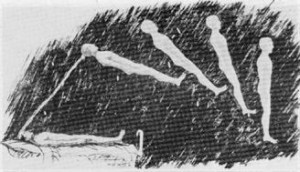 There are plenty of guides out there now to enable one to learn to have OOBEs and ascertain for yourself whether they are merely a subset of lucid dreams—obviously the only scientifically and socially acceptable materialist interpretation—or something more. I’ve mentioned a couple of them, but the very best books on the subject are from early in the last century. My favorite, and the most interesting, is the 1929 book The Projection of the Astral Body, a collaboration between an articulate lifetime ‘projector’ Sylvan Muldoon and psychical researcher Hereward Carrington. It includes thorough discussion of the means of inducing these experiences as well as interesting suggestions of their link to other phenomena like sleep paralysis (“astral catalepsy”) and hypnic jerks (“repercussion”). Those authors mention a 1920 series of articles by projector Oliver Fox, subsequently published as Astral Projection, which I also really like—it is less comprehensive, but more personal, and also more frank about the difficulties and disappointments inherent in the practice, such as the increased difficulty of having such experiences with age.
There are plenty of guides out there now to enable one to learn to have OOBEs and ascertain for yourself whether they are merely a subset of lucid dreams—obviously the only scientifically and socially acceptable materialist interpretation—or something more. I’ve mentioned a couple of them, but the very best books on the subject are from early in the last century. My favorite, and the most interesting, is the 1929 book The Projection of the Astral Body, a collaboration between an articulate lifetime ‘projector’ Sylvan Muldoon and psychical researcher Hereward Carrington. It includes thorough discussion of the means of inducing these experiences as well as interesting suggestions of their link to other phenomena like sleep paralysis (“astral catalepsy”) and hypnic jerks (“repercussion”). Those authors mention a 1920 series of articles by projector Oliver Fox, subsequently published as Astral Projection, which I also really like—it is less comprehensive, but more personal, and also more frank about the difficulties and disappointments inherent in the practice, such as the increased difficulty of having such experiences with age.
Depending on how old you are, having OOBEs may prove much more difficult than most enthusiasts like to claim. Despite a few spontaneous OOBEs when I was a young adult and another about 18 years ago, deliberately bringing one on in my late forties has proven extraordinarily difficult—only one full-on success thus far, as well as many attempts resulting in lucid dreams or other precursor phenomena like sleep paralysis and strong energy- or Kundalini-like sensations like those described in the manuals.
It is plenty to satisfy me that the ancient and modern authors are not simply lying about the experience. Whatever is really happening in OOBEs, they do feel distinctly real/veridical in a way that lucid dreams do not, even though the surest method of induction—basically, sensation-focused meditation while lying in bed—is the same, as are the unusual, initially alarming energetic sensations frequently preceding or accompanying them. Meditative work with hypnagogia during the day or evening can also bring on remarkably real-seeming “remote viewing”-like experiences without the ability to actually move around in the seen environment; but “real seeming” isn’t necessarily the same as real. I’m still on the fence about the nature of all these phenomena and how they relate to each other. That they are indeed related seems undeniable, however.
Postcript: What Are Sheep?
Rams and sheep appear throughout alchemy, and they also have a little-noticed symbolic connection to sleep going back hundreds or, I suspect, thousands of years.
Sheep, which must be closely watched at night, are like dreams, and shepherds are watchers of dreams.
First, the alchemical Great Work is always said to originate under the sign of Aries, the ram—ordinarily taken to mean the season of spring, which is what seems to be shown in Mutus Liber. Aries is symbolically associated with Mars (Ares) and the metal iron, which Fulcanelli emphasizes throughout his fascinating writings (for a tantalizing invitation down the rabbit hole of alchemy, the best place to start is Fulcanelli’s Mystery of the Cathedrals). Like many alchemical writers, Fulcanelli also draws our attention to Jason and the Argonauts’ quest for the Golden Fleece, which has long served as an allegorical representation of the Great Work. Fulcanelli helpfully points out that the mysterious object of that quest, the fleece of the self-sacrificing golden ram Chrysomallus—was guarded by a dragon, etymologically from derkesthai, “ever vigilant” or “awake while sleeping.”
 Sheep, which must be closely watched at night, are like dreams, and shepherds are watchers of dreams—like dragons, they are “awake while sleeping.” The motif of the shepherd as dreamer, having fallen asleep on the job, appears throughout European art and literature, and it has ancient roots with the mythical Endymion, the handsome shepherd placed in a perpetual sleep to be adored in slumber by the moon goddess Selene.
Sheep, which must be closely watched at night, are like dreams, and shepherds are watchers of dreams—like dragons, they are “awake while sleeping.” The motif of the shepherd as dreamer, having fallen asleep on the job, appears throughout European art and literature, and it has ancient roots with the mythical Endymion, the handsome shepherd placed in a perpetual sleep to be adored in slumber by the moon goddess Selene.
Then of course there is “counting sheep” as a supposed cure for insomnia. It was recorded first in the 12th century but could be far older: There is a possible folk etymology linking the Latin imperative sopor sond (“sleep soundly”) to the Hebrew sopwor tsoan (“count sheep”), and whether or not this is really the origin of the idea of counting sheep in connection to sleep, the linkage of sheep/shepherds and dreams is clearly ancient. I think it is possible that, as a focus of conscious awareness, counting sheep might originally have been intended, not to induce sleep, but as a meditative bridge to lucid dreaming using the wake-induced lucid dream—WILD—method described by LaBerge. In my experience, maintaining fixed meditative awareness across the sleep threshold is, although challenging, far more reliable than attempting to wake up in a dream once it has begun using a lucidity trigger, per the MILD method.
If sheep are an ancient symbol for dreams, then the ram, a male sheep, may also be specifically symbolic of dream lucidity. Ra, the nocturnal incarnation of Osiris, is depicted with a ram’s head in his nightly voyage through the Duat or Underworld. The name of the Egyptian soul, Ba, also the word for ram, may have been an onomatopoeia, from the sound sheep make (i.e., “baa”).
In light of this, the many other sheep and shepherding references in the Genesis story of Jacob signaled by Altus at the start of his “Mute Book,” become suggestive. After his dream, Jacob goes on to visit the land of his cousin Laban, where shepherds gathered at a watering hole cannot refresh their flocks alone but must wait for all of them to gather so they can roll away a large stone that blocks the spring. When Laban’s daughter Rachel, a shepherdess, arrives, Jacob is smitten and singlehandedly rolls away the rock so he can water her sheep. The power to bring on dream experience during daylight perhaps depends on an erotic power either sublimated or channeled in actual Tantric work with a partner—suggested perhaps by the partnership of male and female alchemists in Altus’s book. There are other suggestions in Jacob’s narrative that he was actually some kind of shaman and/or trickster, including his fooling of his blind father by donning the skin of a goat.
If I am right about the ancient esoteric symbolism of sheep, then we ought also to read Luke’s gospel in the New Testament as an alchemical text, because it encodes the same esoteric awareness. Christ was born at night, and in Luke alone among the Gospels the first people to be made aware of his birth were the shepherds in the fields. The esoteric significance of the adoration of the shepherds would have been apparent to Luke’s intended audience: Christ appeared first to the shamans and dreamers. (In Matthew of course, his first visitors were instead the Magi from the East—possibly signaling a Vedic, Buddhist, or Tantric commitment on the part of that author.)
 Christ was the Lamb of God, sacrificed in the cruciform manner of the Paschal Lamb, bringing full circle the sacrificial substitution of a ram for Abraham’s only son in Genesis. In earliest Christian iconography, Christ was depicted not crucified but bearing a sheep over his shoulders (the “Good Shepherd,” per one apocryphal text). The pseudonym “Lambspring” of course would have been a Christian allusion, and also, I suggest, another veiled reference to the subject of his book: the ability of the soul and spirit to “spring” (project) out of the body.
Christ was the Lamb of God, sacrificed in the cruciform manner of the Paschal Lamb, bringing full circle the sacrificial substitution of a ram for Abraham’s only son in Genesis. In earliest Christian iconography, Christ was depicted not crucified but bearing a sheep over his shoulders (the “Good Shepherd,” per one apocryphal text). The pseudonym “Lambspring” of course would have been a Christian allusion, and also, I suggest, another veiled reference to the subject of his book: the ability of the soul and spirit to “spring” (project) out of the body.
The secret subject of these ancient esoteric traditions, of course, is consciousness. Christ is awake, aware consciousness, the union of Soul and Spirit, martyred on the ancient symbol of matter, the Cross, which means both the body and light (because the Latin letters in “LVX” can be formed from +), but capable of transcending the dream of ordinary existence through realization of immortal life. His resurrection is enlightenment, which we all have in our power to achieve through meditation, particularly meditation on, with, and in our nightly dreams.
Feeding the Psi God: Precognitive Dreaming, Memory, and Ritual
I’ve mentioned several times the debt I owe to J.W. Dunne and his 1927 book An Experiment with Time. Dunne was not a scientific researcher or a parapsychologist by training, but a military man and aeronautical engineer who became interested in questions of time and its structure after becoming aware of uncanny examples of apparent precognitive dreams he had had. His “experiment” was systematically recording his dreams and then comparing them in the days, weeks, and months afterward to events that occurred in his life. His book is filled with numerous apparent matches, although spread over the course of years. Precognitive dreams, he felt, happened at a relatively low frequency.
Because of our natural ‘temporal bias,’ we seldom consider the possibility that our dreams (let alone our waking thoughts) refer to future events, and Dunne notes this is the main reason precognitive dreams are so seldom reported. We simply don’t notice them. His theory, based on the precognitive dreams his self-experimentation revealed, was that the apparent flow of time was an effect of consciousness moving like a searchlight through a past, present, and future that already exist, rather like Einstein’s teacher Minkowski’s solid four-dimensional spacetime block. Dunne thought that dreams sometimes picked up this ‘already existing’ future information.
Dreams are a royal road to discovering the bizarre Moebius structure of time and mind; if you are not already keeping a dream diary, what are you waiting for?
Interestingly, although Dunne was writing at a time when the study of dreams was popular due to the influence of Freud, he ignores the then-mainstream psychoanalytic school of thought that dreams’ surface content consisted mainly of symbols standing in for hidden or latent ideas, concealing wishes repressed or buried in the unconscious mind. For Freud, dreams relate to events in daily life in a very nonliteral and usually non-obvious way. His method of dream interpretation required free associating on each remembered dream element to arrive at the latent dream thought. When done honestly and thoroughly, free association readily reveals real-life current preoccupations, worries, fears, and wishes, as well as powerful symbols from childhood. It also reveals that most dreams bear some connection to recent events in the dreamer’s life. Many dreams contain a scattering of elements that are immediately recognizable from recent experience—what Freud called “day residues”—but unpacking a dream through free association reveals many, many more such connections.
Dunne, instead, focused only on the surface content of his dreams and thus on obvious future things “seen” in his dreams. But given the way dreams mostly distort material, we might expect free association on dreams’ surface content to reveal much more future information thinly concealed in them, and this has been precisely my own experience since following Dunne’s method. To create a truly powerful method and theory of precognitive dream analysis, we need to combine Dunne’s hypothesis with Freud’s method of free-associative interpretation. To show how this works, I will discuss two vivid examples from my own limited experience with precognitive dreaming.
Unmanned
The first example I mentioned briefly in an earlier post: Before arising from bed on the morning of September 11, 2001, I briefly noted dreaming about seeing a pair of identical “mosques” on a street near my childhood home; they were low, perfectly square, 1-story buildings with drab corduroy-like facades, on the site where, in real life, my father had had his clinical psychology practice for a short time when I was a kid. No immediate association came to mind for the “mosques” element, but both the height and location of the buildings pointed in different ways to a standard Freudian “castration” symbolism—that is, symbols of vulnerability, emasculation, and threat.
 It is common for men to have dreams reflecting various long-term or immediate insecurities about their manhood. In my life I have occasionally dreamed of low buildings and ruined towers that seem, by being the distinct opposite of tall buildings, to have a “castration” symbolism (any noticed dream element will often, like a linguistic phoneme, derive its meaning from an alternative possibility it points to via opposition). In the case of this particular dream, that symbolism was what Freud called “overdetermined”—multiple symbolic elements pointed to the same meaning by different routes. The second route was really my sole association with the actual real-life building that these “mosques” replaced in my dream scenario.
It is common for men to have dreams reflecting various long-term or immediate insecurities about their manhood. In my life I have occasionally dreamed of low buildings and ruined towers that seem, by being the distinct opposite of tall buildings, to have a “castration” symbolism (any noticed dream element will often, like a linguistic phoneme, derive its meaning from an alternative possibility it points to via opposition). In the case of this particular dream, that symbolism was what Freud called “overdetermined”—multiple symbolic elements pointed to the same meaning by different routes. The second route was really my sole association with the actual real-life building that these “mosques” replaced in my dream scenario.
For any odd distortion of reality in a dream, you must first ask: What is this replacing or substituting for, and what significance does that substituted object—in this case, my father’s real-life office, replaced in the dream by “mosques”—have for me? This was easy: It was during the brief time my father had had his private practice in that specific location that I remember him being called one evening to meet a desperate male transgender client of his who was having some kind of suicidal crisis. So I associated the building, the place of the dream image, with a kind of emasculation—in other words, “castration” again. I also associated it vaguely with ’suicide’—also relevant to the themes of the eventful day that followed this dream.
It must have been much later that evening, or possibly the next morning, that I noticed my dream notes and recalled the weird fact that the dream had contained two identical square “mosques” with facades that were just like the distinctive corrugated facades of the twin towers that had been destroyed in the suicide attack in New York. I was not yet accustomed to looking for precognitive material in my dreams—I had not yet read Dunne—but this seemed more than coincidental.
Traversing Associations
The distortion of daily events to create the bizarre tableaux in dreams is not, as Freud thought, a ruse to disguise shameful wishes from a ‘censor’ in the mind, but rather a natural aspect of the associative way that experiences and knowledge are remembered. Dreams obey a logic exactly like the classical “arts of memory” used by orators (and really, everyone) in pre-Gutenberg and especially pre-literate times. Essentially, the function of dreaming is the formation of long-term memories through playful associations, the art of memory operating automatically while we sleep. (I outlined this theory in 2010, and in late 2013, I was vindicated by a Manchester psychologist named Sue Llewellyn, who advanced exactly this notion in the journal Behavioral and Brain Sciences, along with a sophisticated hypothesis of how it may actually work in the brain.) Freud was mistaken in his theory of dreams’ function, but he was absolutely correct in his method of dream interpretation—free-association—because association is exactly how memory itself works.
Even though some events seen in dreams or visions are traumatic, the emotion that carries the psi signal may really be a kind of excitement.
I have found in my own case (and I’d bet it’s generally the case) that a given dream will pertain to a confined period of time or a distinct emotionally salient episode. I think this may have to do with how dreams not only encode memories but also preserve a rudimentary sense of chronology in our lives. Chronology can only come from a sense of events occurring together and thus remaining associated closely with each other in our long-term-memory store. There is no fixed objective temporal yardstick in our minds (or anywhere) but only a cross-correlation of events, rather like the way tree-rings corroborate and calibrate Carbon-14 data and vice versa. Chronology, ultimately, is an echo-chamber of self-reference, in our individual biographies as much as in the study of human and geologic history.
Most dreams relate to past events, incorporating them into long-term-memory in their surreal, associative, rebus-like manner. Notably, if my 9/11 dream really was “of” a future event, it nevertheless dealt with its salient details in the same scrambled ‘art of memory’ fashion: Islam was ‘illogically’ conflated with the ruined towers, and in a completely different setting than Manhattan, a setting that I specifically associated with emasculation and suicide. (For a brief introduction on the Art of Memory and how to apply it in waking life, see this article.)
 Every noticed element or detail in a dream is a relevant term in the memory hieroglyph being formed (and it’s a very rare dream when we can remember all or even most of the details). It is common in dreams for attributes of one thing to be given to another and for subject and object to be reversed or conflated (for instance my dream’s squashing together “Islam” and the towers). Often highly complex puns are also involved (although I could not detect any in this case). The real-life experiences being encoded are usually very recognizable after even brief free association on those elements. In this case, however, I didn’t seem to be dreaming about any personal sense of vulnerability in the day or two leading up to the dream, but about a literal traumatic “castration” of our country that happened just a couple hours after it, the suicide attack on the towers. The symbolism of Al-Qaeda’s bold gesture was deliberate and unmistakeable, and thousands of people reported vivid dreams, visions, and premonitions of those attacks.
Every noticed element or detail in a dream is a relevant term in the memory hieroglyph being formed (and it’s a very rare dream when we can remember all or even most of the details). It is common in dreams for attributes of one thing to be given to another and for subject and object to be reversed or conflated (for instance my dream’s squashing together “Islam” and the towers). Often highly complex puns are also involved (although I could not detect any in this case). The real-life experiences being encoded are usually very recognizable after even brief free association on those elements. In this case, however, I didn’t seem to be dreaming about any personal sense of vulnerability in the day or two leading up to the dream, but about a literal traumatic “castration” of our country that happened just a couple hours after it, the suicide attack on the towers. The symbolism of Al-Qaeda’s bold gesture was deliberate and unmistakeable, and thousands of people reported vivid dreams, visions, and premonitions of those attacks.
One of Dunne’s most important observations was that in cases of remote historical events being dreamed about, such as volcanic eruptions, it was not the actual event he was picking up on but the occasion of his own learning of the event in the news. This is a crucial point. It has been suggested that even in cases of apparent clairvoyance or “remote viewing,” the information being received could actually be precognitive information of the future feedback session verifying the RV session’s accuracy—what we might call the “scene of confirmation”—and not the distant event per se. It is at least worth considering whether all psi may involve precognition and, more specifically, precognition of one’s own future emotional reactions to events.
It is at least worth considering whether all psi may involve precognition and, more specifically, precognition of one’s own future emotional reactions to events.
Even though some events seen in dreams or visions are traumatic, the emotion that carries the psi signal may really, I suggest, be a kind of excitement. As I argued in my “Trauma Displaced in Time” post, I suspect the energy or current that carried information about the attacks back in time to dreamers, artists, etc. was precisely the conflicting giddy/horrified “enjoyment” that 9/11 sparked in a nation of TV viewers over the course of that day: excitement at the thrilling cinematic spectacle, which on an unconscious level seemed unreal, as well as even a basic amoral sense of ‘survivor’s relief’ (“thank god it didn’t happen to me,” “thank god I and my loved ones weren’t in those towers,” etc.).
The genius of the attacks was not simply that the terrorists managed to symbolically “castrate” our country but that they got a whole nation to enjoy the spectacle and its aftermath in an unbearable, unspeakable, unacknowledgeable way. Enjoyment in this equivocal sense is, I am increasingly persuaded, a core element of some psi phenomena. My second, very recent example will illustrate this same principle, albeit in a much more personal and non-traumatic context.
Pushing the Envelope
I must first explain that this precognitive dream experience arose as an unintended side-effect of my hitherto disappointing efforts at remote viewing (RV). Like I am sure many who get interested in psi research, I have eagerly read guides by the pioneers and masters such as Russell Targ, Joe McMoneagle, and Ingo Swann; I’ve even read books by earlier authors on clairvoyance like Upton Sinclair, whose book Mental Radio contains a chapter by his clairvoyant wife Mary Craig Kimbrough giving very clear instructions to her method, and Harold Sherman, the clairvoyant who accurately remote-viewed aviator Hubert Wilkins’ arctic journey (recorded in the classic Thoughts Through Space) and who later wrote popular guides to ESP. As the easiest “protocol” I can think of, I simply ask my wife to print out some random picture from the internet while she’s at work during the day, seal it in a brown envelope, and set it on the table next to my bed in the evening. Since it is late at night that I feel most “receptive” and it is easiest to attain a relaxed or hypnagogic state, it is before sleep that I attempt to sketch my impressions of what is in the envelope.
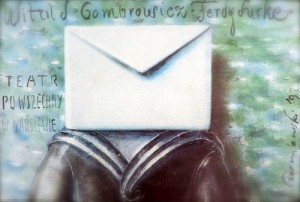 Despite my efforts, I am the world’s worst remote viewer. With only occasional unexciting exceptions, I have had very few “hits” doing this. Recently, however, I modified the protocol to allow my dreams to maybe lend a hand. Instead of going ahead and opening the envelope after attempting to RV its contents, I wait until the next morning to open the envelope. In trying to view the picture inside the envelope the night before, I even imagine the scene of pulling it out of the envelope at the breakfast table; and prior to falling asleep, I silently request my unconscious to deliver information about the picture in the envelope. This has produced interesting and, in a couple cases, actually stunning results. But the results are indirect and symbolic, precisely in dreams’ usual evasive manner, and in one case my dream showed me specifically the “scene of confirmation” rather than the picture I was trying to RV.
Despite my efforts, I am the world’s worst remote viewer. With only occasional unexciting exceptions, I have had very few “hits” doing this. Recently, however, I modified the protocol to allow my dreams to maybe lend a hand. Instead of going ahead and opening the envelope after attempting to RV its contents, I wait until the next morning to open the envelope. In trying to view the picture inside the envelope the night before, I even imagine the scene of pulling it out of the envelope at the breakfast table; and prior to falling asleep, I silently request my unconscious to deliver information about the picture in the envelope. This has produced interesting and, in a couple cases, actually stunning results. But the results are indirect and symbolic, precisely in dreams’ usual evasive manner, and in one case my dream showed me specifically the “scene of confirmation” rather than the picture I was trying to RV.
Let me explain: Late on a Friday evening two weeks ago, I did my usual, meditating in bed and then sketching images and impressions that flashed before my mind’s eye while imagining the scene of opening the brown envelope over breakfast. Then in the morning, I arose and groggily jotted a few notes on the main dream I could recall from the night before: something about a lush, green, idyllic pastoral landscape that was somehow maintained by an advanced futuristic technology.
Although there is nothing more boring than someone else’s dream, I must give a few details because they are significant: In this dream landscape was a group of people of uncertain ethnicity—it seemed significant that they were “dark skinned but not black/African”—who were reluctant to leave their Eden, despite the urging of an affable, white, heroic military man. That man was communicating by phone to some ship that was under attack—I pictured a sea-vessel on fire some distance away at an ocean port or harbor. There was also a scene of two of the “dark skinned” people, a man and a woman, facing each other at close distance, gazing into each others’ eyes almost theatrically, as if they were about to sing a duet to each other.
 Over breakfast, I opened the envelope to reveal the accompanying picture of hands in an upright-open gesture. It bore zero resemblance or connection to my several pages of before-bed scribbled impressions, even by a remote stretch of the imagination. I put it down as another RV failure. However, a little while after breakfast I picked up the picture again and free-associated on it. The first thing that came to mind was the nearly identical gesture of greeting used by the primitive, deeply-tanned Polynesian-style villagers in the original Star Trek Season Two episode “The Apple”—a typical ‘Gnostic’ Trek episode about an ancient planetary computer named Vaal that keeps the planet’s inhabitants in an innocent and ignorant (but idyllic) state of nature.
Over breakfast, I opened the envelope to reveal the accompanying picture of hands in an upright-open gesture. It bore zero resemblance or connection to my several pages of before-bed scribbled impressions, even by a remote stretch of the imagination. I put it down as another RV failure. However, a little while after breakfast I picked up the picture again and free-associated on it. The first thing that came to mind was the nearly identical gesture of greeting used by the primitive, deeply-tanned Polynesian-style villagers in the original Star Trek Season Two episode “The Apple”—a typical ‘Gnostic’ Trek episode about an ancient planetary computer named Vaal that keeps the planet’s inhabitants in an innocent and ignorant (but idyllic) state of nature.
Lost Innocence
The entire original Star Trek series is burned deeply into my neural wiring as a result of a childhood spent watching reruns of the series every afternoon. Although I have not seen “The Apple” in well over three decades, many elements, including the natives’ palms-up greeting, have always stuck with me, and my mild disappointment over a failed RV attempt turned quickly to delight: The picture in the envelope had clearly triggered an association to that episode. (In selecting the picture, my wife could not have anticipated this association because she’s a ST:TNG gal and had never seen “The Apple.”)
 Because it was Saturday, I immediately re-watched “The Apple” on Amazon, to refresh my memory about the episode as well as revel in what seemed like a real psi “hit.” It was even campier than I remember, but it clearly matched closely, or exactly, all the elements I remembered from my dream. But as I reveled in this success, I realized that the dream had not been “about” the image in the envelope at all; it was precisely about what I was right then doing: re-watching a particular old Star Trek episode in a state of eager excitement. My dreaming mind hadn’t peered into the shut envelope, in other words; instead it picked up on the most emotionally salient event in the landscape of my near future. That event bore a chicken-and-egg relationship to the dream that precognized it. It was truly ‘acausal’ or even Moebius-like in precisely the way we should predict could occasionally happen in a science-fictional world where information can travel backward in time.
Because it was Saturday, I immediately re-watched “The Apple” on Amazon, to refresh my memory about the episode as well as revel in what seemed like a real psi “hit.” It was even campier than I remember, but it clearly matched closely, or exactly, all the elements I remembered from my dream. But as I reveled in this success, I realized that the dream had not been “about” the image in the envelope at all; it was precisely about what I was right then doing: re-watching a particular old Star Trek episode in a state of eager excitement. My dreaming mind hadn’t peered into the shut envelope, in other words; instead it picked up on the most emotionally salient event in the landscape of my near future. That event bore a chicken-and-egg relationship to the dream that precognized it. It was truly ‘acausal’ or even Moebius-like in precisely the way we should predict could occasionally happen in a science-fictional world where information can travel backward in time.
If anyone’s innocence is lost here, it should be yours: Time is not what you were raised to think it is. Neither is your own mind.
That sounds preposterous, of course. A skeptic would say, reasonably, that watching the episode was obviously only an effect of my dream and not its cause; however, they would then have to explain the uncanny connection to the hand gesture in the photograph, which was actually the crucial mediating link or “short circuit” in the motivational chain that led to my watching the episode in the first place. In other words, without admitting the precognitive dreaming effect, you would then be forced to posit a “synchronicity” just like the scarab innocently arriving at the window of Carl Jung’s Zurich office at the precise moment his patient was telling him a dream about a man offering her a scarab: You would be forced to say that it was an uncanny meaningful coincidence stage-managed by the universe, or by God, or somehow orchestrated by an “archetype of the collective unconscious.”
I have argued over several posts why it makes no sense that a symbolic formation, by itself, could exert a shaping force on events. Granting “archetypes” this kind of stage-managing power in our lives is truly magical thinking, in a negative sense. We shape our universe to be meaningful, but often unconsciously or unknowingly, through precognitively informed actions that orient toward fulfillment of personal symbolic motifs. “Archetypes” are a perfectly fine concept so long as we take them in this latter, reduced sense. As impossible or even preposterous as it sounds, the simplest explanation for my “Apple” experience is, I believe, exactly what I think really happened in the scarab episode too: a simple case of precognitive dreaming, in which a future signal was amplified because post-hoc actions enhanced particular experienced emotions (namely excitement) during the “scene of confirmation.”
A Jungian Star Trek fan would, of course, point out some obvious archetypal aspects of “The Apple”: the “dark-skinned” villagers or Vaal himself as the shadow, for example, and Kirk as the “serpent” leading to a loss of innocence. But everything has an archetype in it, if you want to look for one. My narrative doesn’t seem to be about lost innocence. My innocence was lost ages ago. If anyone’s innocence is lost here, it should be yours: Time is not what you were raised to think it is. Neither is your own mind. Dreams are a royal road to discovering the bizarre Moebius structure of time and mind; if you are not already keeping a dream diary, what are you waiting for?
Vaal and Redemption
I have argued that psi events build around trivial unremarkable coincidences that we feed and fatten by an imagination and a mentality that is open to magic or psi—“feed,” you might say, rather the same way the inhabitants of Gamma Trianguli VI ritualistically feed their computer god Vaal by pouring offerings of food into its big reptilian stone head.
 The minor objective coincidence between the significance for me of an old Star Trek episode and a picture my wife randomly chose off the Internet by itself was not enough to “power” any uncanny event. What amplified the signal was my (a) interest in psi, expressed through an RV attempt (a kind of ritual), coupled with (b) interest in coincidences (after all, I’ve been writing about them for several weeks on this blog—another kind of ritual), coupled with (c) a habit of delving into and ‘commemorating’ personal symbols that emerge in this path. This combined to produce a recursive spiral of enjoyment that, I argue, generated a precognitive dream.
The minor objective coincidence between the significance for me of an old Star Trek episode and a picture my wife randomly chose off the Internet by itself was not enough to “power” any uncanny event. What amplified the signal was my (a) interest in psi, expressed through an RV attempt (a kind of ritual), coupled with (b) interest in coincidences (after all, I’ve been writing about them for several weeks on this blog—another kind of ritual), coupled with (c) a habit of delving into and ‘commemorating’ personal symbols that emerge in this path. This combined to produce a recursive spiral of enjoyment that, I argue, generated a precognitive dream.
The ritual aspect here is crucial I think. I have found that the ritual of re-watching, re-reading, or purchasing books or TV shows or other things from my formative years that emerge in my psi attempts and synchronicities actually contributes to generating the excitement and epiphanies that precognitive phenomena like dreams and RV attempts pick up on. In other words, honoring and commemorating psi successes and synchronicities actually contributes to creating them, in a kind of feedback effect, and an established habit or ritual of doing so is a crucial “feed-forward” component necessary to actually manifest these psi effects with any regularity. My psi god, if you will, or my personal Vaal-like unconscious self (Vaal=VALIS? … hmmm) responds to my offerings by producing affirmatory anomalies, encouraging this particular path.
Now, if I can just get my inner-child-psi-mind to predict the stock market and not just personal associations to pictures in envelopes, I’ll have achieved something…
Psi, the Enjoyment Body, and the Electric Power of Yes

Like many people, I am fascinated by synchronicities that occur in my life, and I even see them as signposts on my life’s path. Yet the “nuts and bolts” side of me agrees with Arthur Koestler in his wonderful 1972 survey of ESP research, The Roots of Coincidence: Carl Jung’s theory of synchronicity is a muddle, little more than a label slapped onto a mystery without really offering any illumination. In this, it is a bit like the 17th-Century concept of “phlogiston,” the postulated fire-like element that was proposed to cause substances to combust before scientists discovered oxidation reactions. Synchronicity seems like a placeholder concept, awaiting a better, more coherent story.
We have the power to create or nurture optimal conditions of our personal unfoldment and realization of our intentions; we simply need to take seriously the power of coincidence in our lives.
Several of my recent posts have attempted to offer a relatively simple mechanism for synchronicity, via psi. In a universe where information from the future can influence us, even just on an unconscious level, it must produce the kinds of complex impossible scenarios familiar from time-travel stories in science fiction, including both “grandfather paradoxes” and, occasionally, self-amplifying or self-confirmatory feedback loops resulting in truly uncanny-seeming coincidences. I’ve also suggested that the Lacanian concept of jouissance or “enjoyment” may be a kind of carrier of psi information through time—or at least may somehow mediate psi—and thus may provide a better language for talking about psi’s science-fictional effects than the Jungian language of synchronicity and archetypes.
 Still, there is an unmistakeable suggestiveness to the word “synchronicity” that is undoubtedly part of its appeal and staying power: Seemingly modeled on the word “electricity,” synchronicity implies a dynamism and some sort of energetic current. Jung clearly intuited that this thing, this acausal connecting principle, was less like the static sticky “cords” and other subtle connections described in the Theosophical and spiritualist literature of his day and more like a dynamic energy that moved and flowed among material configurations and mental forms, ideas, and symbols. It’s a thing in motion that, when touched, might shock you, and may be capable of short-circuiting; it may be capable of destroying you if you’re not careful. An archetype, as Jung described it, is like a battery for storing and releasing this energy.
Still, there is an unmistakeable suggestiveness to the word “synchronicity” that is undoubtedly part of its appeal and staying power: Seemingly modeled on the word “electricity,” synchronicity implies a dynamism and some sort of energetic current. Jung clearly intuited that this thing, this acausal connecting principle, was less like the static sticky “cords” and other subtle connections described in the Theosophical and spiritualist literature of his day and more like a dynamic energy that moved and flowed among material configurations and mental forms, ideas, and symbols. It’s a thing in motion that, when touched, might shock you, and may be capable of short-circuiting; it may be capable of destroying you if you’re not careful. An archetype, as Jung described it, is like a battery for storing and releasing this energy.
Whatever terminology we choose to adopt, the question that must ultimately motivate any research into the actual functioning of psi and coincidences would have to be: Can we weave it into our theories of how things happen enough that it could be predictive of events outside the laboratory? If treated in the right way, is it also capable of powering something? Can we harness this substance or this energy?
A Duh Experience
As I was finishing my recent post about my “eureka” that synchronicities are illusions created when personally significant but minor coincidences are unconsciously amplified through atemporal feedback loops, my eureka quickly degraded (as eurekas often do) to more of a “duh.” My basic idea was nothing that many practitioners of ritual or chaos magic, or for that matter many adherents of various positive-thinking philosophies, would disagree with, even if I was drawing on different metaphors. Essentially, we have the power to create or nurture optimal conditions of our personal unfoldment and realization of our intentions; we simply need to take seriously, if not fervently believe in, the power of coincidence (and, by extension, magic and meaning—or psi, as I prefer to call it) in our lives. It is exactly this orientation to coincidence that helps us boostrap our condition in a favorable direction.
Enjoyment is the most basic, amoral, childlike power of “yes,” which can even be thought of as extending both forward and backward through time like an atemporal power current in our lives, linking past and future into a timeless electric present.
A characteristic of synchronicity is that people often interpret it as a confirmation of being on the right track, following the right path, doing what they’re supposed to be doing—”God winking” is how one person put it to me recently. Even if synchronicities are really illusions based on failure to see that we live in a Phil-Dickian universe and that we ourselves are unconsciously creating these self-confirmatory circumstances, they’re nevertheless an indicator of a productive habit with high payoff: noticing, paying attention, being alert to the mysterious. One reason to shift from the vague and neutral language of “synchronicity” to terms of Lacanian psychoanalysis is that the latter idiom indicates just what it is we are really detecting when we notice a coincidence: We are detecting our enjoyment. Orienting to psi and coincidence is really an indirect but potentially powerful way of making enjoyment our life compass.
This is because it is precisely the giddy enjoyment of confirmation that is the “energy” at the heart of coincidences. The gratification that ensues when the objective world confirms our innermost beliefs, expectations, and wishes—even when there is a bad or even calamitous implication to the confirming event itself—can be picked up on in advance of the stimulating event. In the context of suffering-causing neuroses, Freud called these “secondary benefits,” but even though it is a kind of pretentious foreign word, I kind of like “jouissance” because it connotes an enjoyment that could be either euphoric or harmful, even deadly, depending on our attitude. Prophetic jouissance is our enjoyment at the uncanny, including our own seeming uncanny powers, even when they have directed our attention toward or anticipated something terrible.
 Enjoyment in this sense is the most basic, amoral, childlike power of “yes,” which can even be thought of as extending both forward and backward through time like an atemporal power current in our lives, linking past and future into a timeless electric present.
Enjoyment in this sense is the most basic, amoral, childlike power of “yes,” which can even be thought of as extending both forward and backward through time like an atemporal power current in our lives, linking past and future into a timeless electric present.
“Follow your bliss” was how the Jungian mythologist Joseph Campbell famously phrased his prescription for the good life, and as a philosophy of life or life principle there is probably none better or more universal. “Bliss” is just the ancient Anglo-Saxon word for enjoyment (bliðs); Campbell’s recommendation could be understood as an ironclad law if we understand enjoyment in its psychoanalytic meaning, as something we are always following but that actually causes us pain when we are living in a state of ignorance about what it is we truly enjoy and how we are getting our enjoyment secretly.
Thus Campbell could really have said: Know what your bliss is, because you can’t help but follow it. And there, he’d be right in line with any psychoanalyst, Freudian or Lacanian, not to mention the Buddha (overcome ignorance), or pretty much any philosopher in the West (know thyself). Knowledge over ignorance is hard to question as a recipe for health and happiness. Because it is really unavoidable, bliss has a circular quality, and when we try to translate it into linear and logical terms, it produces the tricksterish and sci-fi effects that arise in a world that resolutely only believes in linear causality.
Turtles All the Way Down
I have often dimly noticed that the truest statements seem to have a fractal, recursive, self-similar quality: They are like the Indian story of the world resting on the back of the turtle, which rests on the back of another turtle, and it is turtles all the way down. Logicians and psychologists hate such things: Infinite regress and its variant, circular reasoning—that is, self-confirmation—are the very definition of error and fallacy. But self-confirmation is really the scandalous secret at the heart of language. Linguistic meaning can only ever rest, ultimately, on empty, circular, self-reference.
Bliss has a circular quality, so when we try to translate it into linear and logical terms, it produces the tricksterish and sci-fi effects that arise in a world that resolutely only believes in linear causality.
This was Lacan’s great insight about the Symbolic register which entraps us as humans and causes all our neurotic suffering: The only thing that pins arbitrary symbols in place is the gaping holes in that structure, the empty signifiers like proper names (e.g., “the Name of the Father”) and empty ideological constructs (e.g., “freedom”). These holes structure the slippery maze of more mundane signs, the same way supermassive black holes provide the structure to a galaxy: Without these empty or self-circular terms, language would be a slippy-slidey indeterminate nonsense soup. The only “really real” is outside of symbols and language altogether. For this reason, the truest statements—really, the only true statements—are those that are circular or otherwise nonsensical, that have no traction within the symbolic but eject us out of the symbolic into the Real, which is the domain of enjoyment/bliss.
Paranormal phenomena including psi and precognition have precisely this symbolically traction-less, illogical, circular—and I would argue, covertly blissful—quality. If and when we acknowledge their reality (despite their resolute illogic), then it gives circularity a new kind of force and truth. It is precisely our own entrainment to psi-confirmatory events (coincidences) through making a habit of noticing and perhaps commemorating them which causes our actions and our lives to assume a more meaningful, archetypal shape—a sort of positive version of what Lacanian psychoanalysis (which generally deals with dysfunction) calls a “symptom.” In other words, through a circular and self-fulfilling logic, not only belief in but also enjoyment of coincidence enables us to harness, or is a prerequisite for harnessing, our unconscious psi capacities for our benefit.
 As some kind of atemporal, nonlocal constant in our lives, I’m almost tempted to call this self-confirmatory power of agreement the “enjoyment body” or sambhogakaya described in Buddhist philosophy (part of the trinity that includes the dharmakaya or “essence body” and the nirmankaya or physical form-body). It is like our atemporal being, our “long body,” like the world-line of Minkowskian physics except the continuity is not that of the particles of our physical form but of the nonlocal and unchanging substanceless substance of our bliss, a sort of resonating string extending across our lifespan (and beyond?). It is something we may be only dimly conscious of, and there is always some level of it that remains hidden from view and monstrous, because it is partly beyond morality and takes pleasure even in horror.
As some kind of atemporal, nonlocal constant in our lives, I’m almost tempted to call this self-confirmatory power of agreement the “enjoyment body” or sambhogakaya described in Buddhist philosophy (part of the trinity that includes the dharmakaya or “essence body” and the nirmankaya or physical form-body). It is like our atemporal being, our “long body,” like the world-line of Minkowskian physics except the continuity is not that of the particles of our physical form but of the nonlocal and unchanging substanceless substance of our bliss, a sort of resonating string extending across our lifespan (and beyond?). It is something we may be only dimly conscious of, and there is always some level of it that remains hidden from view and monstrous, because it is partly beyond morality and takes pleasure even in horror.
I remember watching an interview years ago with a sufferer of temporal lobe epilepsy, which gave me some insight into the potential negative dimension of mysticism and why bliss in the face of tragedy is experienced as pain. Temporal lobe seizures sound appealing at first blush, because they effectively are ‘religious’ experiences in which everything is suffused with bliss and an overwhelming sense of rightness—an ecstatic agreement with the universe. But such a feeling can quickly become excessive and oppressive: The patient noted that even horrific events like the Holocaust had that same feeling of ‘blissful rightness’ when he was in the throes of a seizure. If the deeper foundation of the universe is a kind of nondual bliss-rightness, and this is the current that psi taps into, then it is easy to see why normal human cortical functioning may act as a powerful reducing valve on this kind experience. For social creatures, an amoral sense of rightness even in extreme human suffering just cannot be workable; this may account for why psi sometimes feels like playing with dangerous cosmic forces.
9/11, for instance, fulfilled unconscious calamitous wishes even as it horrified us, and consequently it set the bliss current, the enjoyment-body, vibrating in a very particular way, stimulating premonitory dreams beforehand and even, perhaps, inspiring many of the artworks that uncannily ‘foretold’ the event. If it takes deaths and tragedies to make us aware of our larger nonlocal self, do we really want that? Well, some amoral unconscious part of us would say “yes.” That’s the problem, and fascination, of psi.
Tricksters and Meaning
The healthy middle ground, of course, is neither pathological immersion in bliss nor complete ignorance or separation from it, but knowing where it is and being able to draw from it intermittently, as needed. Such is the aim of mystical schools like Zen and other schools of Buddhism (the “middle way”), which aim to put one firmly in contact with the ground of bliss-awareness without being swamped by it.
If it takes deaths and tragedies to make us aware of our larger nonlocal self, do we really want that? Well, some amoral unconscious part of us would say “yes.” That’s the problem, and fascination, of psi.
In its own way, the ideal of health formulated by the later Lacan was not unlike this; he said we need to learn to “enjoy our symptom,” our furtive secret system through which we extract a forbidden extra something that gives meaning to our lives. Because of its dark dimensions, that extra something, that enjoyment, is always somewhat alien, somewhat beyond both pleasure and understanding … but there are different degrees of unknowing. Those who really suffer are those who are in total ignorance about the nature of their bliss, and thus it destroys them. At the very least it may be experienced as a tricksterish fate that constantly reaches in and mocks and parodies their aspirations, undercuts and sabotages their plans, thwarts them in their lives and hopes.
This seems to be the experience of therapists when confronted with some patients who seem to have devious and completely unconscious ways of eliciting punishment and suffering from their universe. For example, the neurotic trapped in a repetitive or obsessive symptom is deriving enjoyment but in a way that is hidden even from him/herself, and thus life for that person may seem like a constant car wreck. Enjoyment isn’t the same as pleasure; we can go without mere pleasure, and many cultures and religions (such as the Calvinism of my own Pennsylvania Dutch ancestors) make a big deal of draining life of as much hedonic gratification as possible, but that’s not the same thing as enjoyment. Even within the denial of the body and its pleasures, enjoyment can be extracted, a kind of furtive Promethean theft of what is truly the fire of life. Without that—without the ability to enjoy in some furtive secret way—then life is not worth living. Enjoyment is another way of saying “the meaning of life,” and people who commit suicide are those who cannot find a way of enjoying, which is another way of saying their life has lost its meaning.
 So, precisely here, the Lacanian notion of enjoyment touches this fundamental thing that is at the core of synchronicity: meaning. When we say a coincidence is meaningful, we don’t mean that in the workaday sense that a word or a symbol has meaning, that it has a dictionary definition or that it can be decoded or put into words at all; we mean it in a larger, existential way—it connects with the secret sustaining substance of our life, our bliss, our atemporal “enjoyment body.” The best synchronicities often read like a confirmation that we are following our bliss in an awake, aware, healthy way. The worst ones—and there seem to be plenty of those—seem like wake-up calls that we are not facing some dark dimension of our enjoyment.
So, precisely here, the Lacanian notion of enjoyment touches this fundamental thing that is at the core of synchronicity: meaning. When we say a coincidence is meaningful, we don’t mean that in the workaday sense that a word or a symbol has meaning, that it has a dictionary definition or that it can be decoded or put into words at all; we mean it in a larger, existential way—it connects with the secret sustaining substance of our life, our bliss, our atemporal “enjoyment body.” The best synchronicities often read like a confirmation that we are following our bliss in an awake, aware, healthy way. The worst ones—and there seem to be plenty of those—seem like wake-up calls that we are not facing some dark dimension of our enjoyment.
Ac-centuate the Positive
Because our tacit precognitive capacity entrains our attention (our noticing) to random coincidences that happen to confirm our desires, expectations, and beliefs, we unknowingly participate in cultivating a universe that conforms to our intentions, and thus the world assumes an increasingly uncannily (or, gratifyingly) familiar and even magical quality—it becomes a more enclosed and secure universe, in some ways similar to the universe of childhood. This of course is one of the criticisms leveled by skeptics: that belief in the paranormal is a reversion to childishness. Because there is no living, respectable contemplative tradition in the rationalist West, mysticism is viewed similarly, even by psychoanalysts, who have seldom been able to see mystical experience other than as infantile regression.
We unknowingly participate in cultivating a universe that conforms to our intentions, and thus the world assumes an increasingly uncannily (or, gratifyingly) familiar and even magical quality.
In his monumental book, First Sight, James Carpenter quotes Jung: “How does it come that even inanimate objects are capable of behaving as if they were acquainted with my thoughts?” Psi, Carpenter argues, arises in that unconscious (you might also say child-like) domain where there is no separation between self and other or between self and objects, and where perception and action merge. I would add that it is the world of what child psychoanalyst D.W. Winnicott called “transitional phenomena,” similar to the “liminal” phenomena described by George Hansen in his also monumental book The Trickster and the Paranormal
. You could say that psi is a natural entailment of the underlying nondual nature of things that mystics have always asserted but that we are unable to consciously experience except in moments of grace or ego-less, wordless rapture, because of the “reducing valve” function of the cortex. This would fit well with the writings of Patanjali on the siddhis, for example, as well as the modern ‘tradition’ of linking ESP to mystical practices like yoga or Tantra (see below). When mystics dive down in meditation, a pure ocean of undifferentiated bliss-awareness is what they often describe.
If our enjoyment is indeed a kind of atemporal acausal connecting principle acting as a magnetic field polarizing our actions and thoughts at all times, then in trying to gain some greater insight into when and how synchronous (and, I’d wager, other paranormal) events happen in our lives, we should pay attention specifically to our enjoyment, not merely our thoughts. Indeed our thoughts, which yogis and Buddhists have always likened to waves in the sea of mind, seem like transient effects or epiphenomena on the surface of enjoyment, formations built out of that more basic and oceanic raw material like the fleeting architectural and mimetic forms generated on the sea of Solaris.
 I think enjoyment may be a truer label for the nonlocal substrate of existence—even material existence—that many antimaterialists nowadays seek using the idiom of “consciousness.” If we adopted the idiom of “jouissance” or “enjoyment” or “bliss” it might open up new ways of thinking about matter in relation to mind, as well as clarifying seemingly unrelated problems like those of artificial intelligence and the nature of sentience. For instance, people talk about computers becoming conscious, but this seems like a canard; the real question is, could they enjoy? (I strongly think, no.)
I think enjoyment may be a truer label for the nonlocal substrate of existence—even material existence—that many antimaterialists nowadays seek using the idiom of “consciousness.” If we adopted the idiom of “jouissance” or “enjoyment” or “bliss” it might open up new ways of thinking about matter in relation to mind, as well as clarifying seemingly unrelated problems like those of artificial intelligence and the nature of sentience. For instance, people talk about computers becoming conscious, but this seems like a canard; the real question is, could they enjoy? (I strongly think, no.)
I also think it is directly relevant that there is a long tradition—what could be called a kind of alt-spiritual or New Age consensus—that positive thinking has a magnetic power or force over health, wealth, etc. This is of course the famous “secret” or “law of attraction” that has been popularized in countless self-help books and that is one of the core ideas examined in Mitch Horowitz’s excellent history, One Simple Idea. Positive thinking is not exactly or necessarily the same thing as enjoyment, but knowing enjoyment—the blissful as opposed to the ignorant, neurotic, resistant, painful kind—seems closely allied to positive thinking. If positive thinking really has some kind of attractive force in the world, some influence that spills over from mind to matter, you might say, then being in touch with our enjoyment would account for it, maybe precisely via the ‘science-fictional’ effects (e.g., atemporal feedback loops or “attractors”) I described.
Shifting from Jung’s language of synchronicity to Lacan’s language of enjoyment enables us to formulate other interesting hypotheses about psi and coincidence that could potentially be tested. For example, it would be an empirical question: Are positive synchronous or paranormal events experienced more by mentally healthy, relatively less neurotic people who are more in touch with their enjoyment? Are tricksterish ones experienced more by neurotics? I don’t know if synchronicity per se has been studied experimentally or how you would go about doing that, but Carpenter cites evidence that the traits of extroversion and optimism are strongly associated with high performance on tests of psi. This makes sense of why gregarious, confident, attention-seeking personalities—for instance folks like Uri Geller or, according to remote-viewing pioneer Russell Targ, Italian women—tend to do well at psi tasks.
Synchronicity and Kundalini
Another reason why rephrasing the concept of synchronicity in Lacanian terms might be an advance is that notions like “bliss” and “enjoyment” are closer to the literally or metaphorically sexualized energies that have in one way or another been linked, both in the West and East, to paranormal experiences and, more broadly, to human potentiality.
 Jouissance in French connotes an orgasm so extreme it is actually agonizing. The maverick Freudian psychoanalyst Wilhelm Reich famously theorized the orgasmic nature of the chi-like energy linking us to the universe and called it “orgone.” Reich’s orgone theory closely resembles other ideas that have emerged again and again in spiritualism and occultism, such as the “odic force,” Mesmer’s “animal magnetism,” Bergson’s “elan vital,” the “mana” of pseudo-Hawaiian shamanism, and in Russia, Nikolai Kozyrev’s “torsional energy field.”
Jouissance in French connotes an orgasm so extreme it is actually agonizing. The maverick Freudian psychoanalyst Wilhelm Reich famously theorized the orgasmic nature of the chi-like energy linking us to the universe and called it “orgone.” Reich’s orgone theory closely resembles other ideas that have emerged again and again in spiritualism and occultism, such as the “odic force,” Mesmer’s “animal magnetism,” Bergson’s “elan vital,” the “mana” of pseudo-Hawaiian shamanism, and in Russia, Nikolai Kozyrev’s “torsional energy field.”
Psychical researchers have always noticed a connection between psychic and paranormal phenomena and sexual development and arousal, frustration of sexual expression, etc. Poltergeists are associated with puberty, for example; remote viewing has been associated with sexual desire by some writers, such as Ingo Swann. The Western sex magic tradition links psychic effects to sex (e.g., chaos magicians often use the orgasm as a portal to the unconscious for the purpose of controlling fate through sigils; the “kalas” in the Typhonian tradition of ritual magic developed by Kenneth Grant are essences of female sexual lubricants produced through arousal; and so on). And most centrally, some Tantric traditions see the fundamental organizing energy of the universe as related to the body and its pleasures, in the form of Kundalini.
The Freudian-sexual framework with its concepts of “libido” and “sublimation” is in some sense just a clunky and very partial theory of this sexual psychic-cosmic energy: Kundalini is the libido extended to the full bodymind, a framework enabling us to see the value of this energy beyond mere reproduction and social dominance concerns (and art) and see how the mystical and even the psychic may draw from the same spring. (According to Jeffrey Kripal, the Bhagwan Rashneesh once quipped that “Freud only got to the third chakra.”) Kundalini might even be thought of as another term for jouissance, although one with its own particular cultural baggage and symbolism and its own particular blind spots. That this energy is believed to ordinarily slumber at the base of the spine could be in part a figurative understanding of the fact that most people are mainly conscious of their survival and sexual concerns and remain relatively ignorant of their “higher” priorities and the more obscure (and sublime) ways they derive enjoyment.
 What we can usefully take from the vertical Tantric schema of Kundalini as a spectrum related to or at least symbolized by the hierarchy of chakras is (at the very least) that there’s a continuum structuring the relationship between the various aspects of the human bodymind and the broader acausal context, and thus that this substance-energy, whatever we choose to call it, might be converted or transmuted or changed in wavelength—all the way from the organismic and the orgasmic “up” to the creative, intellectual, and spiritual. This “transmutation” is intrinsic to the definition of Tantra, as well as to the “inner” traditions of alchemy both in Asia and Europe.
What we can usefully take from the vertical Tantric schema of Kundalini as a spectrum related to or at least symbolized by the hierarchy of chakras is (at the very least) that there’s a continuum structuring the relationship between the various aspects of the human bodymind and the broader acausal context, and thus that this substance-energy, whatever we choose to call it, might be converted or transmuted or changed in wavelength—all the way from the organismic and the orgasmic “up” to the creative, intellectual, and spiritual. This “transmutation” is intrinsic to the definition of Tantra, as well as to the “inner” traditions of alchemy both in Asia and Europe.
Other mystical models start instead from the top and work down, privileging cosmic or heavenly energies or awareness or gnosis and deriving “lower” forms from them. One could include the Western Hermetic tradition here, as well as the “higher Tantras” of Asia, including Dzogchen, which privileges an oceanic Void of pure bliss-awareness and is, according to Targ, the royal road to developing ESP abilities. (If that’s the case, Zen, which is nearly identical to Dzogchen in its privileging of the unborn Void, bypassing ’transmutation’ of baser energies in favor of self-extinction of ignorance and desire, should be equally useful.)
Inner Conspiracies and Paranormal Enjoyment
In any case, and through whatever symbolic language or practice we adopt, the theory I’m putting forward suggests the way to move forward in a science fictional universe is to get clear about our enjoyment: What are we enjoying, and how?
Include the knower in the known by including the enjoyer in the enjoyed: What secret benefit or bliss do you get from your particular surreptitious bargain with reality?
Note, this is a very different question from that of desire—i.e. what do you want, which tends to be the focus of most therapy and even of much magical practice in the form of intention-setting. Desire and want point to lack, which is the underpinning of our insecurity and the motor of our forward motion in life. But even in our lack, even in the midst of our deprivation, we are enjoying. We enjoy our desires and our states of lack in very obscure ways, and thus cutting through desire to enjoyment is the key. In other words, include the knower in the known by including the enjoyer in the enjoyed: What secret benefit or bliss do you get from your particular surreptitious bargain with reality? What in you does your symptom serve, and why? Examine your secret sources of enjoyment, and then come clean about it, if only to yourself.
This kind of enjoyment-examination is perilous. Psychoanalysis lasts so long because the analyst is perceived as trying to steal away the patient’s secret enjoyment, so years and years of resistance have to be overcome through attrition and trickery, like a shamanic cure but in slow expensive motion. It seems to me that private self-examination in meditation should be a much more direct and fruitful approach than this kind of frontal assault, because all it requires is self-honesty: You can keep your enjoyment a secret, in the end.
Enjoyment-examination (or perhaps, bliss-analysis) has direct and special relevance to those of us with an interest in psi and other liminal, paranormal topics, and who ‘want to believe.’ If you are honest with yourself, you may find you are in a very weird and precarious position with your enjoyment of this subject matter. What do you enjoy believing, and why do you enjoy believing it? Why do you enjoy believing in ESP, and what would happen if suddenly everybody else believed in it too? What secret benefit to you get from your time spent reading or discussing the topic of UFOs? What would happen if tomorrow there was some public and unmistakeable confirmation of their reality, and a confirmation that they were _______ (fill in the blank: ETs, tulpas, interdimensional beings, or whatever turns your crank)? Would that change how you relate to the subject?
Our enjoyments in this sense are what in a psychoanalytic idiom are called our “unconscious investments.” As in the study of political-economic formations and conspiracies like Watergate, where you “follow the money,” in understanding ourselves—and the nature of psi, and UFOs, and consciousness, and all the rest—we need to follow the bliss. The quagmire of complex unconscious investments in the paranormal fields may account for many of the tricksterish effects described by Hansen … but this is the subject for a later post.
No Visitors: A Non-Silly ETH for Our Silly Times
“At present, utilizing the principal of parsimony, my ‘investigative assumption’ is … that we are dealing with extraterrestrial visitations as the central core of the problem.” Jim Lorenzen
“The evidence is overwhelming that the Earth is being visited by intelligently controlled vehicles from off the Earth.” Stanton Friedman
“I believe that these extra-terrestrial vehicles and their crews are visiting this planet from other planets.” Gordon Cooper
The extraterrestrial hypothesis or ETH was a natural deduction for mid-20th-century observers of the UFO phenomenon, including respectable military folks and astronauts like Gordon Cooper who, in the same breath as acknowledging flying saucers’ reality, stated confidently that these were ships crewed by beings from other planets. The science and science-fiction of that era made such a hypothesis inevitable. But while science has moved on, that retro sci-fi vision has proven maddeningly durable; to this day, the public hears “UFO” and still sees in their mind’s eye a spaceship with an extraterrestrial pilot behind the wheel … possibly crashing and dying in the American desert. Over time, the sensible enough ETH became the ETA, the extraterrestrial assumption, which is, unfortunately, no longer quite so sensible.
 The ETA has harmed ufology not only by limiting people’s imaginations but also by making it easy for skeptics to parody the whole UFO topic or reduce it to a facile either/or: Either they are little green (or gray) men from other planets flying thousands of light years to get here in little rickety ships or they are just a figment of overactive imaginations. The absurdity of the former picture has driven many smart people into the latter position by default, not realizing there is actually a large and interesting gray area (get it?—gray area?) filled with a veritable zoo of different scientifically plausible possibilities, which writers from John Keel and Jacques Vallee to Mac Tonnies and lots of lesser-known folks have explored in a vast and often thoughtful literature.
The ETA has harmed ufology not only by limiting people’s imaginations but also by making it easy for skeptics to parody the whole UFO topic or reduce it to a facile either/or: Either they are little green (or gray) men from other planets flying thousands of light years to get here in little rickety ships or they are just a figment of overactive imaginations. The absurdity of the former picture has driven many smart people into the latter position by default, not realizing there is actually a large and interesting gray area (get it?—gray area?) filled with a veritable zoo of different scientifically plausible possibilities, which writers from John Keel and Jacques Vallee to Mac Tonnies and lots of lesser-known folks have explored in a vast and often thoughtful literature.
To this day, the public hears “UFO” and still sees in their mind’s eye a spaceship with an extraterrestrial pilot behind the wheel … possibly crashing and dying in the American desert.
Embedded within the simplistic ETA is a corollary that acts as an equally strong fetter on the imagination and is equally powerful ammo in the skeptic’s arsenal: the assumption that UFO encounters (if real) would represent some sort of visitation. That imaginary spaceship with the ET pilot at the steering wheel only makes sense within the context of beings who actually live somewhere else, take long treacherous journeys to our world to spy on us or study us, and intend to go home afterward. Over on UFO Conjecture(s), Rich Reynolds recently put the silliness of that idea in perspective by pointing out the spec-like insignificance of Earth in the galactic scheme of things and the true vastness of cosmic distances. We’re a backwater, he says, and for this reason, any notion of our planet and its dominant civilization being the object of active, interested, ET visitation is ludicrous.
It was partly this assumption—that ETs would be here in order to ‘visit’ us—that steered Jacques Vallee away from the extraterrestrial hypothesis back in the late 1960s: The sheer number of recorded (let alone estimated) encounters is way too many, and goes back way too long in history, to represent some Apollo-style space program of ET space missions to fly here, collect a few soil samples and rocks, get some sperm and egg cells from hapless earthlings, and then return home. It’s also worth noting that while Carl Sagan always pitched for the skeptical team, his imagination, fully on board with the existence of ETs “out there,” followed a similar logic when it came to the question of visitation: They would stop by for visit to check things out, but only every few thousand years or so. That would somehow be enough to gather the information necessary.
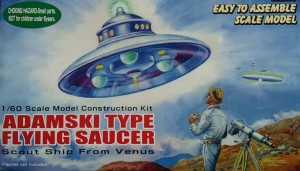 It’s hard not to agree with Reynolds: ET visitation is ludicrous. But I also think the ET hypothesis (not assumption) has a great deal of residual merit so long as we discard the whole notion of “visitation,” radically revise our notion of what we mean by “ET,” and bring our picture of possible ET motives and methods more in line with our current understanding of science, space exploration, and our own future evolution.
It’s hard not to agree with Reynolds: ET visitation is ludicrous. But I also think the ET hypothesis (not assumption) has a great deal of residual merit so long as we discard the whole notion of “visitation,” radically revise our notion of what we mean by “ET,” and bring our picture of possible ET motives and methods more in line with our current understanding of science, space exploration, and our own future evolution.
Flesh and blood beings piloting spaceships across vast light years to visit us is indeed silly—and we’d be doing ourselves a favor if we educated the wider public that that’s not what we mean by “UFOs.” On the other hand, permanently entrenched local machine proxies—drones—conducting long-term dispassionate surveillance on behalf of one or more advanced (probably very ancient) ET civilizations for both science and security purposes—or what I have called “deep anthropology”—is not nearly as silly a hypothesis. To see why, we simply need to think realistically about our own future presence in space while bearing in mind the mathematical models showing that the galaxy’s earliest civilizations should already have a presence, of some sort, throughout it.
The Real Fermi Paradox
Enrico Fermi famously asked his Los Alamos colleagues over lunch in 1950, “Where are they?” This question presupposes two things: that “they” (ETs) will have some motive to come here, and that “they” aren’t here already. It was a sensible question at the time: Mathematical sophisticates like Fermi knew that we were unlikely to be alone; and they also calculated that, even given the enormous distances that would be involved in interstellar travel and colonization, in a universe “of a certain age” (as we might say politely), we ought to be newcomers in an already loud, bustling cosmic metropolis. The various mathematical models showing that our galaxy, including our backwater, should already be colonized by the civilizations that first emerged has been taken by some as evidence that there may be something wrong with our assumptions. Indeed. I would restate the Fermi paradox as the following hypothesis: They’re here already and (paradoxically) they never left home.
 The problem is the assumption of outward travel and expansion as an inevitable or even likely path for an advanced technological species. Fragile, mortal beings have an impulse to have big families, grow, and spread, colonizing new real estate in the name of Lebensraum, “living room.” Most of recorded human history fits into such a picture, and so it was natural to project such an assumption onto our own future and, by extension, onto ET. But as countless more recent futurians and SF writers have promised, we are approaching some kind of cusp—a technological and social perfect storm that, even in its most conservative versions, will change the game in all kinds of ways that just couldn’t be envisioned or imagined 65 years ago. When you recognize that a society must evolve in tandem with its technology, that assumption of outward spread “in the flesh” looks less and less plausible.
The problem is the assumption of outward travel and expansion as an inevitable or even likely path for an advanced technological species. Fragile, mortal beings have an impulse to have big families, grow, and spread, colonizing new real estate in the name of Lebensraum, “living room.” Most of recorded human history fits into such a picture, and so it was natural to project such an assumption onto our own future and, by extension, onto ET. But as countless more recent futurians and SF writers have promised, we are approaching some kind of cusp—a technological and social perfect storm that, even in its most conservative versions, will change the game in all kinds of ways that just couldn’t be envisioned or imagined 65 years ago. When you recognize that a society must evolve in tandem with its technology, that assumption of outward spread “in the flesh” looks less and less plausible.
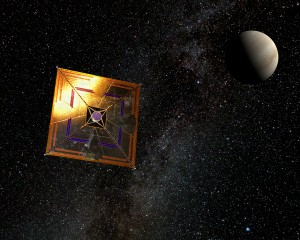 Spaceflight capacity will only emerge alongside commensurate leaps in computing and robotics, and along with those, massive advances in energy production, matter manipulation (e.g., 3D printing and nanotech), and most importantly, biotechnology advances like genetic engineering and all the “-omics” of today’s cutting-edge health and medical science (e.g., genomics, proteomics, transcriptomics, etc.). Together, these bundled developments will not only tend to automate the business of space exploration but will also radically extend our lives, which will disincentivize the kinds of interstellar migration and colonization (and empire building) that Fermi’s generation had no reason to doubt and that generations of SF writers dramatized in their space operas. They made great stories, but those futures are wildly unrealistic from the standpoint of “existential futurology.”
Spaceflight capacity will only emerge alongside commensurate leaps in computing and robotics, and along with those, massive advances in energy production, matter manipulation (e.g., 3D printing and nanotech), and most importantly, biotechnology advances like genetic engineering and all the “-omics” of today’s cutting-edge health and medical science (e.g., genomics, proteomics, transcriptomics, etc.). Together, these bundled developments will not only tend to automate the business of space exploration but will also radically extend our lives, which will disincentivize the kinds of interstellar migration and colonization (and empire building) that Fermi’s generation had no reason to doubt and that generations of SF writers dramatized in their space operas. They made great stories, but those futures are wildly unrealistic from the standpoint of “existential futurology.”
Immortality will radically reduce, among other things, the family and reproduction, and thus ultimately eliminate the need to spread beyond one’s safe cozy planet or, at least, one’s radically terraformed (or Dyson-sphered) solar system.
We can already see that as longevity increases, family size dwindles. Today’s humans fortunate to live in advanced prosperous societies and to expect 80+ year lifespans don’t have as many kids as their shorter-lived ancestors did. Follow the curve: The standard old notion of human family groups spreading out across the galaxy in vast waves of colonization represents a failure to imagine the most radical (and probably, realistic) promise of the Singularity: near or total immortality via some combination of bioengineering and machine augmentation. It won’t necessarily happen by the middle of this century, as the most rapturous of the nerd rapturologists promise, but it will probably happen at least in the next. Immortality negates any vision of the future resembling our present society; it will radically reduce, among other things, the family and reproduction, and thus ultimately eliminate the need to spread beyond one’s safe cozy planet or, at least, one’s radically terraformed (or Dyson-sphered) solar system.
Consider the most sociologically rich and coherent literary vision of a far future interstellar society, Frank Herbert’s Dune series. It is highly significant that Herbert’s sprawling galactic empire required an ingenious literary contrivance—an ancient, strict prohibition on computers—to make its far-future vision plausible. Without the Butlerian Jihad, all of the dramatic and exciting aspects of the Dune universe—mortal humans traveling across space, engaging in deadly feudal politics involving matters of resource scarcity, protecting and nurturing genetic bloodlines through sex, waging bloody interplanetary war, and all the rest—would actually make no sense whatsoever. A technologically advanced far future will not look like the Dune universe, or the galactic empire of Asimov’s Foundation Trilogy, or the Star Wars universe, or the Star Trek universe. It is liable to look much more like the most ‘advanced’ (and outwardly kind of boring) cultures in Tolkien’s Lord of the Rings. This is because, besldes eliminating any need or motive for interstellar travel ‘in the flesh,’ immortality will also eliminate or redefine that prized redeeming feature of ‘mortal men doomed to die,’ namely courage.
The Future of Bravery
One of the first principles of existential futurology is that, counterintuitively, the preciousness of life increases with its length. A nasty, brutish, and short existence encourages not only having lots of babies but also risking life and limb for a better tomorrow for those babies, including sometimes getting in creaky vessels and emigrating to alien shores and uncertain futures, with the understanding that this life is just a brief painful travail on the way to an afterlife. In contrast, our very-long-lived descendents are likely to be stay-at-home types, materialist in their outlook, and extremely jealous of their safety and health, not unlike Tolkien’s elven races (or, less appealingly, Howard Hughes). Like the elves, they’ll be generally content to let lesser beings do the dirty work of exploration and adventuring on their behalf. For us, those ‘lesser beings’ will be our machines.
 Space travel, no matter how advanced, is bound to be a dangerous, boring pain in the ass. It’s hard to imagine future Galadriels and Elronds being interested in risky journeys across interstellar space in the flesh. They would really have little motive, because they could explore and interact with the cosmos, and even in a sense ‘inhabit’ it, by proxy via machine extensions of themselves—the other realistic promise of nerd rapturology. Scattering self-replicating drones (Von Neumann probes) to blanket the universe and all its worlds, future humans will bring the universe to them and never have to leave the comfort and safety of their Lothloriens and Rivendells. By “machines” and “drones” I of course don’t mean anything we might now recognize as such—these remote sensors and effectors could look organic, or luminous, or be microscopic, or invisible. Who knows. Remember Clarke’s famous technology indistinguishable from magic? That’s what I’m talking about. (And it’s also why we should really be reading Tolkien’s books as science fiction, not fantasy … but I digress.)
Space travel, no matter how advanced, is bound to be a dangerous, boring pain in the ass. It’s hard to imagine future Galadriels and Elronds being interested in risky journeys across interstellar space in the flesh. They would really have little motive, because they could explore and interact with the cosmos, and even in a sense ‘inhabit’ it, by proxy via machine extensions of themselves—the other realistic promise of nerd rapturology. Scattering self-replicating drones (Von Neumann probes) to blanket the universe and all its worlds, future humans will bring the universe to them and never have to leave the comfort and safety of their Lothloriens and Rivendells. By “machines” and “drones” I of course don’t mean anything we might now recognize as such—these remote sensors and effectors could look organic, or luminous, or be microscopic, or invisible. Who knows. Remember Clarke’s famous technology indistinguishable from magic? That’s what I’m talking about. (And it’s also why we should really be reading Tolkien’s books as science fiction, not fantasy … but I digress.)
Even just with today’s iPhone-controlled quadcopters, we are already well on the way to this kind of cyborg expansion of the self. In a century or two, swift, sensitive, powerful drones that are in some sense extensions of our bodies and minds will be exploring and touching and interacting with the wider world for us, being our roving eyes and ears and hands and feet. When we, now, via the Internet, enjoy the latest pictures and feeds from Mars rovers and deep-sea robots, we are getting only the tiniest taste of what that extended sensorium will one day entail as a way of “inhabiting” other environments. With the kinds of robotic technology the next century will offer us, why would we shlep us and our families and our stuff to a shitty, crampted, uncomfortable colony on Titan, or even Mars or the Moon, when we can go all those places, virtually, even all at once (the future of multitasking)? The body and its organic needs, including its location in space, will less and less define and constrain the quality and range of our experience.
The Fermi paradox should be restated: They’re here already and (paradoxically) they never left home.
Lightspeed of course will limit the ‘immediacy’ of our connection to our remoter proxies over planetary and (especially) interstellar distances, and thus our drone eyes and hands will need to be fully autonomous AIs, making decisions for themselves, repairing and replicating themselves, and engaging not only in passive observation but also active knowledge-gathering and even experimentation. In other words, the drones we send far and wide out into the galaxy will actually be fully self-guided science platforms, patiently and relentlessly gathering data to generate rich similations back on the homeworld. These proxies will be the sleek smart descendents of Voyager or the Curiosity rover, but able to make their own decisions, although (and this is an argument too big for this article) not themselves sentient (see here for why). We will experience and inhabit the universe through that technology—no ‘visitation’ needed.
It’s a reasonable hypothesis that the same basic technological/social trajectory will apply to any technological civilization that has emerged “out there,” and thus any ET presence here will be an automated, machine-mediated presence. There would be no “visits,” because dangerous visitation across vast light years by creatures who place a great value on their lives simply makes no sense. Our advanced older relatives, cosmic patriarchs and matriarchs, won’t shlep to see us backward nobodies out here in our backwater; they’ll stay at home, like Grandma and Grandpa, preferring (if there is to be any visiting) that the youngsters come to them—perhaps through some exotic technology like wormholes … which indeed could be what some UFOs are. Apparent “visits” by such beings would, at most, be simulations or avatars, not “real presence” in the sense we-the-still-meat-bound understand it.
Deep Anthropology
If we imagine post-scarcity ET civilizations able to send out self-replicating science machines that multiply and propogate to every corner of the home galaxy, copying themselves and digging in for the long haul wherever they find interesting things happening, and we also imagine (as the mathematics dictates) that the first such civilizations will have arisen billions of years ago, then the two-plus-two-equals-four of the matter is this: ET science platforms are probably already here, and probably were here even back before we were tree shrews … maybe before we were even algae. These machines would be so advanced, we’d likely not even know they were here … except, that is, when the purpose of a specific experiment or intervention required it.
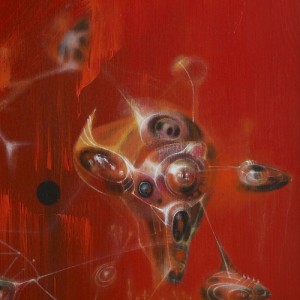 It is crucial, in this picture, to remember that an advanced spacefaring race, including ourselves in the coming centuries, will not be limited to the kinds of sparse data collection allowed by the Apollo missions or even the Curiosity rover. Computing and robotics enable exponential increases in the amount of data a space program can collect, transmit , store, and analyze, all with a minimum of direct human involvement. And the fundamental principle of basic science—learn all you can, whether or not it has foreseeable real-world payoff—dictates that there are no desirable limits to such learning. Learning isn’t just observing, it’s conducting controlled experiments with large samples and then repeating them many times to achieve a high level of prediction and control. When resources permit and it can be totally automated, any scientific space program will attempt to “know all that is knowable,” like V’ger in Star Trek: The Motion Picture, ignoring the question of application. This generates what is nowadays being called “big data.”
It is crucial, in this picture, to remember that an advanced spacefaring race, including ourselves in the coming centuries, will not be limited to the kinds of sparse data collection allowed by the Apollo missions or even the Curiosity rover. Computing and robotics enable exponential increases in the amount of data a space program can collect, transmit , store, and analyze, all with a minimum of direct human involvement. And the fundamental principle of basic science—learn all you can, whether or not it has foreseeable real-world payoff—dictates that there are no desirable limits to such learning. Learning isn’t just observing, it’s conducting controlled experiments with large samples and then repeating them many times to achieve a high level of prediction and control. When resources permit and it can be totally automated, any scientific space program will attempt to “know all that is knowable,” like V’ger in Star Trek: The Motion Picture, ignoring the question of application. This generates what is nowadays being called “big data.”
If we imagine post-scarcity ET civilizations able to send out self-replicating science machines to every corner of the home galaxy, then those machines are probably already here, and probably were here even back before we were tree shrews … maybe before we were even algae.
I argued a couple years ago on this blog that the “thin-slicing” notion of science implicit in Vallee’s important 1989 paper arguing against the ETH is not only rendered obsolete by the leaps in computing and robotics of the two and a half decades since then but also rendered unrealistic by the ways actual social science and psychology are conducted. To produce valid and useful results, any study of us by an extraterrestrial entity (machine or otherwise) would have to be an active, open-ended, longitudinal experimentation project not unlike the scenarios that unfold in psychology laboratories on any university campus, although on an immeasurably vaster scale: bizarre interactions designed to test oddball hypotheses, conducted with large enough samples of people to yield statistically significant results (along with equally large control groups for comparison), and then repeated with other pristine samples to replicate the findings, and then followed up with different permutations of the experiment (and new control groups) to test different hypotheses that emerge, and so on, ad infinitum.
 When you revise your picture of ‘ET Earthology’ as a massive, mostly stealthy, and truly neverending psychology project conducted by artificially intelligent but unsentient science machines, who never get bored and are programmed to know all that is knowable—including achieving a high degree of predictive power over the collective and individual behavior of an unpredictable and continually evolving intelligent species—then the millions of “landings” in history start to look less and less excessive. Indeed, it all starts to look very much like the “control system” Vallee himself postulated. Without meaning to, I think it is Vallee, with his most nuanced understanding of the UFO phenomenon, who gives the most support to the basic hypothesis he saw his own work as challenging: a plausible ET origin for at least a portion of the millions of UFO encounters down through the ages.
When you revise your picture of ‘ET Earthology’ as a massive, mostly stealthy, and truly neverending psychology project conducted by artificially intelligent but unsentient science machines, who never get bored and are programmed to know all that is knowable—including achieving a high degree of predictive power over the collective and individual behavior of an unpredictable and continually evolving intelligent species—then the millions of “landings” in history start to look less and less excessive. Indeed, it all starts to look very much like the “control system” Vallee himself postulated. Without meaning to, I think it is Vallee, with his most nuanced understanding of the UFO phenomenon, who gives the most support to the basic hypothesis he saw his own work as challenging: a plausible ET origin for at least a portion of the millions of UFO encounters down through the ages.
In the Noöverse, No One Gives a S***
Via Von Neumann machines, an automated and autonomous program of “knowing all that is knowable” can scour the star systems and planets of the universe without the expenditure of any of Lothlorien’s or Rivendell’s resources and without any mental effort or care on the part of its inhabitants (if they are even still alive after all this time). Thus, we shouldn’t feel special: Even if Earth is under a microscope (or a million microscopes), so is every other planet out there, probably even the ones with nothing more interesting going on than tree shrews and algae. Maybe even all the asteroid belts and Oort clouds have probes patiently scouring and mapping every slowly tumbling chunk of dust and ice.
Our advanced older relatives won’t shlep to see us out here in our backwater; they’ll stay at home, like Grandma and Grandpa, preferring (if there is to be any visiting) that the youngsters come to them.
Such a picture gives a new meaning to “known universe.” Just based on the mathematics of the matter, the universe should be fully known, multiply known, by ancient and very advanced technologies if not by the sentient beings that originally created them. We might even call it a noöverse, for this reason. (A couple of years ago I wondered if the mountains of data this would generate could be so huge that information could account for the missing mass of today’s cosmological models, somehow sequestered into the very fabric of spacetime by ancient V’gers scouring the galaxies. A reader versed in quantum computing helpfully corrected me: Information storage tends toward the miniscule; thus, whatever dark matter is, it ain’t vast and ancient servers and hard drives.)
This is hardly the only or best answer to the UFO problem, but I do think it is a more mature (and interesting) version of the ETH that is at least plausible both exo-technologically and exo-sociologically and thus worthy of putting forward for consideration and debate alongside the various contending (and equally meritorious) anti-ETH contenders, including the interdimensional (Vallee), cryptoterrestrial (Tonnies), ultraterrestrial (Keel), and various other psychological or esoteric hypotheses. It just needs to replace the easily trivialized “visiting UFO pilot” narrative that popular culture and the media (and unfortunately also some in the ufology community) still can’t seem to get past. (And no, I don’t expect the much-anticipated “Roswell Slides” are going to change my assessment; whatever is in those pictures, I doubt it is ETs.)
With all due respect to the ET visitation proponents of the past century, another part of what makes the old “UFO pilot” scenario increasingly hard to fathom today is precisely, as Reynolds said in his blog, our own smallness in our ever-widening cosmic picture: In a galaxy of 400 billion suns that probably has harbored, at times, many advanced civilizations and must be constantly teeming with astonishingly diverse flora and fauna, not to mention cool geology and exotic stellar and planetary objects of all types, it’s terribly anthropocentric to imagine that ancient eminences or their machine successors care all that much about us and our little blue planet, however Edenic we like to imagine it. Coming here is ridiculous—why bother even sending drones here? In a huge and fascinating universe, doesn’t that level of attention presume a level of giving a shit that is neurotic to say the least, or even insane?
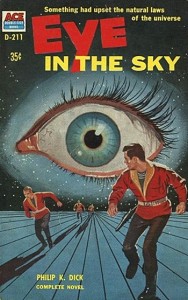 Actually, it doesn’t. With Von Neumann machines, giving a shit can be automated and outsourced to nonsentient (read: not-actually-giving-a-shit) technology that multiplies like rabbits and does science on its own initiative. And there’s another very good reason, quite apart from the basic science imperative (i.e., knowing all that is knowable), for keeping a constant machine eye on what is happening around every single one of those 400 billion suns, and that is security. That same first principle of existential futurology already mentioned—the preciousness of long lives—also predicts that immortal ETs would put in place a vast, ultimately galaxy-wide network of machine surveillance purely as a security measure. The gaze is, surely, quite dispassionate, but to be effective, it would also have to be very comprehensive and far-reaching.
Actually, it doesn’t. With Von Neumann machines, giving a shit can be automated and outsourced to nonsentient (read: not-actually-giving-a-shit) technology that multiplies like rabbits and does science on its own initiative. And there’s another very good reason, quite apart from the basic science imperative (i.e., knowing all that is knowable), for keeping a constant machine eye on what is happening around every single one of those 400 billion suns, and that is security. That same first principle of existential futurology already mentioned—the preciousness of long lives—also predicts that immortal ETs would put in place a vast, ultimately galaxy-wide network of machine surveillance purely as a security measure. The gaze is, surely, quite dispassionate, but to be effective, it would also have to be very comprehensive and far-reaching.
In other words, for the exact same reason nobody is “visiting” us in the flesh, it is also a realistic hypothesis that there is no backwater planet too podunk and no semi-intelligent tool-using species too lame that it will not be home to swarms of unobtrusive CCTV cameras (I like to imagine them as small, softly glowing orbs, but that’s just me) keeping a close eye on how that species is developing and what its likely future actions are. All that obsessive psych-experimentation has the same long-term security payoff: total prediction and control should we or our machines ever pose a threat at some point thousands or millions of years down the long road.
In a subsequent post, I’ll develop this second part of the argument: the long-term security issue as it applies to immortal ETs, why we needn’t fear ET invasion, but also why, in a noöverse, we can have no expectation of privacy.
Prophecies, Time Loops, and Bubble Realities: La Jetée and The Sacrifice
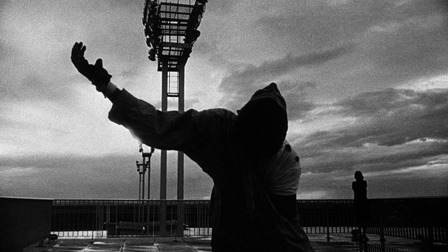
If precognition is real, then we have to take account of the range of sci-fi effects it would produce, effects that go beyond the strictly ‘prophetic.’ Because we fail to see how our consciousness is receptive to the future and how our actions contribute to, and only in a minority of cases confirm, that future, we fail to recognize the range of effects that Chaos Theory would predict should occur.
The most common kind of effect would be negation of precognitive information because our freely willed actions cancelled the validity of that information and turned it into noise. In such cases, we would never even know the precognitive information was information, so it can be ignored. This first possibility I already dealt with in my “Psi of Regret” post a few months ago: There are all kinds of reasons why, in a universe full of conscious, freely willed actors, precognition would tend to negate itself.
The downside of taking responsibility as a freely willed being in the universe is being unable to ever say for certain whether prophecies are genuine.
Less commonly, though, feedback effects would result in an intensified significance to coincidental events, or what people often call a “synchronicity”; our failure to believe in psi or to acknowledge our own (unconscious) role in this feedback loop produces the illusion that some meta-symbols have a cosmically ordering power in these events (i.e., Jung’s concept of archetypes). This more interesting and rarer fork in the bifurcation predicted by Chaos Theory, the intensifed phenomenon of the synchronicity as a kind of ‘attractor,’ is interestingly explored in the film Don’t Look Now, the subject of my last post: Misrecognizing a precognitive vision as present reality produces a synchronistic perfect storm that ends up claiming the life of a hardened materialist skeptic.
In Don’t Look Now, the events set in motion by the protagonist’s failure to include the knower in the known are precisely what enable the future to control his fate: Our fate is only predetermined when we do not recognize our own free will, and fail to see that our awareness encompasses our life and death—that it exists to some degree outside of time and can see into the future and the past.
Chris Marker’s wonderful 1963 short film La Jetée, composed almost entirely of still images, is another beautiful expression of this idea.
Misrecognition and Time Loops
In La Jetée, desperate subterranean survivors of a nuclear holocaust in post-nuclear-war Paris have developed the technology of time travel—in the form of a psychoactive drug—as a means to summon aid and resources from the past and future. To test it out, they select a war prisoner as a guinea pig, based on his strong fixation on an image from his childhood: a beautiful woman watching a man shot to death on the observation platform (“jetty”) at Orly Airport. Holding a powerful image in mind is necessary to stabilize the time traveler’s presence in the destination time.
 After initial abortive attempts, the test subject is able to maintain himself in the past, and finds the woman of his childhood image. They wander together around prewar Paris, visiting museums and parks, falling in love—at one point, standing before a cut tree trunk with dates assigned to the different rings, he points to a spot in the air outside the tree’s circumference and says “This is where I come from.” But he is not allowed to stay in this idyllic past; his jailers retrieve him and send him to the future to retrieve needed technology to help the human race survive—the mission he was always intended for. Having accomplished this, his jailers return him to his cell, his role in their plans now complete. However, he is mentally contacted by beings from the future who are able to grant his wish to return to his lover in prewar Paris. When he goes back in time—he hopes permanently—he sees her at Orly jetty and runs toward her, but is shot by one of his prison guards, who has followed him back in time. He finally realizes that it was his own death he had seen as a child.
After initial abortive attempts, the test subject is able to maintain himself in the past, and finds the woman of his childhood image. They wander together around prewar Paris, visiting museums and parks, falling in love—at one point, standing before a cut tree trunk with dates assigned to the different rings, he points to a spot in the air outside the tree’s circumference and says “This is where I come from.” But he is not allowed to stay in this idyllic past; his jailers retrieve him and send him to the future to retrieve needed technology to help the human race survive—the mission he was always intended for. Having accomplished this, his jailers return him to his cell, his role in their plans now complete. However, he is mentally contacted by beings from the future who are able to grant his wish to return to his lover in prewar Paris. When he goes back in time—he hopes permanently—he sees her at Orly jetty and runs toward her, but is shot by one of his prison guards, who has followed him back in time. He finally realizes that it was his own death he had seen as a child.
The time loop is broken through the final “interpretation” or moment of insight: ‘It was me all along enjoying this dark, perplexing story (the story of my life).’
The narrator says, as the man from the future steps out onto Orly Jetty the last time, that “confusedly, he expected to see a small boy, his younger self.” Yet there is no such boy there to witness this event, leaving us with the conclusion that his “memory from childhood” was really a precognitive dream or vision of his own death—in other words, exactly the fatal misrecognition that destroys John Baxter in Don’t Look Now. Thus La Jetee, which was the original inspiration for Terry Gilliam’s 12 Monkeys, beautifully illustrates the Lacanian notion of a symptom as a kind of time-loop sustained by misrecognition of trauma, failure to include the knower in the known. The loop is broken through the final “interpretation” or moment of insight: ‘It was me all along enjoying this dark, perplexing story (the story of my life).’
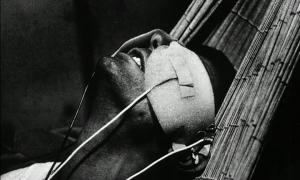 The sustaining ‘enjoyment’ in this fable is explicit in the way that time travel is conflated with a drug experience—a syringe calls to mind a drug addiction, perhaps the purest form of pleasurable-painful-destructive jouissance. When the man is returned to his cell after his “trial runs” in the past, it is as an addict taken away from the source of his enjoyment. We could perhaps also see his need as the thing that opens a door to communication with the future beings who are able to grant his wish for a final, fatal return to the past.
The sustaining ‘enjoyment’ in this fable is explicit in the way that time travel is conflated with a drug experience—a syringe calls to mind a drug addiction, perhaps the purest form of pleasurable-painful-destructive jouissance. When the man is returned to his cell after his “trial runs” in the past, it is as an addict taken away from the source of his enjoyment. We could perhaps also see his need as the thing that opens a door to communication with the future beings who are able to grant his wish for a final, fatal return to the past.
Every film is a Rashomon, though, and there are other ways of interpreting what “really happens” in La Jetée. The entire story of the film could be a fantasy produced in this war prisoner’s dying moments, for example, as in Ambrose Bierce’s “Occurrence at Owl Creek Bridge”: A confederate sympathizer and saboteur is being executed by hanging, from a bridge during the Civil War; the rope breaks, allowing him to escape into the water and flee through the forest to his plantation and the arms of his waiting wife. As he approaches her, he feels the noose tighten around his neck and he “awakens” to the reality of his death.
 But there is also a further possibility, that the real subject of the film is the woman, and that the whole story is her lonely fantasy or dream of a love affair with a man with no past, projected onto the fantasized gaze of a young boy who could be their fantasy child. The fact that the only actual motion in the film is a few seconds of the woman opening her eyes in bed hints at this possibility.
But there is also a further possibility, that the real subject of the film is the woman, and that the whole story is her lonely fantasy or dream of a love affair with a man with no past, projected onto the fantasized gaze of a young boy who could be their fantasy child. The fact that the only actual motion in the film is a few seconds of the woman opening her eyes in bed hints at this possibility.
2 x Double = Toil + Trouble
What happens in a sci-fi universe where time loops and precognition are real and we do include the knower in the known? Here’s where we are caught in a paradox. Negative precognitions or premonitions (John Baxter seeing his own funeral procession, the man from the future seeing his own death) could only be verified if we do not act upon them to change our destiny—and thus, presumably, would only be apparent after the fact, if we consciously fail to recognize their true nature.
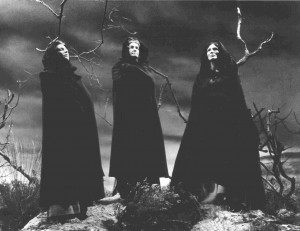 On first glance, Don’t Look Now and La Jetée might thus seem like the opposite of Shakespeare’s Macbeth, where a prophecy destroys because it is obeyed to the letter rather than skeptically questioned or mistaken as involving someone else. But really the effect of willed disbelief or misrecognition is the same as the effect of insecure belief—hastening to fulfill the prophecy lest it not come true, as it were, “on its own.” It is MacBeth’s anxious efforts to fulfill the prophecy that catch him in the witches’ fatal logic and destroy him just as surely as rigid disbelief in the paranormal destroys John Baxter or misrecognition of his ’symptom’ draws the protagonist of La Jetée to his doom.
On first glance, Don’t Look Now and La Jetée might thus seem like the opposite of Shakespeare’s Macbeth, where a prophecy destroys because it is obeyed to the letter rather than skeptically questioned or mistaken as involving someone else. But really the effect of willed disbelief or misrecognition is the same as the effect of insecure belief—hastening to fulfill the prophecy lest it not come true, as it were, “on its own.” It is MacBeth’s anxious efforts to fulfill the prophecy that catch him in the witches’ fatal logic and destroy him just as surely as rigid disbelief in the paranormal destroys John Baxter or misrecognition of his ’symptom’ draws the protagonist of La Jetée to his doom.
True freedom from prophecy seemingly is obtained by believing in the prophesied possibility as a virtual outcome but knowing we have some say in the matter. But the downside of taking responsibility as a freely willed being in the universe is being unable to ever say for certain whether prophecies (our own or those of seers we have faith in) are/were genuine. In a sense, the result is the sketch-like world described by Milan Kundera in The Unbearable Lightness of Being, in which nonrepetition—transience, Heraclitus’s inability to set foot twice in the same river—results in an “unbearably light” insubstantiality to things.
Yet, as I’ve argued before, this suspended belief in prophecy’s ‘hardness’ is the truly healthy stance. We must assume a skeptical distance both from reductive linear materialist causality (“there are no messages from the future”) and from “synchromystic” determinism in which the Big Other somehow perfectly knows us and controls our fate.
What Happens in a Sci-Fi Universe Stays in the Sci-Fi Universe
This middle attitude produces a third, purely theoretically but exotic possibility: that precognitive information will at times produce alternative ‘bubble histories’ that are isolated from the stream of causality through the conscious willed action of the recipient of future information. In a sense, this non-possibility is a theoretical ghost that hovers over all of reality when we acknowledge the existence of information reaching into and affecting the past in a universe that also includes free will.
How could we ever know whether a person’s psychotic or obsessive behavior is not, really, a sacrifice being made to forestall some personal or cosmic tragedy by isolating it in a bubble universe? Are some madmen really martyrs?
A few excellent films have explored this idea in different, creative ways. Donnie Darko is the most obvious: At the end of the film, we realize that the disastrous events leading up to the protagonist’s death are a bubble reality isolated from the time stream by his heroic sacrifice, creating what in theoretical physics has been called a “closed timelike curve.” In many ways, the film is a retelling or permutation of It’s a Wonderful Life, except in that case the negative/feared historical outcome is neutralized/negated by the protagonist not allowing himself to die.
But my favorite exploration of the possibility of a heroic sacrifice saving the protagonist’s universe is Andrei Tarkovsky’s beautiful final film, The Sacrifice. Despite appearances of being a slow (at times, paint-dryingly slow) Bergman-esque chamber drama about an aging artist’s birthday gathering, it is really a science fiction film, and one that all true Forteans owe it to themselves to see.
 Alexander, a former actor now enjoying his retirement with his wife and young son at a beautiful country house in rural Sweden, meets the local postman, Otto, who turns out to be a “collector” of uncanny paranormal occurrences—essentially, a Swedish Charles Fort. Beyond merely collecting and cataloging such incidents, Otto actually goes to great lengths (he says) to verify them.
Alexander, a former actor now enjoying his retirement with his wife and young son at a beautiful country house in rural Sweden, meets the local postman, Otto, who turns out to be a “collector” of uncanny paranormal occurrences—essentially, a Swedish Charles Fort. Beyond merely collecting and cataloging such incidents, Otto actually goes to great lengths (he says) to verify them.
Otto visits Alexander’s country house to give him a rather excessive birthday gift—a precious antique map (he explains that “all gifts require a sacrifice”)—and while he is there, a TV alert somberly announces that a nuclear war has broken out; citizens are urged to stay calm, but the mood is gloomy, and Alexander’s family are able to hear the rockets flying overhead, launched from nearby missile silos. In solitary terror and desperation, Alex prays: He will give up speech and even give up his family and his house to end the war.
 Otto then privately confides in him that there is one chance to save everything—save the world—and that is that Alexander must go to the home of his own servant, Maria—who is actually (Otto says) a witch—and sleep with her. Alex hesitates, but then gets on his bicycle, rides to her house, and fulfills this act. He returns home, falls asleep, and then wakes to find that there is no nuclear war—things are normal, no one is panicked. Was it all a dream? We don’t know. But keeping his promise, Alex falls silent, methodically sets fire to his home while his family is out for a walk, and finally, running around the burning house like an ecstatic (and silent) madman, is taken off by an ambulance.
Otto then privately confides in him that there is one chance to save everything—save the world—and that is that Alexander must go to the home of his own servant, Maria—who is actually (Otto says) a witch—and sleep with her. Alex hesitates, but then gets on his bicycle, rides to her house, and fulfills this act. He returns home, falls asleep, and then wakes to find that there is no nuclear war—things are normal, no one is panicked. Was it all a dream? We don’t know. But keeping his promise, Alex falls silent, methodically sets fire to his home while his family is out for a walk, and finally, running around the burning house like an ecstatic (and silent) madman, is taken off by an ambulance.
Through his sacrificial act, we are led to believe, Alex has not “ended the war” but rather prevented it from ever happening. If only he remembers it, we can ask if he really is a madman, or if he really changed the future through a strange ritual recommended by his Fortean friend. There is no way to know what is “really real,” whether any of it was a dream, and whether his sacrifice (giving up speech and his house and family) is actually a significant history-altering pact with the silent universe … or whether it is just a psychotic break.
 Lacan noted that neurotic rituals are often undertaken to cover over an emptiness, the lack in (or nonexistence of) the Big Other. But if time is multidimensional and looping, and if synchronicities emerge from misrecognized precognition or from double causation (Vallee’s phrase), it raises the possibility of encapsulated bubble histories, like growths or polyps sprouted by the stream of time and severed through some “mad” (or merely neurotic) act—some sacrifice—which may even save the world.
Lacan noted that neurotic rituals are often undertaken to cover over an emptiness, the lack in (or nonexistence of) the Big Other. But if time is multidimensional and looping, and if synchronicities emerge from misrecognized precognition or from double causation (Vallee’s phrase), it raises the possibility of encapsulated bubble histories, like growths or polyps sprouted by the stream of time and severed through some “mad” (or merely neurotic) act—some sacrifice—which may even save the world.
So The Sacrifice raises a disturbing question not only about the shape of time but also about mental illness: How could we ever know whether a person’s psychotic or obsessive behavior is not, really, a sacrifice being made to forestall some personal or cosmic tragedy by isolating it, encapsulating it, in a kind of self-cancelling bubble universe where it can no longer harm anyone? Are some madmen really martyrs who have sacrificed their sanity to save the world?
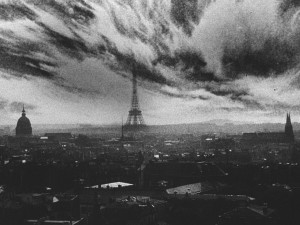
Don’t Look Now: Witches, Weird Sisters, and the Eroticism of ESP

Nicolas Roeg’s 1973 paranormal thriller Don’t Look Now, based on a Daphne du Maurier short story (and now finally released on the Criterion Collection), is one of my desert-island top 10 (probably top 5) favorite films, and it is hands down the greatest Fortean film ever made. Short of UFOs, it has everything you could ever want: premonition, synchronicity, spirit mediums, a murderous dwarf, and the hottest sex scene ever shown on film. It also makes a very interesting argument about the fatal mistake of materialist skepticism, and why it may involve a particularly male fear of female enjoyment.
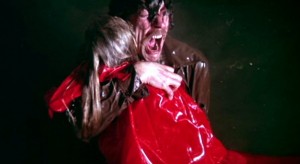 Donald Sutherland plays John Baxter, a Canadian architect working on a church restoration in Venice with his wife Laura (Julie Christie) following the death of their daughter in England some months previous. John is an adoring husband but also a hardheaded skeptic who fails to notice or acknowledge his own psychic abilities, despite having an unmistakeable premonition of his daughter’s drowning at the beginning of the movie. In Venice, a blind psychic Laura meets in a restaurant informs her that their dead daughter’s spirit is present and trying to warn John of danger. Knowing their daughter’s spirit is with them breaks Laura’s depression, but John is arrogantly dismissive and refuses to take any of it seriously.
Donald Sutherland plays John Baxter, a Canadian architect working on a church restoration in Venice with his wife Laura (Julie Christie) following the death of their daughter in England some months previous. John is an adoring husband but also a hardheaded skeptic who fails to notice or acknowledge his own psychic abilities, despite having an unmistakeable premonition of his daughter’s drowning at the beginning of the movie. In Venice, a blind psychic Laura meets in a restaurant informs her that their dead daughter’s spirit is present and trying to warn John of danger. Knowing their daughter’s spirit is with them breaks Laura’s depression, but John is arrogantly dismissive and refuses to take any of it seriously.
 [Spoiler alert: If you haven’t seen the movie, don’t read this paragraph and rent the film first; I need to discuss the twist ending because it is key to my argument.] Laura leaves Venice to visit their son in England, who has had a minor accident, but after her flight John thinks he sees her on a canal, dressed in black, accompanied by the creepy psychic and the psychic’s sister. Thinking his wife has been abducted by these strange women, he enlists the police to track the women down, even though the police are preoccupied with a much more important case: solving a series of murders that has been occurring in Venice’s maze of canals. When Laura calls him from England before returning to Venice, he is bewildered and confused. On his way to meet her when she returns to Venice that evening, he winds up chasing down a child who is wearing a red mackintosh coat like his daughter’s; this “child” turns out to be a crazy old woman, the serial killer, who fatally slashes his throat with a knife. The last scene of the film is Laura (in mourning) and the strange sisters on a boat heading to John’s funeral—the very thing John had seen earlier that day and mistaken for (present) reality.
[Spoiler alert: If you haven’t seen the movie, don’t read this paragraph and rent the film first; I need to discuss the twist ending because it is key to my argument.] Laura leaves Venice to visit their son in England, who has had a minor accident, but after her flight John thinks he sees her on a canal, dressed in black, accompanied by the creepy psychic and the psychic’s sister. Thinking his wife has been abducted by these strange women, he enlists the police to track the women down, even though the police are preoccupied with a much more important case: solving a series of murders that has been occurring in Venice’s maze of canals. When Laura calls him from England before returning to Venice, he is bewildered and confused. On his way to meet her when she returns to Venice that evening, he winds up chasing down a child who is wearing a red mackintosh coat like his daughter’s; this “child” turns out to be a crazy old woman, the serial killer, who fatally slashes his throat with a knife. The last scene of the film is Laura (in mourning) and the strange sisters on a boat heading to John’s funeral—the very thing John had seen earlier that day and mistaken for (present) reality.
Female enjoyment is something that men really, deep down, suspect doesn’t involve or require men at all.
I have been writing lately about how apparent synchronicities may arise from our ‘temporal bias,’ and failure to acknowledge the (scientifically supported, if you believe the science) presence of future traumatic information in our unconscious. No film could better illustrate this: John clearly is ‘gifted’ psychically, but he resolutely refuses to interpret his experience in anything other than straightforward temporal-causal terms, and this blindness to his own abilities (i.e., looking only in the now) has tragic results.
What is even more interesting to me about Don’t Look Now, though, is its suggestion—never explicit but ingeniously hinted at in Nic Roeg’s inimitable way—that John’s distrust of the “weird sisters” goes beyond his rational distaste for the woo they spout and involves a kind of vague sexual/homophobic paranoia. He never says it, but he clearly fears that Laura’s fascination with these menopausal mystics goes beyond them enabling her to make peace with the loss of their daughter—dimly, even unconsciously, he fears these women (are they really sisters?) have drawn his wife into some kind of lesbian coven.
Happy Mediums
 Historically and cross-culturally, spirit mediumship is often associated with females. Anthropologists have frequently focused on how channeling spirits may serve as a mode of political, sexual, and economic assertion in male-dominated worlds: A woman wants a pretty necklace, so through her an Ancestor spirit warns her husband that he better get it for her; or a woman in a traditional polygamous society is jealous of her husband’s other wife, so a possessing spirit reveals bad things about her rival; and so on. In other words, it is typically seen anthropologically as a performance through which the disempowered sex reclaims some real-world influence and asserts herself.
Historically and cross-culturally, spirit mediumship is often associated with females. Anthropologists have frequently focused on how channeling spirits may serve as a mode of political, sexual, and economic assertion in male-dominated worlds: A woman wants a pretty necklace, so through her an Ancestor spirit warns her husband that he better get it for her; or a woman in a traditional polygamous society is jealous of her husband’s other wife, so a possessing spirit reveals bad things about her rival; and so on. In other words, it is typically seen anthropologically as a performance through which the disempowered sex reclaims some real-world influence and asserts herself.
But we must not miss the sexual symbolism of receiving, being possessed—that is, entered—by a (often but not always male) spirit. Even in 19th- and 20th-century Western spiritualism and psychic research and practice, we see this: Helena Blavatsky and her female followers in the Theosophy movement channeled Ascended Masters (what a euphemism!) as well as ancient alien entities (although so did the famously bisexual Aleister Crowley). By the same token, male shamans often go forth from their bodies and enter other worlds, other minds, and so on. Many of the male leading lights in remote viewing connected their ability to gain information psychically with the ability to leave their bodies; the master teacher and pioneer of the method, Ingo Swann, wrote a bizarre, probably fictitious memoir called Penetration for example; and true to the gender dichotomy, one of the first women in the Star Gate remote viewing program scandalized her doubtful male colleagues by using channeling instead of the more orthodox approach.
 When Laura joins the spinsters in their hotel room and the psychic channels the dead daughter, there is something unmistakeably erotic about the scene, and it reveals just what it is that has always invited the (male) hatred and fear of witches. The heresy of witchcraft isn’t any more about truck with the devil than “riding broomsticks” is about transportation; it’s really about female sexuality and female enjoyment (both sexual and nonsexual), the most fearsome (and fascinating) thing imaginable in the eyes of men.
When Laura joins the spinsters in their hotel room and the psychic channels the dead daughter, there is something unmistakeably erotic about the scene, and it reveals just what it is that has always invited the (male) hatred and fear of witches. The heresy of witchcraft isn’t any more about truck with the devil than “riding broomsticks” is about transportation; it’s really about female sexuality and female enjoyment (both sexual and nonsexual), the most fearsome (and fascinating) thing imaginable in the eyes of men.
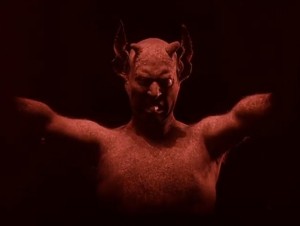 Danish director Benjamin Christensen veered close to the sexual dimensions of witchcraft-fear in his wonderful 1922 documentary Haxan: Witchcraft through the Ages (which I first saw at a 1999 Edinburgh horror film festival in a sublime double bill with another of my desert island top 5 films, The Wicker Man). Drawing on the then-current theories of Freud, Christensen linked witchcraft to hysteria and the libidinal dysfunctions and misdirections that beset females in repressive European society, as well as to the ignorant credulity of elderly widows and spinsters. A masterful early documentary that incorporates entertaining reenactments, Haxan manages to treat the subject intelligently and seriously but also have a sense of humor about it. The director himself appears as the devil, flicking his tongue seductively at his victims, including a troubled sleepwalking nun; the frenzied madness that takes over a convent after the nun defiles the chapel is alone worth the price of admission.
Danish director Benjamin Christensen veered close to the sexual dimensions of witchcraft-fear in his wonderful 1922 documentary Haxan: Witchcraft through the Ages (which I first saw at a 1999 Edinburgh horror film festival in a sublime double bill with another of my desert island top 5 films, The Wicker Man). Drawing on the then-current theories of Freud, Christensen linked witchcraft to hysteria and the libidinal dysfunctions and misdirections that beset females in repressive European society, as well as to the ignorant credulity of elderly widows and spinsters. A masterful early documentary that incorporates entertaining reenactments, Haxan manages to treat the subject intelligently and seriously but also have a sense of humor about it. The director himself appears as the devil, flicking his tongue seductively at his victims, including a troubled sleepwalking nun; the frenzied madness that takes over a convent after the nun defiles the chapel is alone worth the price of admission.
 The theme of nuns driven to sexual madness is of course a titillating theme explored in countless nunsploitation (and, I’m sure, porn) films since then. Female enjoyment is something that men really, deep down, suspect doesn’t involve or require men at all and may not even require sex. It is somehow huger and deeper than anything men can fathom or experience, which is both exciting and terrifying. It was intense male fear of (and inability to countenance their own titillation at) women’s solitary and collective sexual enjoyment that got wayward nuns, lonely spinsters, and lesbians burned at the stake during the Middle Ages; their theological transgressions were smokescreen for what was really an issue of sexual fear.
The theme of nuns driven to sexual madness is of course a titillating theme explored in countless nunsploitation (and, I’m sure, porn) films since then. Female enjoyment is something that men really, deep down, suspect doesn’t involve or require men at all and may not even require sex. It is somehow huger and deeper than anything men can fathom or experience, which is both exciting and terrifying. It was intense male fear of (and inability to countenance their own titillation at) women’s solitary and collective sexual enjoyment that got wayward nuns, lonely spinsters, and lesbians burned at the stake during the Middle Ages; their theological transgressions were smokescreen for what was really an issue of sexual fear.
Stolen Enjoyment
A basic theme of Lacanian psychoanalysis is that we go through our adult lives unconsciously haunted by a bliss/enjoyment that we dimly remember and feel we lost or had stolen from us when we entered the Symbolic and Imaginary dimensions of civilized life as toddlers—the loss symbolized as “castration.” The notion that that bliss-enjoyment exists out there in the external world, in the possession of some other, is the principle fantasy underlying all forms of sexism, racism, and homophobia: The sexual or ethnic other always somehow enjoys more than we do, and we hate it.
John’s confusion, as he rushes through the maze-like alleys of Venice in search of his ‘abducted’ wife, is a perfect metaphor for the materialist’s confused disavowal of cosmic meaning and psychical bliss.
In actual fact, though, we are the ones suppressing this primordial bliss in ourselves by misattributing it to others. This confusion, or what Žižek would call “perspective mistake”—mistaking our own enjoyment as the property of the other—causes enjoyment to have an anamorphic quality: The farther away we localize it, the huger it seems to be, just like in the “dolly zoom” special effect first used in Vertigo, although in reverse: By shortening the depth of field (zooming in) during a reverse tracking shot, an object appears to terrifyingly grow in size as it becomes more distant, because it fills the same area in the frame but flattens out against its background like things seen through a telescope.
According to this logic, bliss assumes an enormity in the other to the degree we disavow it in ourselves, and this enormity causes us anguish and pain in equal proportion. Thus the French term “jouissance”—connoting pleasure in pain or painful pleasure—has a deeply ambivalent or equivocal meaning in the writings of Lacanians like Žižek. For Žižek, jouissance, usually translated as enjoyment, more often means horror and disgust than it does anything actually enjoyable or pleasurable. But this really represents the fundamental pathology that materialists, who are stereotypically male, suffer from. Historically, men’s distrust of female enjoyment is really an alienated reaction to their own disavowed bliss-enjoyment, and this manifests as a distrust of that enjoyment’s alternative channels, such as the mystical and paranormal. It is (stereotypically) women who have always been more open to that stuff.
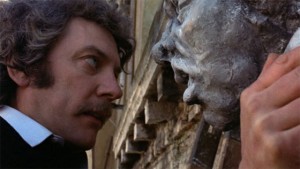 John is an architect who can only see the old church he is restoring in physical terms. While focusing on the material minutiae—matching tiny tiles to a mosaic on a high wall—he is nearly killed when the platform he is standing on collapses. In another church, he impatiently expresses scorn when Laura lights candles and prays. Later his confusion, as he rushes through the maze-like alleys of Venice in search of his ‘abducted’ wife, is a perfect metaphor for the materialist’s confused disavowal of cosmic meaning, so long as we recognize that ‘meaning’ always really boils down to the bliss that is the secret substance of the universe that is already our own possession if we only acknowledge it.
John is an architect who can only see the old church he is restoring in physical terms. While focusing on the material minutiae—matching tiny tiles to a mosaic on a high wall—he is nearly killed when the platform he is standing on collapses. In another church, he impatiently expresses scorn when Laura lights candles and prays. Later his confusion, as he rushes through the maze-like alleys of Venice in search of his ‘abducted’ wife, is a perfect metaphor for the materialist’s confused disavowal of cosmic meaning, so long as we recognize that ‘meaning’ always really boils down to the bliss that is the secret substance of the universe that is already our own possession if we only acknowledge it.
Unable to even imagine that he himself is a carrier of that mystical/psychical bliss, the only place John can localize it is in the menopausal mystics he suspects of abducting his wife. This mistake costs him his life.
Coincidence, Chaos, & Archetypes in Our Science-Fictional World
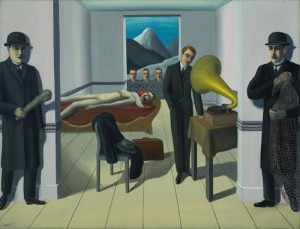
You don’t have to be a hardheaded materialist skeptic or an atheist to be troubled by the idea of synchronicity. The fundamental mystery—or really, outrage—of synchronicities is they seem arranged, stage managed, in a way that is impossible without imagining an active higher intelligence taking interest in guiding us and arranging the events of the wider world to produce unmistakeably uncanny outcomes. Even if we believe in God, many people aren’t comfortable living in a world of miracles and signs.
This was the problem faced by Philip K. Dick, whose Christianity couldn’t countenance fully divine meddling in his psyche and life. The story had to be more complex and also more rational. Hence, he tended to think that the synchronicities he experienced in 1974 reflected his own enlarged self haunting him from an orthogonal dimension of time, perpendicular to the four spacetime dimensions we ordinarily experience.
Consciously being open to coincidence but failing to recognize our own role in creating significant moments, we inevitably imagine a Higher Knower. But this is a mistake.
My last post sparked an interesting discussion in the comments about the apparent role of coincidence in synchronicities if they are really, as I argued, cases of misrecognized precognition or premonition. For instance, even if Jung’s famous scarab arriving at the window of his office was a purely random event that his patient had dreamed about the night before, there is still a coincidental element to it: Why a scarab, which has an archetypal meaning connected to the patient’s therapeutic situation, as opposed to some other insect?
Here’s where I think we really need to take seriously the revised picture of time that Dick grappled with through his 8-year frenetic journaling in his Exegesis: What is the connection between the archetypal world and the multidimensional nature of time? In a Eureka moment (not unlike the hundreds recorded by the manic Dick), I think I figured it out: Archetypes are an illusory effect produced by our failure to recognize self-confirmatory actions (feedback loops) made possible by the looping nature of time. Temporal feedback loops amplify the personal significance of symbolic formations, which (because we fail to recognize psi) appear as somehow objective or external to us.
 For reasons I discussed in my Psi of Regret post, most information from the future should be negated by one’s own and others’ willed actions; but in a minority of cases, a self-confirming feedback effect could arise which would actually intensify or amplify the significance of the stimulating event in the future. This would happen specifically when that event involves a minor random coincidence (which are myriad) and/or fulfills some kind of unconscious thought or desire we had harbored.
For reasons I discussed in my Psi of Regret post, most information from the future should be negated by one’s own and others’ willed actions; but in a minority of cases, a self-confirming feedback effect could arise which would actually intensify or amplify the significance of the stimulating event in the future. This would happen specifically when that event involves a minor random coincidence (which are myriad) and/or fulfills some kind of unconscious thought or desire we had harbored.
Through this time-loop mechanism, minor coincidences, when they resonate with our own personal meanings and priorities, can be the nuclei of major significant moments (synchronicities) as well as meta-symbols (archetypes). Small coincidences, in other words, may be like grains of sand around which time’s oyster builds Platonic-Jungian pearls.
Bootstrapping Ourselves Toward Meaning
The idea of information from the future reaching us in the present should be unproblematic to parapsychologists and Forteans, yet we still tend to think of it somehow as a very special case. But if we grant the experimental results of Daryl Bem and Dean Radin and the observations of J.W. Dunne and others, then information must indeed be constantly rippling backwards in the time stream; this would have to produce all the paradoxical effects familiar from time travel stories in science fiction: doubling or multiplication or intensification of information (not unlike what happens in the interesting 2004 sci-fi film Primer), as well as self-cancelling effects such as I discussed in the context of Dune Messiah, and perhaps even wholesale self-negation (the famous grandfather paradox). If I am right about the future not being etched in stone (or glass, as in the Minkowski glass football)—that is, as subject to free will—then precognitive material cannot be about what is definitely going to happen but about what is probabilistic, and much of that information will be rendered inaccurate by our willed actions, and thus we would have no way of knowing it (i.e., because it didn’t come true or wasn’t close enough to how events unfolded to be discernible). It wouldn’t even be information, just noise.
Instead of our future selves meddling in the past, our unconscious minds are constantly receiving and reacting to future information without knowing it comes from the future.
However, in special circumstances, for instance when there is a slight perceived (and random) coincidence, such as between a specific genus of insect and the theme of therapeutic rebirth, it could instead have the effect of entraining our actions to the signal, in turn amplifying the felt significance of the signal into the past, generating a precognitive or premonitory experience which in turn feeds forward to intensify the uncanniness of the stimulating event, in turn boosting the signal into the past, and so on … The result would be an informatic/emotional time-loop feedback effect centered on what emerges as a truly uncanny, meaningful, and even decisive coincidence (the ’synchronicity’) that could even alter the course of a person’s life in a significant fashion going forward.
Within Jung’s larger and less radical paradigm of “individuation,” the unconscious is ever seeking out opportunities to progress and develop and change toward wholeness, and its capitalization on significant coincidences provides a way for the individual to bootstrap him/herself toward integration. The unconscious has no sense of time, so it doesn’t recognize this operation of atemporal time-looping—that is, the artificiality of the apparent coincidence (i.e., the fact that the person him/herself created the apparent coincidence through his/her actions and attributed it to objective external reality). The tendency of ‘synchronistic’ events to have a recursive, fractal, or self-similar quality, in some way being ‘about’ the whole notion of synchronicity or coincidence, reflects the tendency of the coincidence-receptive person to be attuned to coincidences in the first place. It is, quite literally, self-fulfilling prophecy.
Jung and Plato Must Die (that Psi May Live)
Thus the kinds of events that spark an emotional ripple into the past will be ones that support the ‘prophetic enjoyment’ I mentioned in the last post: Synchronicities are self-confirming effects produced by misrecognized precognition within an overall attitude of receptivity to mystery, magic, and meaningful coincidence. Belief in synchronicity produces synchronicity, which further reinforces the belief. In a larger sense, this mechanism may underlie the “law of attraction” in all its forms. It really is just like the “strange attractor” in Chaos Theory (and which is also identical to what Lacan and Žižek call the “symptom”).
 What this suggests—and this is my Eureka—is that “archetypes” as such—as well as the Platonic world of “forms” that Dick suggested was the “fifth dimension” (printing out archetypes on the paper of history as on an IBM Selectric typewriter)—are really an illusory or anamorphic effect produced by not seeing or recognizing these self-confirmatory time loops, these informational/emotional eddies in the spacetime continuum, and failing to see our own role in feeding them through our perceptions and actions. We ourselves make meaning, including the intensified meaningful nuclei in the collective unconscious that so fascinated Jung and that formed the centerpiece of Platonic metaphysics.
What this suggests—and this is my Eureka—is that “archetypes” as such—as well as the Platonic world of “forms” that Dick suggested was the “fifth dimension” (printing out archetypes on the paper of history as on an IBM Selectric typewriter)—are really an illusory or anamorphic effect produced by not seeing or recognizing these self-confirmatory time loops, these informational/emotional eddies in the spacetime continuum, and failing to see our own role in feeding them through our perceptions and actions. We ourselves make meaning, including the intensified meaningful nuclei in the collective unconscious that so fascinated Jung and that formed the centerpiece of Platonic metaphysics.
At times, Dick came close to saying this: He suggested that synchronicities occur because we in the future are time traveling, cultivating our own development; that our own enlarged consciousess has the power to “stage manage” not because it is a white-bearded deity sitting up in a cloud reaching down and playing with us like chess pieces, but because of the nature of time itself. Coincidences may be the product of time tampering, our own time tampering in the future.
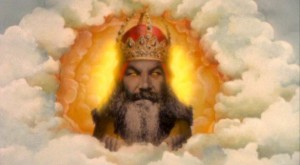 Where I’m departing from this notion is in emphasizing misrecognition and the role of the unconscious: Instead of our future (conscious) selves meddling in the past, our unconscious minds are constantly receiving and reacting to future information without knowing it comes from the future; through our actions, we thus sometimes confirm this information, particularly when it resonates with our priorities and unconscious beliefs about meaning or our own significance in the bigger cosmic picture. That sort of information will act as an ‘attractor’ in the Chaos Theory sense and give rise to the illusion of BIG coincidences and the meta-symbols that are necessary (in Jungian thinking) to make sense of them.
Where I’m departing from this notion is in emphasizing misrecognition and the role of the unconscious: Instead of our future (conscious) selves meddling in the past, our unconscious minds are constantly receiving and reacting to future information without knowing it comes from the future; through our actions, we thus sometimes confirm this information, particularly when it resonates with our priorities and unconscious beliefs about meaning or our own significance in the bigger cosmic picture. That sort of information will act as an ‘attractor’ in the Chaos Theory sense and give rise to the illusion of BIG coincidences and the meta-symbols that are necessary (in Jungian thinking) to make sense of them.
We live in a world that curves and bifurcates and loops back on itself, and these loopings and crossings and doublings and cancellations exert a shaping force on our lives and larger events via what we call psi, but we (a) think linearly and do not believe in time travel, (b) generally disbelieve in psi, and (c) fail to include the knower in the known even when we do believe in those possibilities. Consciously being open to coincidence and ‘larger meaning’ but failing to recognize our own role in creating significant moments, we inevitably imagine a Higher Knower who recognizes and certifies these eternal forms or archetypes, stage-managing these amazing occurrences as signals or signposts for us. But this is a mistake.
I’m suggesting we kill both Jung and Plato here in one stroke … maybe even God. Not only synchronicities but also archetypes and Ideal Forms are illusions caused by our failure to recognize the truly science-fictional way that informational-emotional time loops may intensify the potency of confluent events and symbols in our lives, and the role we ourselves play in the process.
We live in a science-fictional universe. To move forward, we need to recognize that fact.

